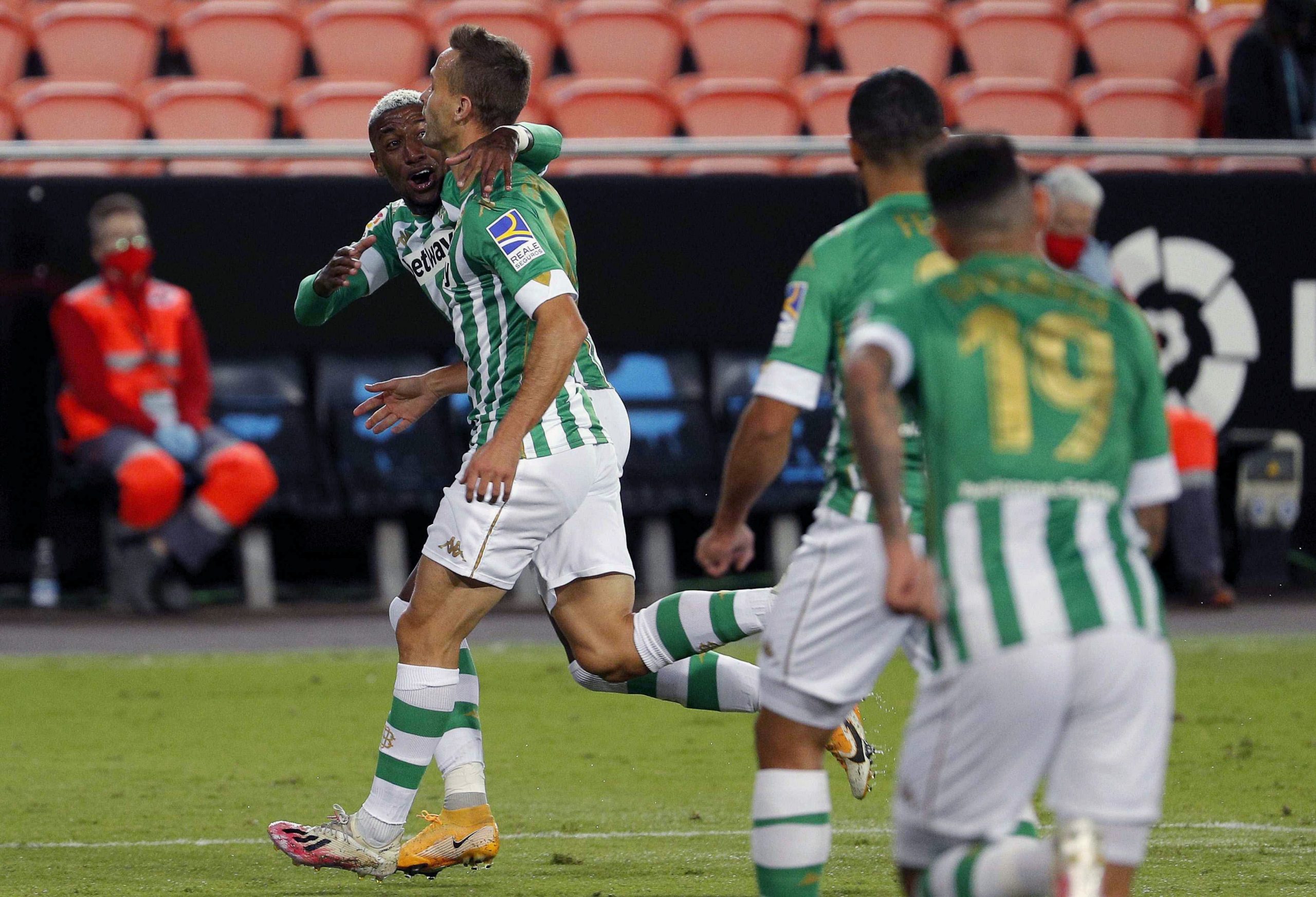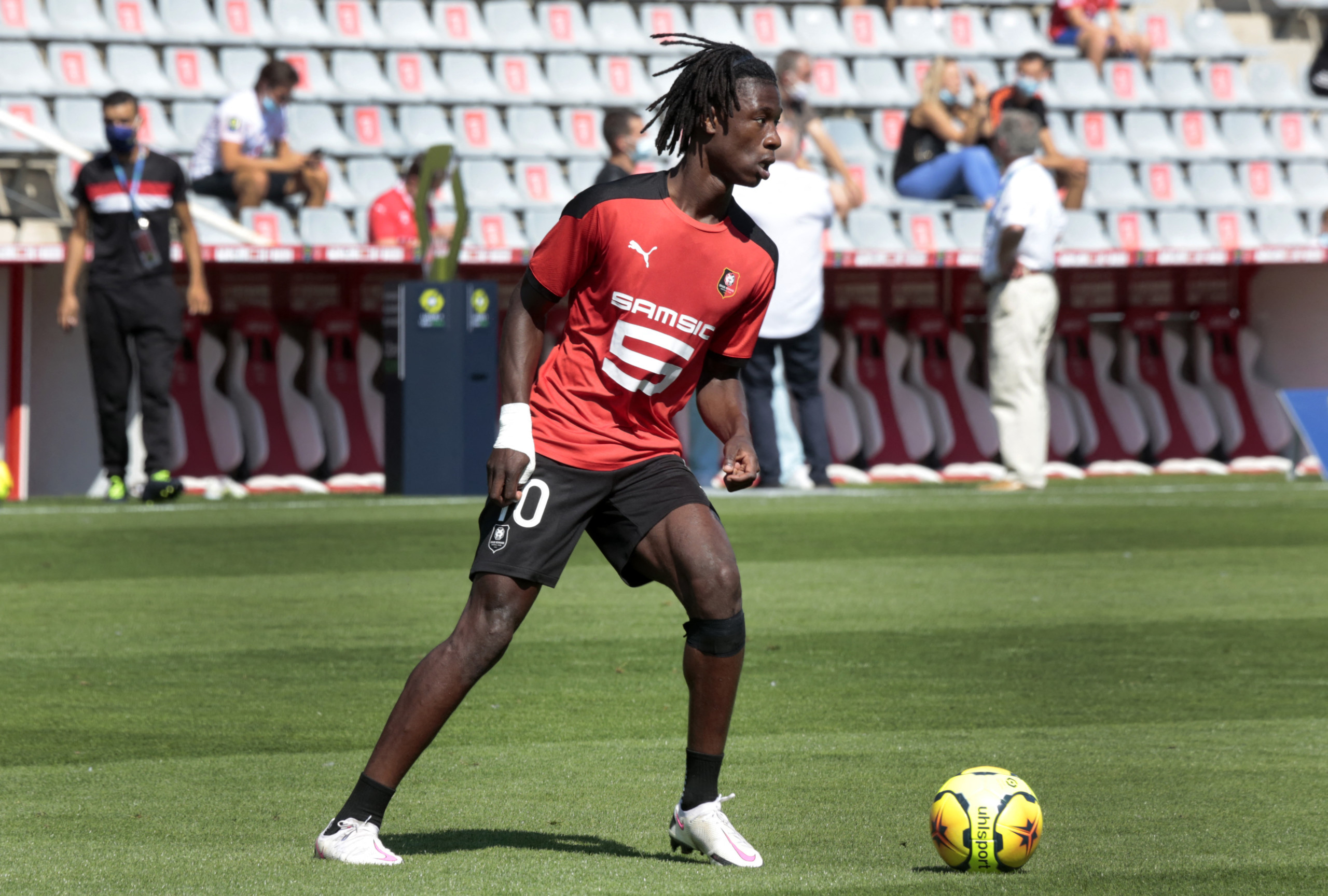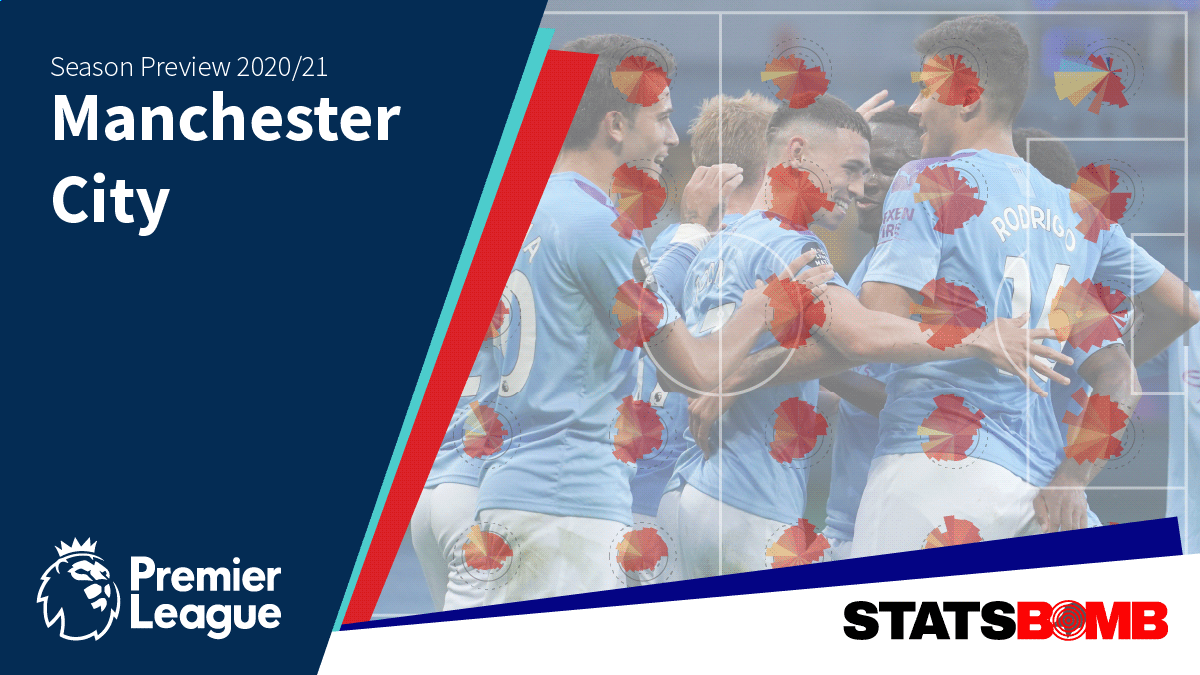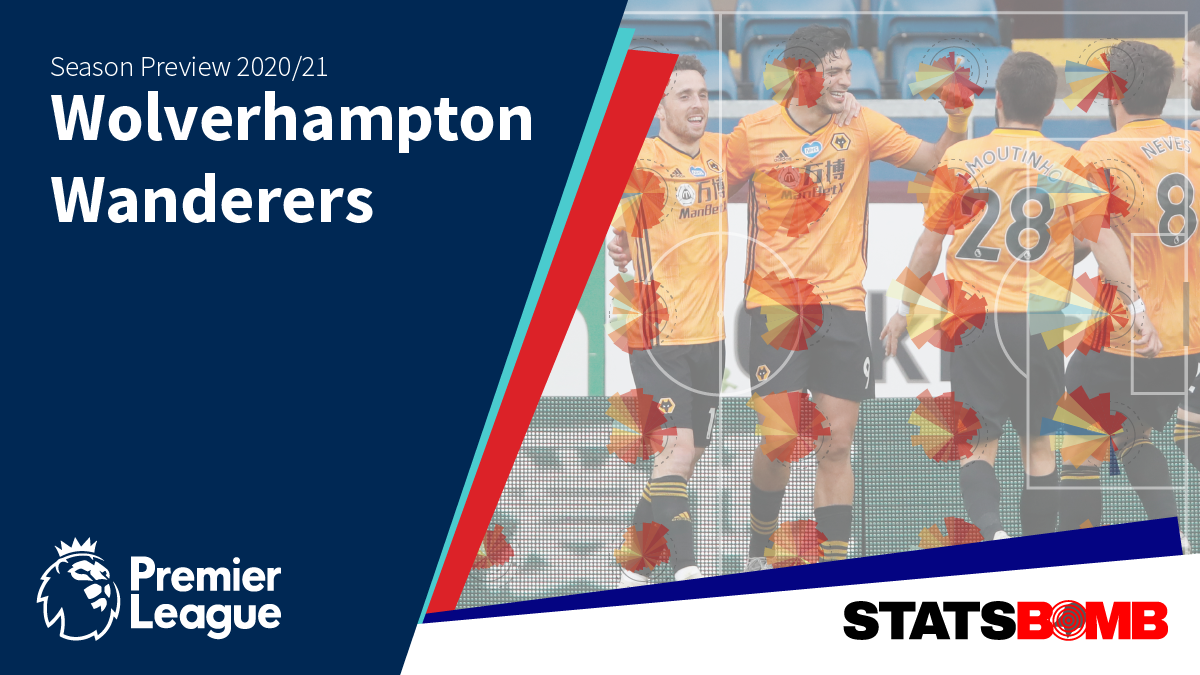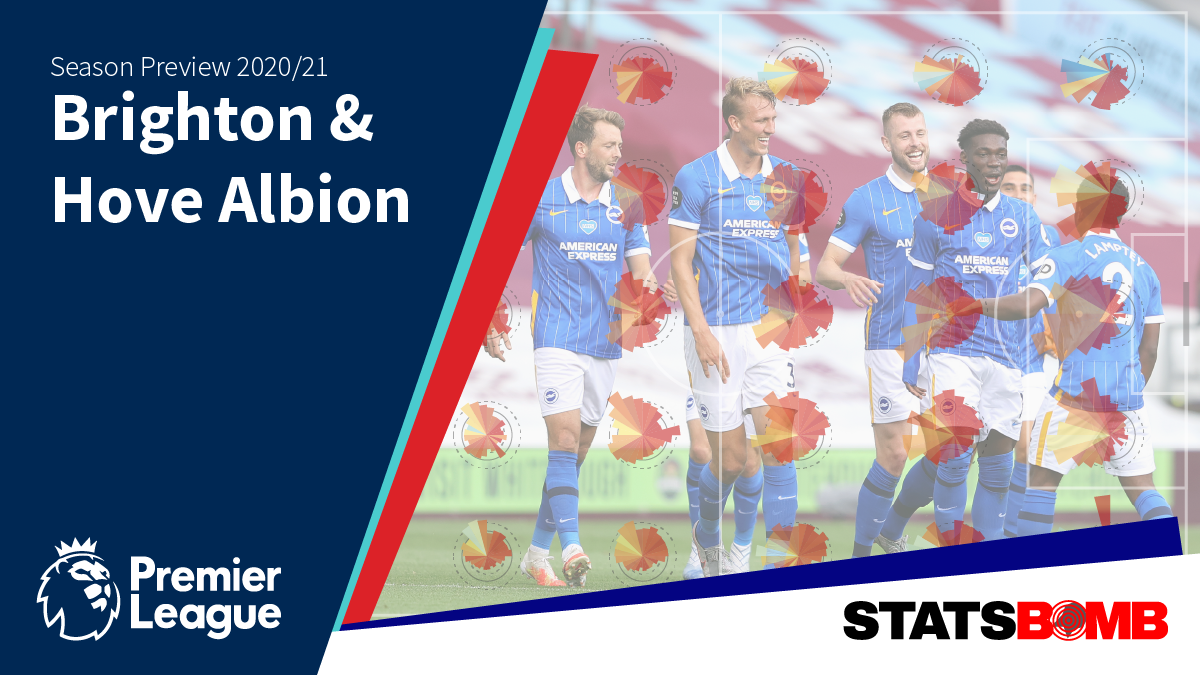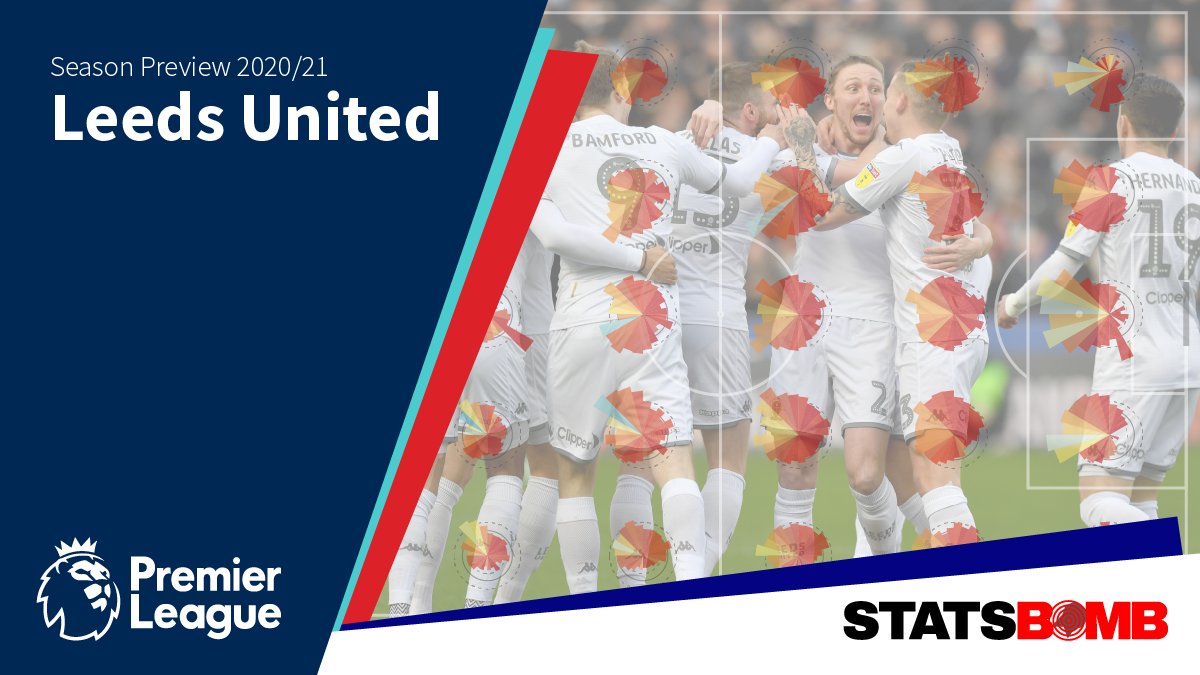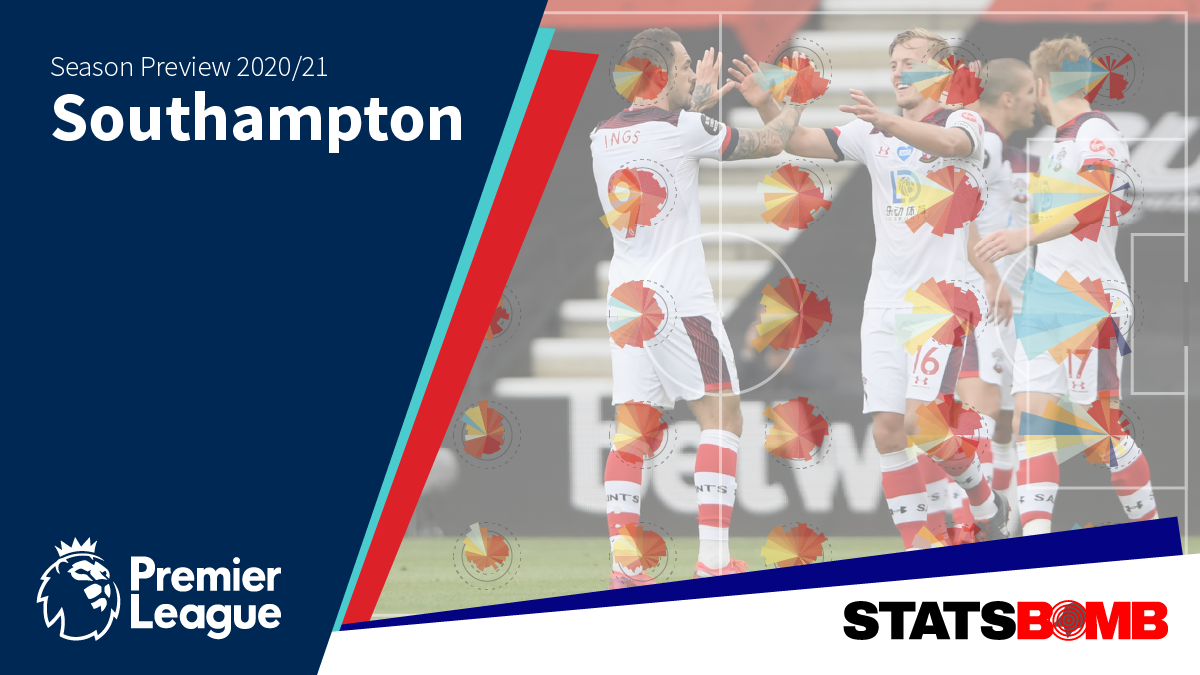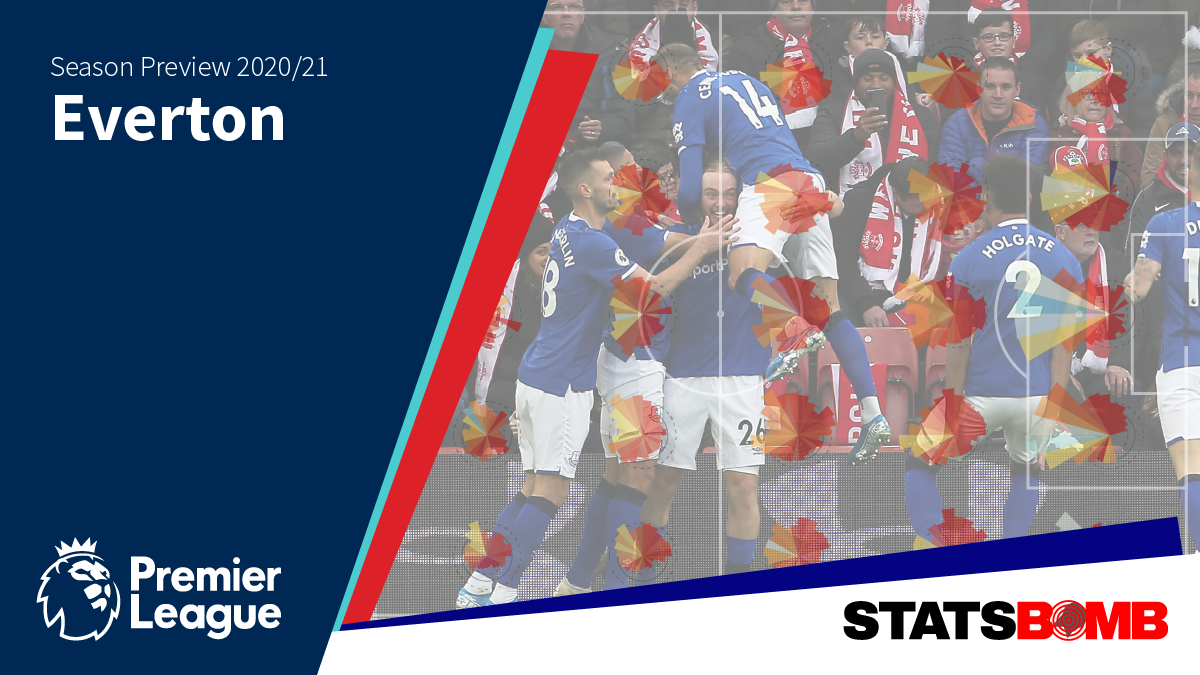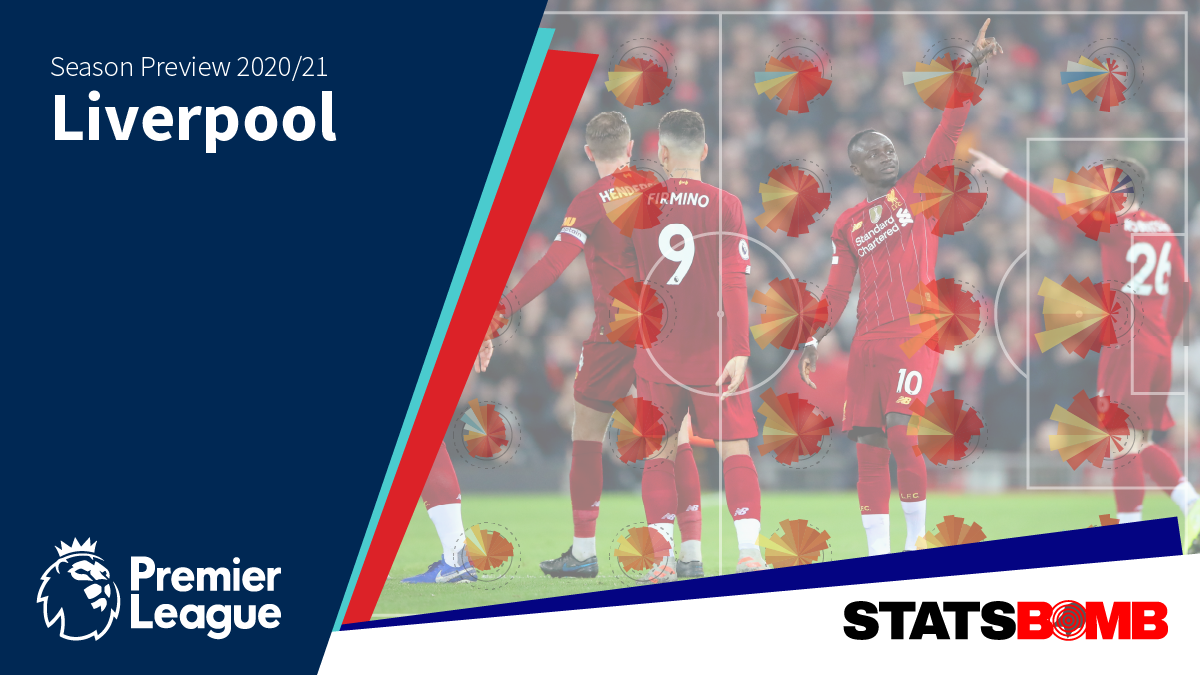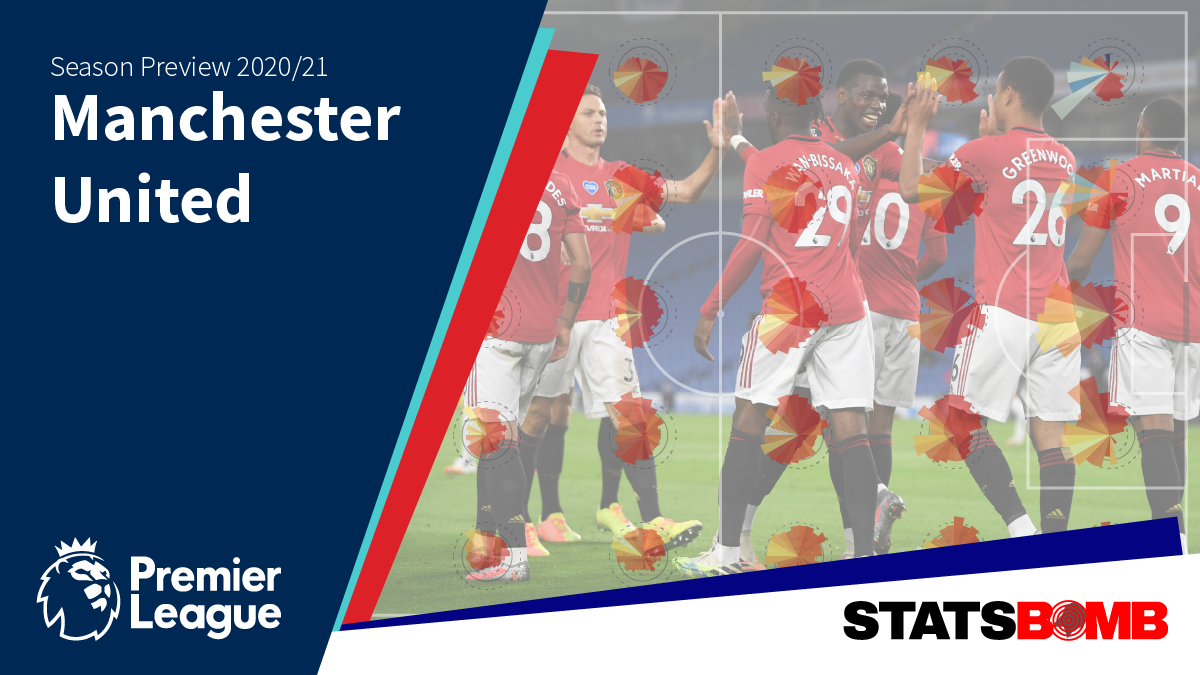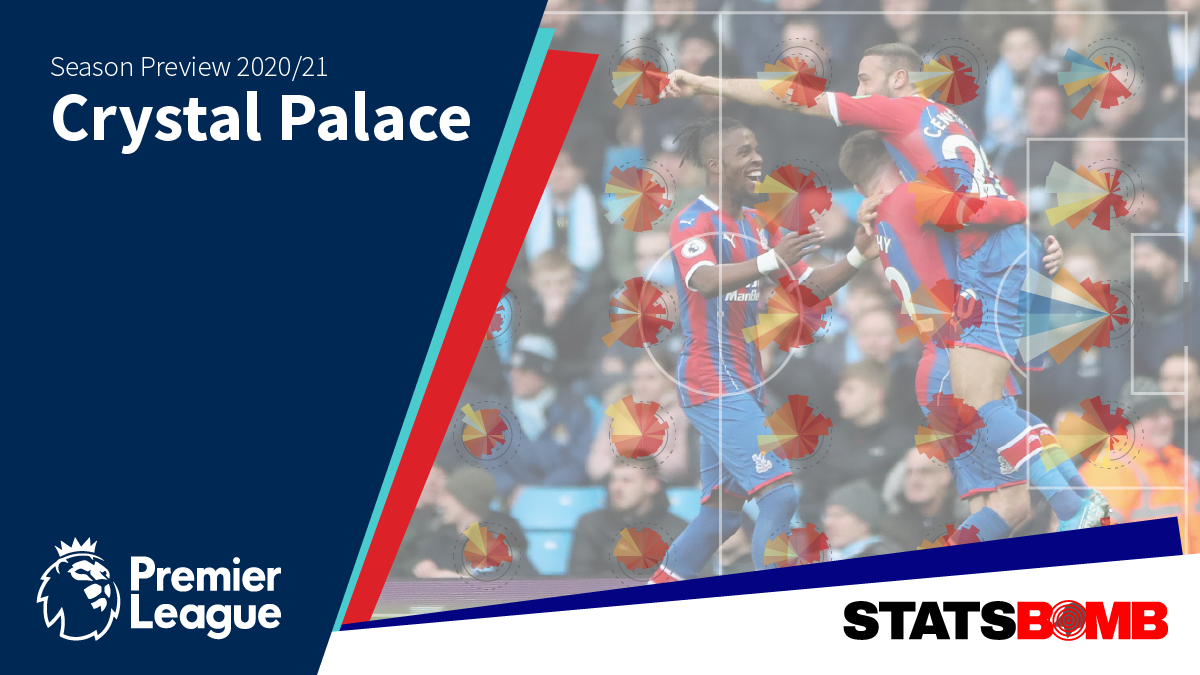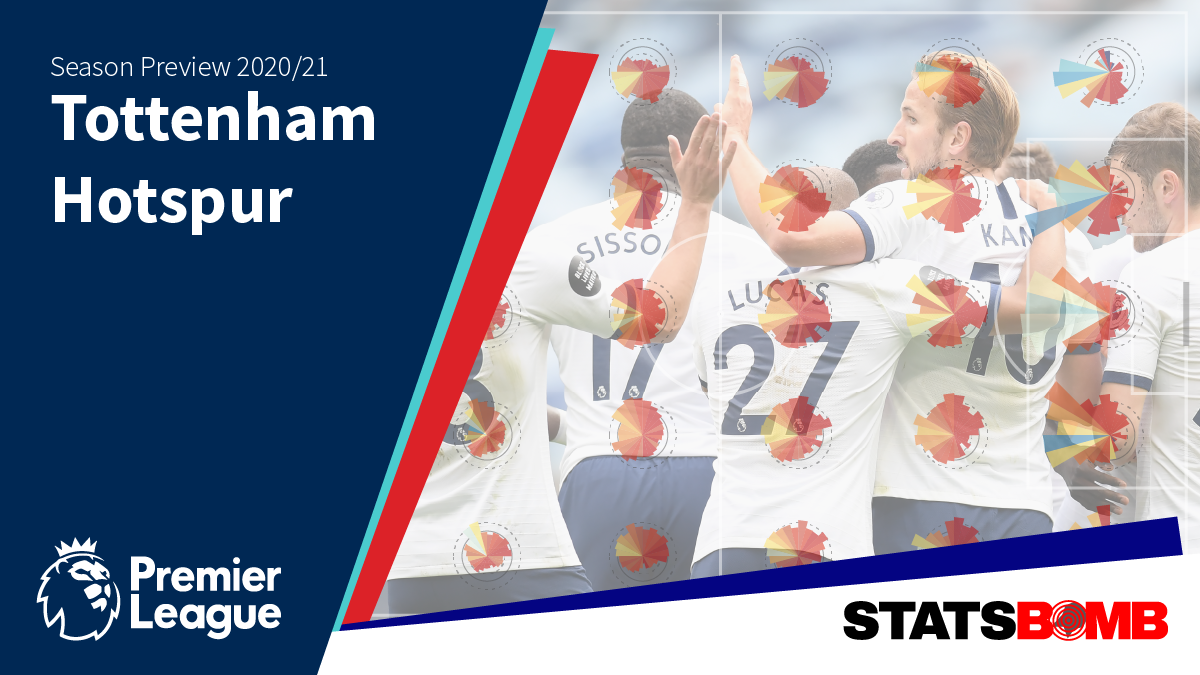We are five matchdays into the season in La Liga, so let’s have a look at some emerging trends from the early action. Spain Remains Light on Shots La Liga saw the least shots, goals and expected goals (xG) of any big five European league last season, and things have been even tighter in the early running of the new campaign. All three measures are down. While the English, Italian and German top flights have each averaged over three non-penalty goals per match, Spain has averaged just two, right in line with xG. There have been three less shots per match (20.30) than in any of the other leagues. Even in the context of a competition that remains steadfastly low on goalmouth action, Athletic Club stand out as a particularly bad watch. Their matches to date have barely averaged over a single expected goal and have featured the lowest shot count (15.25) of any in the league. A Promising Start for Betis Real Betis always looked like one of the prime candidates to move up the table this season. Their 15th place finish last time around was allied to top eight metrics, and the attacking talent within the squad is such that even a minor defensive improvement, whether through luck or judgement, was always going to make them top eight contenders. Nine points from their first five matches under Manuel Pellegrini represents a good start and has them second in the nascent table, albeit with at least two or three teams behind who will probably better their points haul once games in hand have been played. Even with defeats to Real Madrid and Getafe thrown into the mix, Betis have begun the campaign as a shot dominant team, outshooting their opponents in all of their matches and taking 64% of the total shots across those fixtures. It is a good starting point, but the difference between the quality of shots taken and conceded means they still have a negative expected goal difference at this stage. They are taking a few too many speculative efforts in attack... 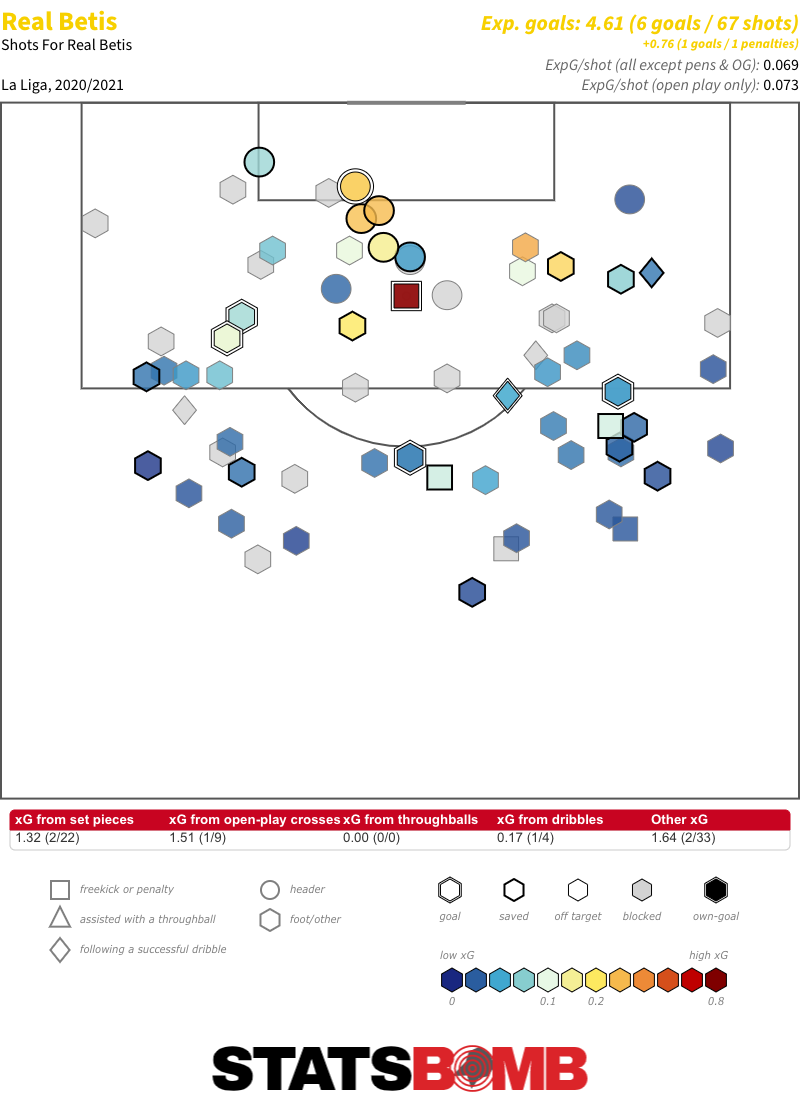 ...and while their higher defensive line and slightly more aggressive off-ball approach has so far done a solid job of suppressing opposition shot volume, the chances they have conceded have generally been high-quality ones.
...and while their higher defensive line and slightly more aggressive off-ball approach has so far done a solid job of suppressing opposition shot volume, the chances they have conceded have generally been high-quality ones. 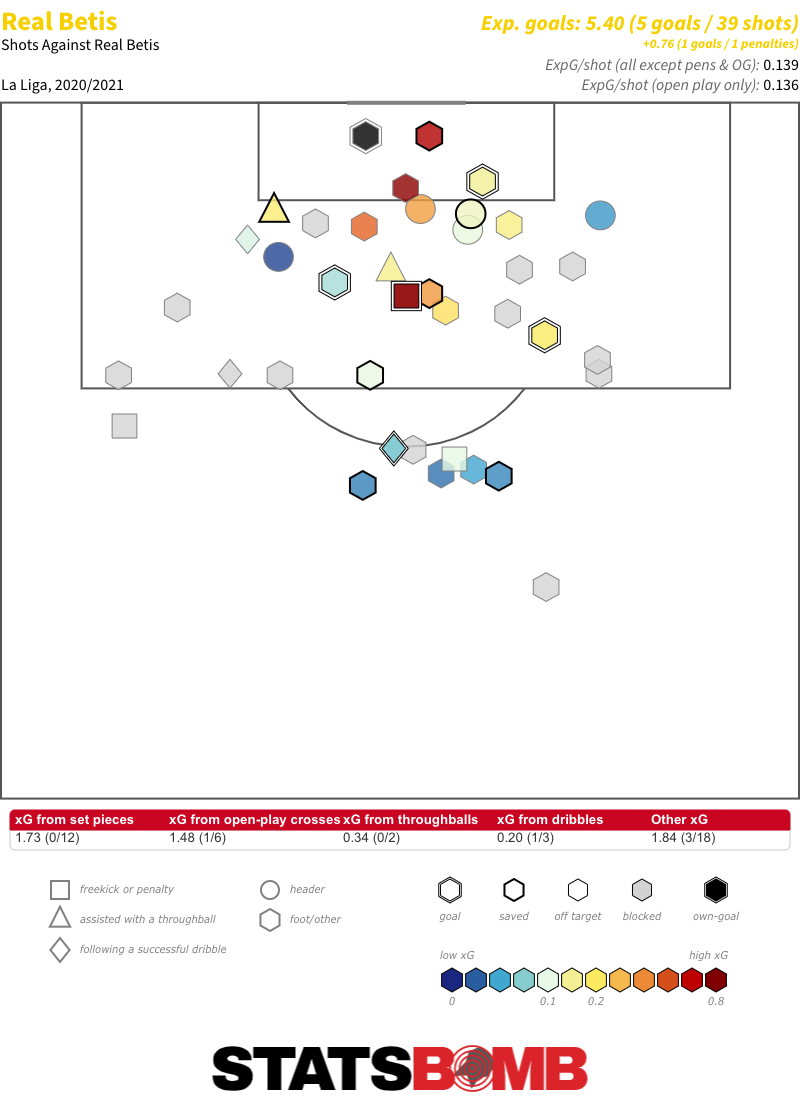 With that said, they have already played Real Madrid, which skews things in such a small sample size. It is also unlikely those shot quality numbers will hold throughout the campaign given that they would have been comfortably the worst in La Liga at both ends of the pitch last season. As things begin to equalise out a bit, we’ll have a better idea if Betis are genuine European contenders. Underpowered Elche Elche have only played three times to date, and do already have four points on the board, but they’ve looked decidedly underpowered on their return to the top flight following a five-year absence. Unsurprisingly so, given that they weren’t even a standout side in the Segunda División last season. They made it up through the playoffs after finishing sixth in the table with bottom six metrics. Add to that a new head coach and the ridiculously short period of time they had to prepare for the top flight due to the delayed promotion playoffs, and it is to be expected that they've looked out of their depth. Jorge Almirón’s side have averaged a pitiful four shots per match while conceding more than 18. They were outshot 27 to five by Real Sociedad in their opener, and then 18 to two by fellow newly promoted side Huesca in a 0-0 draw prior to the international break.
With that said, they have already played Real Madrid, which skews things in such a small sample size. It is also unlikely those shot quality numbers will hold throughout the campaign given that they would have been comfortably the worst in La Liga at both ends of the pitch last season. As things begin to equalise out a bit, we’ll have a better idea if Betis are genuine European contenders. Underpowered Elche Elche have only played three times to date, and do already have four points on the board, but they’ve looked decidedly underpowered on their return to the top flight following a five-year absence. Unsurprisingly so, given that they weren’t even a standout side in the Segunda División last season. They made it up through the playoffs after finishing sixth in the table with bottom six metrics. Add to that a new head coach and the ridiculously short period of time they had to prepare for the top flight due to the delayed promotion playoffs, and it is to be expected that they've looked out of their depth. Jorge Almirón’s side have averaged a pitiful four shots per match while conceding more than 18. They were outshot 27 to five by Real Sociedad in their opener, and then 18 to two by fellow newly promoted side Huesca in a 0-0 draw prior to the international break. 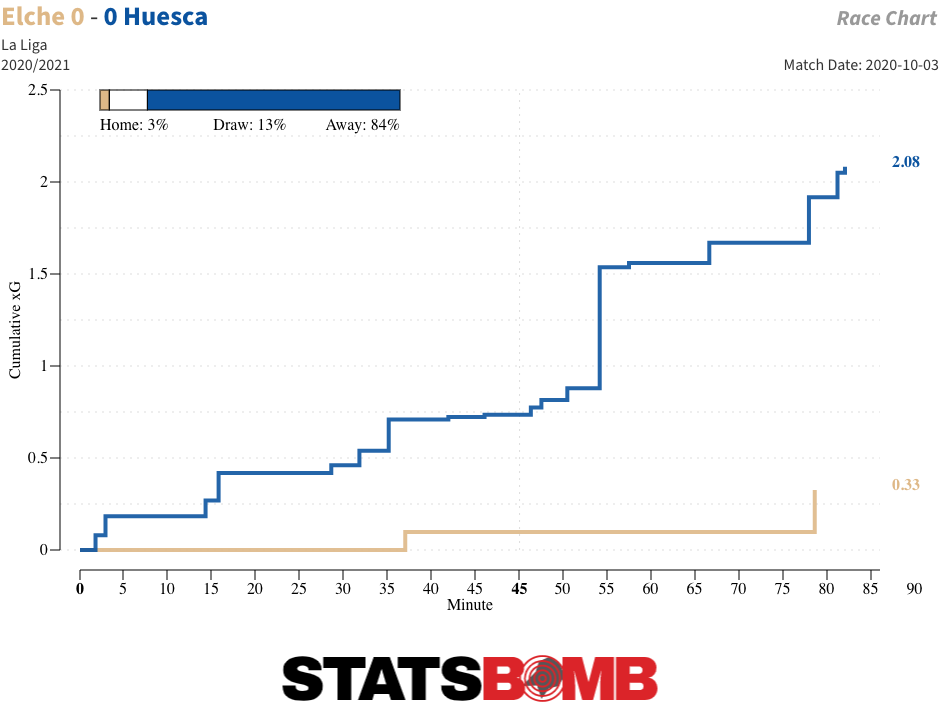 The squad has been reinforced with a flurry of late deals, no one can take the points they’ve already got away from them, and their shot numbers will naturally smooth out a little over time. But performances will have to improve massively if Elche are to have any chance of remaining in the division. New Arrivals Doing Their Thing David Silva may only have started three of Real Sociedad’s five matches to date, but he still leads the league in total open play passes into the penalty area. On a per-90 basis, he ranked in the top four of the Premier League in that metric for Manchester City in each of the last four seasons, and it seems he will again be amongst the most prolific suppliers in La Liga.
The squad has been reinforced with a flurry of late deals, no one can take the points they’ve already got away from them, and their shot numbers will naturally smooth out a little over time. But performances will have to improve massively if Elche are to have any chance of remaining in the division. New Arrivals Doing Their Thing David Silva may only have started three of Real Sociedad’s five matches to date, but he still leads the league in total open play passes into the penalty area. On a per-90 basis, he ranked in the top four of the Premier League in that metric for Manchester City in each of the last four seasons, and it seems he will again be amongst the most prolific suppliers in La Liga. 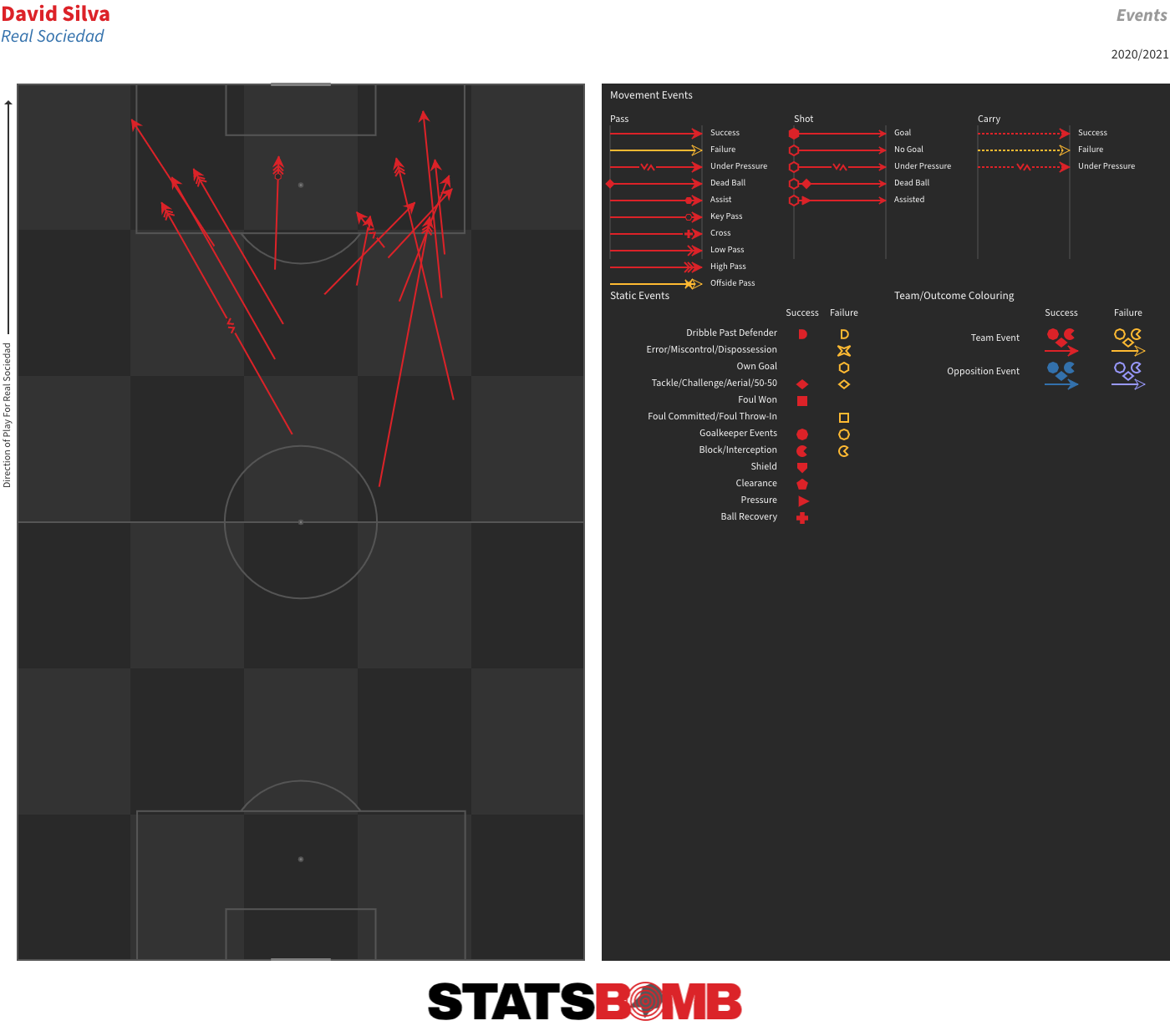 Dani Parejo may not have any goals or assists to his name since his off-season move from Valencia to Villarreal, but he’s continued to be the same reliable ball progresser as always.
Dani Parejo may not have any goals or assists to his name since his off-season move from Valencia to Villarreal, but he’s continued to be the same reliable ball progresser as always. 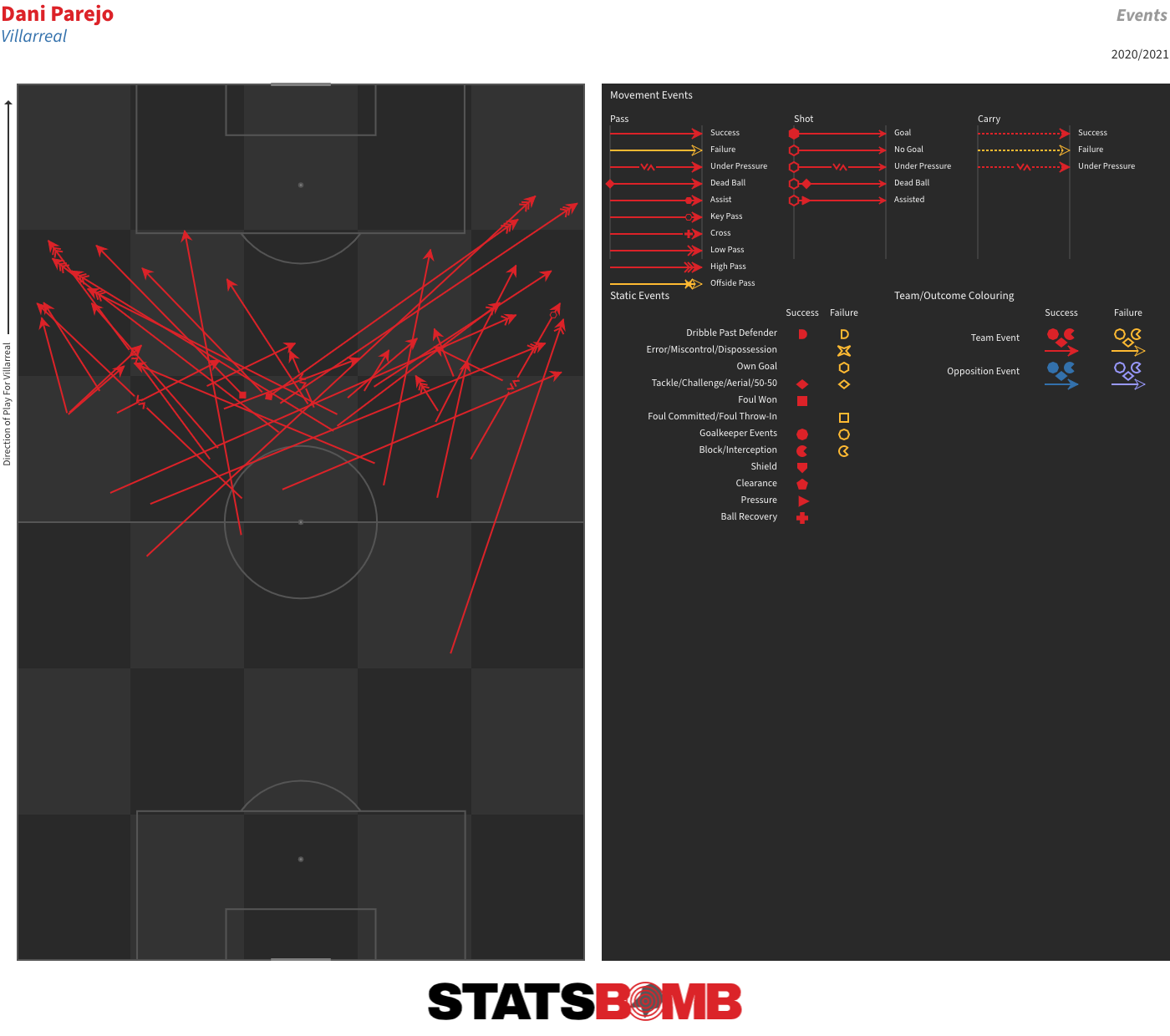 Emre Mor is back at Celta Vigo, and even if he hasn't done much else, he continues to be a prolific dribbler.
Emre Mor is back at Celta Vigo, and even if he hasn't done much else, he continues to be a prolific dribbler. 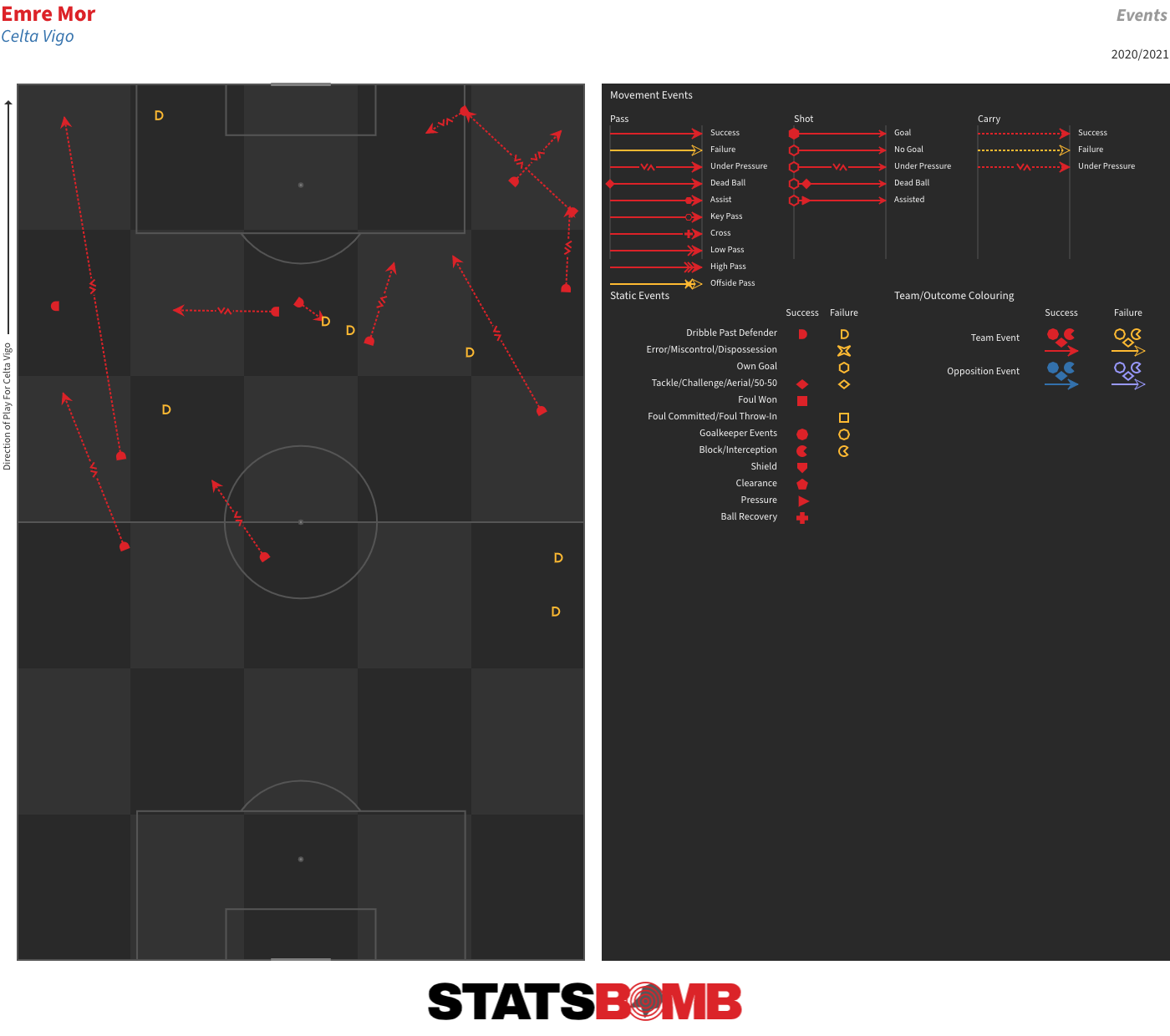 And Javi Ontiveros may have only seen a combined 90 minutes or so of action for Huesca after joining on loan from Villarreal, but the player who last season took more shots per 90 amongst players who saw at least 900 minutes of action than anyone but Lionel Messi has already got off four efforts on goal -- just below his 2019-20 average.
And Javi Ontiveros may have only seen a combined 90 minutes or so of action for Huesca after joining on loan from Villarreal, but the player who last season took more shots per 90 amongst players who saw at least 900 minutes of action than anyone but Lionel Messi has already got off four efforts on goal -- just below his 2019-20 average. 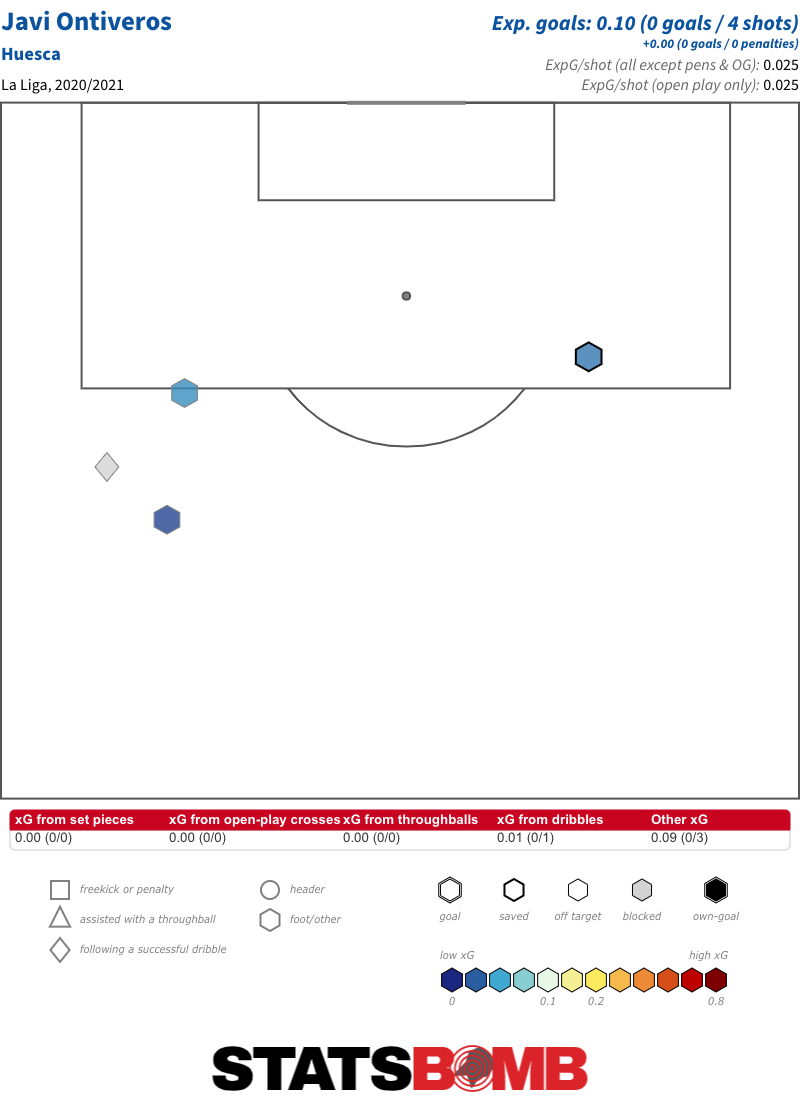
Author: admin
The Big 5 After 5: Ligue 1
Ligue 1 was the first of the big five European leagues to get its 2020-21 season underway. Five matchdays in, let’s look at four interesting things from the early running in France. Rennes Lead The Way Rennes are the early leaders after taking four wins and a draw from their opening set of fixtures. Their underlying numbers also look promising, continuing the trend from the second half of last season’s abruptly shortened championship, when they had the second best metrics in the division behind Paris Saint-Germain. Then, a switch to a more proactive defensive approach, albeit still a pretty average one in the overall context of the league, yielded dividends at both ends of the pitch. Rennes began to create a higher number of better quality shots whilst conceding a lower number of worse quality ones. They became much more adept at creating opportunities in transitional phases of play, and leaned less on crosses as a means of entering the penalty area. 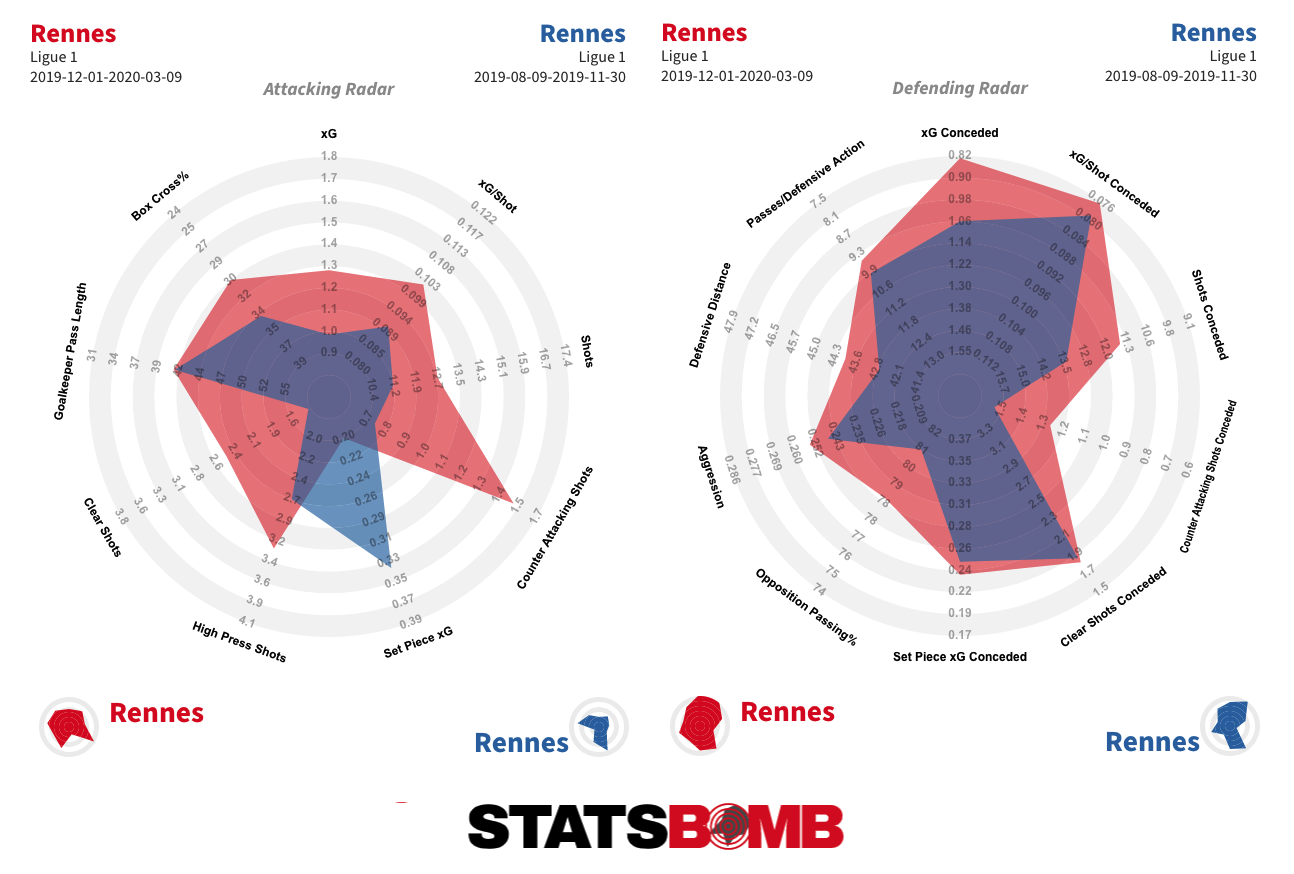 Those same broad stylistic traits seem to have carried into the early running of 2020-21, and their position atop the table is reflective of a smart club seemingly on the up. They won the Coupe de France in 2018-19, and last season’s third-place finish means that this time around they will compete in the Champions League for the first time in their history. Paris Saint-Germain: Still Good Paris Saint-Germain started the season poorly with consecutive 1-0 defeats to Lens and Marseille, a pair of results that predictably produced rumblings over the future of head coach Thomas Tuchel and talks of potential dressing room unrest. They’ve since recorded three straight wins without conceding, and their metrics suggest all is well. PSG have taken 66% of the shots in their matches and accumulated nearly 73% of the expected goals. They were genuinely bad against Lens in their opener, mainly because they were missing a bunch of key players including Ángel Di Maria, Kylian Mbappé, Marquinhos and Neymar, but they’ve otherwise been their normal dominant selves. As much as everyone would love to see a tighter title race, there is scant evidence of any kind of downturn or easing on their part. Even if a team like Lille, Lyon, Marseille, Monaco or Rennes does improve significantly, PSG were so insanely far ahead of the rest last season that even a slight easing in their output would still likely make them comfortable champions. A Great Start for Lens Newly promoted Lens have so far not looked at all out of place in the top flight. Three wins and a draw from their first five fixtures have them up in the top six, and their metrics look even better. They’ve taken a 63% share of the shots in their matches, and have carried an xG difference of +6.43 through these early weeks of the campaign, second only to PSG. Realistically, they aren’t going to maintain those numbers through the entire season, but it is a great start, and there is much to like in their approach. The new arrivals also seem to be producing. Gaël Kakuta is enjoying himself as one of two attacking midfielders in their 3-4-2-1 system, while Ignatius Ganago already has four goals (from 3.75 xG) on the board. Facundo Medina has replicated the bold ball-carrying and impressive passing range that saw him stand out at Talleres de Córdoba last season.
Those same broad stylistic traits seem to have carried into the early running of 2020-21, and their position atop the table is reflective of a smart club seemingly on the up. They won the Coupe de France in 2018-19, and last season’s third-place finish means that this time around they will compete in the Champions League for the first time in their history. Paris Saint-Germain: Still Good Paris Saint-Germain started the season poorly with consecutive 1-0 defeats to Lens and Marseille, a pair of results that predictably produced rumblings over the future of head coach Thomas Tuchel and talks of potential dressing room unrest. They’ve since recorded three straight wins without conceding, and their metrics suggest all is well. PSG have taken 66% of the shots in their matches and accumulated nearly 73% of the expected goals. They were genuinely bad against Lens in their opener, mainly because they were missing a bunch of key players including Ángel Di Maria, Kylian Mbappé, Marquinhos and Neymar, but they’ve otherwise been their normal dominant selves. As much as everyone would love to see a tighter title race, there is scant evidence of any kind of downturn or easing on their part. Even if a team like Lille, Lyon, Marseille, Monaco or Rennes does improve significantly, PSG were so insanely far ahead of the rest last season that even a slight easing in their output would still likely make them comfortable champions. A Great Start for Lens Newly promoted Lens have so far not looked at all out of place in the top flight. Three wins and a draw from their first five fixtures have them up in the top six, and their metrics look even better. They’ve taken a 63% share of the shots in their matches, and have carried an xG difference of +6.43 through these early weeks of the campaign, second only to PSG. Realistically, they aren’t going to maintain those numbers through the entire season, but it is a great start, and there is much to like in their approach. The new arrivals also seem to be producing. Gaël Kakuta is enjoying himself as one of two attacking midfielders in their 3-4-2-1 system, while Ignatius Ganago already has four goals (from 3.75 xG) on the board. Facundo Medina has replicated the bold ball-carrying and impressive passing range that saw him stand out at Talleres de Córdoba last season. 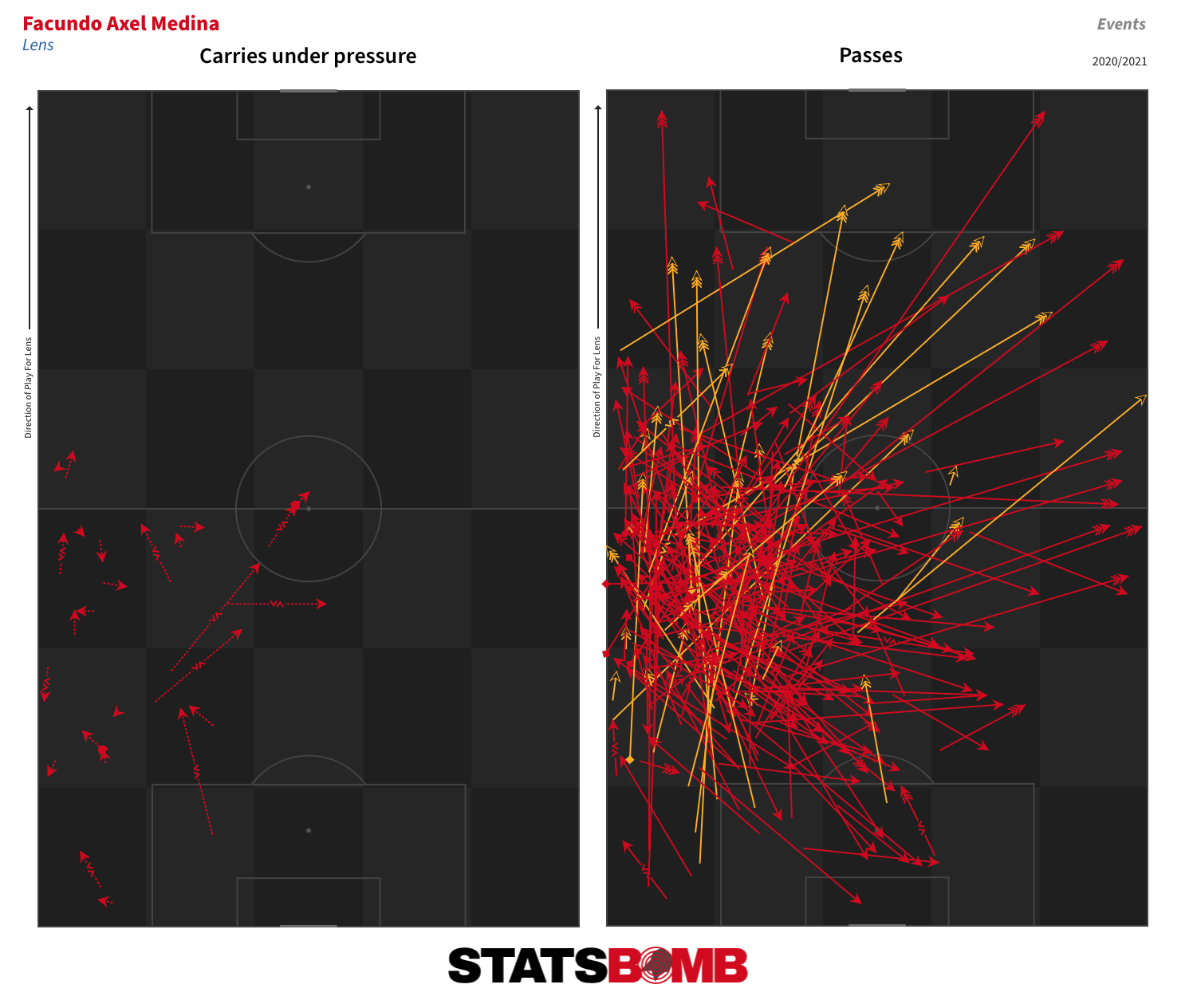 The underlying numbers also suggest that Lorient, who came up ahead of Lens as Ligue 2 champions, have been better than results to date might indicate. The two promoted teams have avoided a direct return to the second tier in each of the last two Ligue 1 seasons. That run might just continue through 2020-21. Bamba Finally Gets His Goal After 12 non-penalty goals in 2018-19, Lille’s Jonathan Bamba failed to register a single goal from 44 shots last season -- the highest non-scoring tally in the league.
The underlying numbers also suggest that Lorient, who came up ahead of Lens as Ligue 2 champions, have been better than results to date might indicate. The two promoted teams have avoided a direct return to the second tier in each of the last two Ligue 1 seasons. That run might just continue through 2020-21. Bamba Finally Gets His Goal After 12 non-penalty goals in 2018-19, Lille’s Jonathan Bamba failed to register a single goal from 44 shots last season -- the highest non-scoring tally in the league. 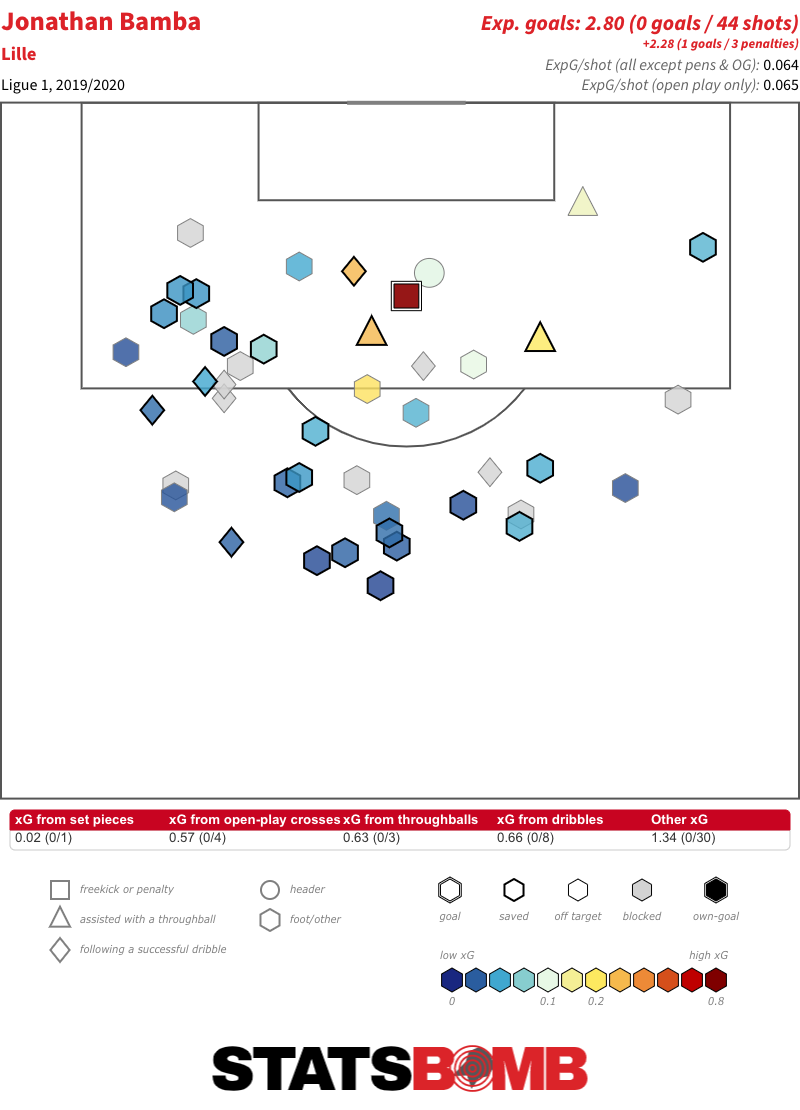 There was a bit of finishing variance involved there, but there was also a notable decline in the value of his shot locations in a post-Nicolas-Pépé world. The average quality reduced from 0.11 xG/shot in 2018-19 down to 0.06 xG/shot in 2019-20. But things seem to be looking up for Bamba this time around. He scored with his first shot of the new campaign in the opening day draw against Rennes, and added another in the 1-0 win away at Reims that followed it.
There was a bit of finishing variance involved there, but there was also a notable decline in the value of his shot locations in a post-Nicolas-Pépé world. The average quality reduced from 0.11 xG/shot in 2018-19 down to 0.06 xG/shot in 2019-20. But things seem to be looking up for Bamba this time around. He scored with his first shot of the new campaign in the opening day draw against Rennes, and added another in the 1-0 win away at Reims that followed it. 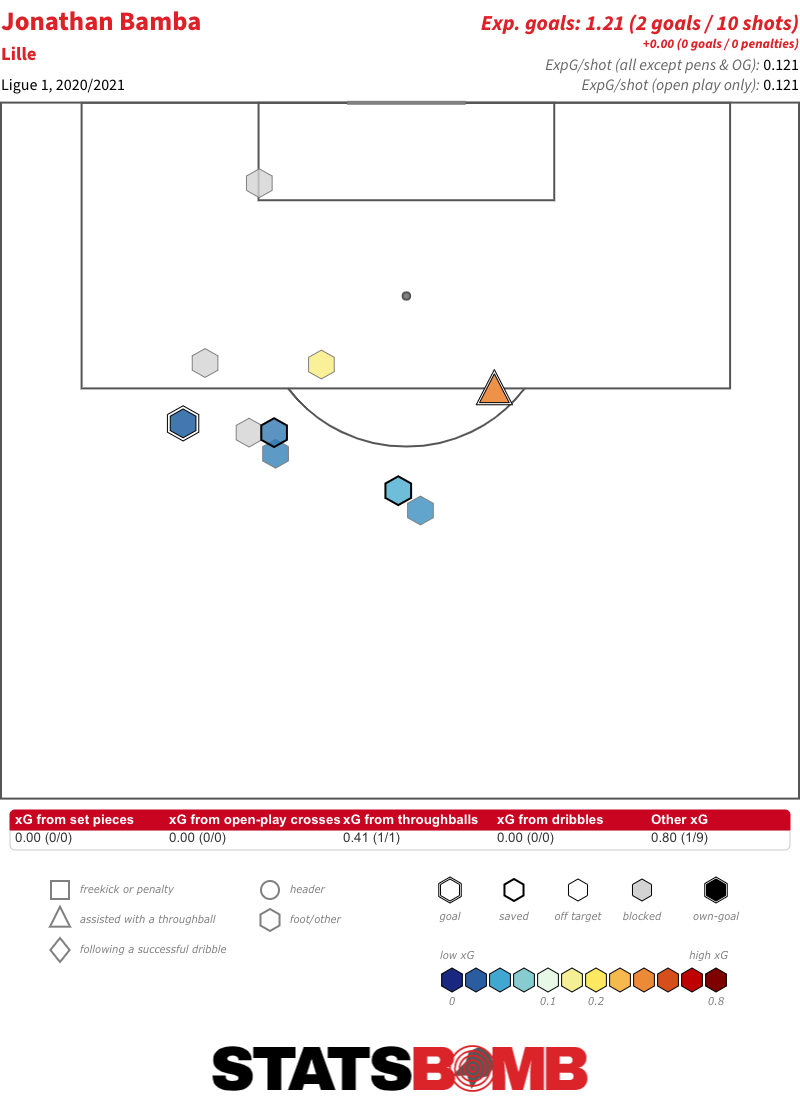 Lille have rebuilt their attack again this year following the big-money departure of Victor Osimhen to Napoli, and the changes seem to be to Bamba’s liking. The sample size is way too low to extrapolate too much from it, but the early signs are promising for a return to his output of two seasons past.
Lille have rebuilt their attack again this year following the big-money departure of Victor Osimhen to Napoli, and the changes seem to be to Bamba’s liking. The sample size is way too low to extrapolate too much from it, but the early signs are promising for a return to his output of two seasons past.
Manchester City: Season Preview 2020-21
Will this be the last season we see Pep Guardiola in English football? If it is, the rest of the title-aspirants will not mourn his departure. Arguably it’s become harder than ever to win titles during his tenure. Of course, City only have two titles from his four seasons as Antonio Conte’s Chelsea took the top prize in 2016-17 and Liverpool won it last time round. Within this era, five of the six highest points totals in the Premier League era exist: two each for City (100 in 2017-18 and 98 in 2018-19) and Liverpool (97 in 2018-19 and 99 in 2019-20) and Chelsea’s 93 in 2016-17. Is this the new normal? Or will we see a decline if Guardiola departs? What is certain is that the combination of it possibly being his last season in Manchester plus a comparatively mediocre 81 points last season should be adequate motivation for Guardiola to set about reclaiming the title. To the consternation of some, once more, the metrics were extremely good but the outcomes were decidedly split. Two Manchester Cities operated in 2019-20. One version laid waste to defences and racked up simple, dominant wins without needing to get out of second gear. Watford gave up twelve goals in two defeats, Villa, Brighton and Burnley all gave up nine. Elsewhere, they couldn’t best Manchester United or Wolves across two games, and contrived to lose to Norwich. The sheer weirdness of annihilating Tottenham twice yet getting just one point can be filed under “football has elements of randomness” too. For the record in those two games, they recorded 48 shots to Tottenham’s 6, and a huge 6.3 to 0.5 in expected goals. Even in defeat, frequently, the elements of good process were right there. Some of the most eyecatching defeats involved red cards. The 3-2 defeat to Wolves at Christmas showed all their quality--they went 2-0 up despite losing Ederson in the 11th minute before giving up the lead late on. Not good was Chelsea’s convincing 2-1 June victory was helped by Fernandinho’s 73rd minute dismissal from where the Blues turned the screw and City didn’t muster a shot. March’s 2-0 defeat to United was pretty tepid too. As ever they dominated the ball but unusually created very little (just seven shots). The bottom line is that City’s record against teams in the eventual top seven (usual big six plus Leicester) was insufficient to see them challenge long and late into any season, let along one in which Liverpool barely dropped points. With a record of 4-1-7 with five out of six away defeats here, City just weren’t able to consistently dominate and beat the better teams in this league. This is where they were so strong in the previous two seasons (9-1-2 in 2017-18 and 9-2-1 in 2018-19) and where they faltered in Guardiola’s first season (2-5-5). 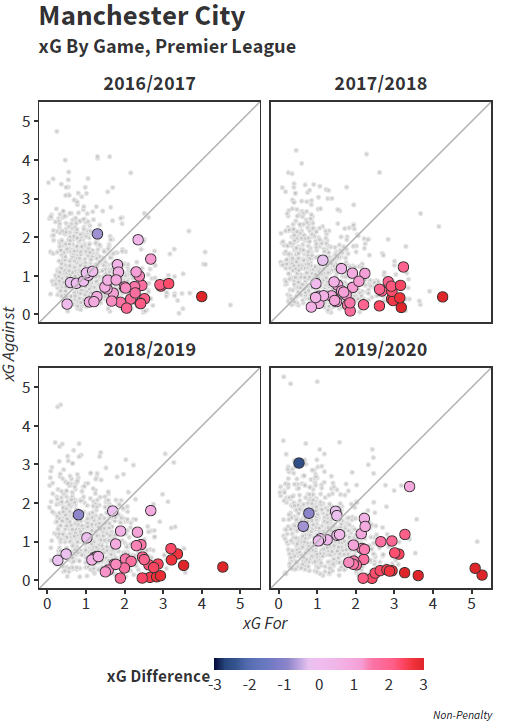 In the big picture, City's metrics were great; but then again they always are. But when we drill down to game by game (as the chart above shows) we can see that City's problem was as much aligned to the variation in their performance levels in games as anything else. Look at 2017-18: nearly no games with over one expected goals allowed and only one game in which their total was exceeded. 2018-19 was pretty good too but with a smattering of games in which the defence looked more vulnerable. 2019-20 has a weird mix of high xG for/low xG against games and a bunch of matches in which the team is either outperformed, gives up a lot in defence or it's pretty close. Bottom line, there was less consistency and that's partly how they contrived to lose nine games having only lost twelve combined in the previous three seasons. The dichotomy between both shot quantity and shot quality at both ends of the pitch was fairly remarkable too. As ever City took a lot of shots. Their 19.5 per game was higher than any of their previous seasons and evoked Carlo Ancelotti's 2009-10 Chelsea team, which was the last Premier League team to get anywhere near this kind of volume. They were good shots too, with the xG per shot value of close to 0.12 only a rizla-width behind that of Arsenal's own 0.12. Loads of shots of very good quality equals loads of goals, 102 in fact, which tied their 2013-14 total and was only four goals behind that of 2017-18. As ever, all their attackers had decent contributory seasons, and eight different players played more than 900 minutes and contributed between 0.49 and 0.98 goals (or assists) per 90 minutes. It's daft really. The varying outcomes and lack of Champions League success will mean that it may take time to really reflect adequately on what Guardiola created in this team, but the attacking unit remains utterly stellar. But the defence. The defence. Seven shots against was up from six in the previous two seasons. Such volume remains are ludicrously good and again speaks of good process. However, the value of these shots was league high at 0.12, significantly up from all of Guardiola's three previous seasons and essentially the same value as the shots they were taking. So Manchester City, one of the best attacking teams in world football, gave up the same shot quality as they take themselves. That's a problem. Throughball vulnerability was a part of this. Across 2017-18 and 2018-19 City gave up 21 shots from throughballs and three goals. In 2019-20 alone they allowed the same volume of shots against (21) but this time gave up seven goals. This kind of vulnerability is a frequent weak spot for pressing teams, and it is to City's credit that they managed to resolve a weakness here after Guardiola's first season.. 2019-20 was not successful here though, and Kyle Walker and Ederson apart, the whole backline has felt erratically assembled for a while. The obvious switch at the back was that (then) 34 year old defensive midfielder Fernandinho was now a starting centre back, and with Aymeric Laporte out, the rotation grew more frequent. A stalwart back in 2017-18, Nicolas Otamendi has become a player who is in and out of the team while John Stones appeared to fall right down the pecking order with Eric Garcia ending the season with a bunch of starts. Stones' demise is curious but possibly not undeserved. An experimental metric I calculated to establish how frequently defenders were actively clearing their defensive zones versus the amount of successful plays their opponents were making saw him rank dead last of all centre backs in the league, and by some margin. As the new man in midfield, Rodri was eyed as a potential culprit towards this new found defensive instability, with ideas that he had yet to perfect the dark arts of Fernandinho, but this was pretty speculative. On top of this City once more conceded some very stupid goals, twice seeing Ederson bypassed from 40 yards or so, from Che Adams and Scott McTominay respectively. Mo Salah did the same a couple of years back and they're such horrible goals to give up, one would think that there were tweaks that could be added to the philosophy just to avert this. Personnel For a club that has spent widely, and acquired Raheem Sterling and Kevin De Bruyne in one summer window back in 2015 there's a nagging feeling that in recent seasons City haven't quite nailed their transfers. Admittedly, when a team generally performs as well as this one has across Guardiola's reign, it's tricky to purchase players that intrinsically improve the starting eleven. Case in point being Riyad Mahrez who was the one main signing in the summer of 2018. He has been a top tier contributor to goals when on the pitch in both his seasons at the club but is no guaranteed starter. He would likely start every week for any other club in the league (Liverpool could squeeze him and Mo Salah in somehow) and in 2019-20 was extremely effective and slightly unsung as De Bruyne in particular rightly took the plaudits:
In the big picture, City's metrics were great; but then again they always are. But when we drill down to game by game (as the chart above shows) we can see that City's problem was as much aligned to the variation in their performance levels in games as anything else. Look at 2017-18: nearly no games with over one expected goals allowed and only one game in which their total was exceeded. 2018-19 was pretty good too but with a smattering of games in which the defence looked more vulnerable. 2019-20 has a weird mix of high xG for/low xG against games and a bunch of matches in which the team is either outperformed, gives up a lot in defence or it's pretty close. Bottom line, there was less consistency and that's partly how they contrived to lose nine games having only lost twelve combined in the previous three seasons. The dichotomy between both shot quantity and shot quality at both ends of the pitch was fairly remarkable too. As ever City took a lot of shots. Their 19.5 per game was higher than any of their previous seasons and evoked Carlo Ancelotti's 2009-10 Chelsea team, which was the last Premier League team to get anywhere near this kind of volume. They were good shots too, with the xG per shot value of close to 0.12 only a rizla-width behind that of Arsenal's own 0.12. Loads of shots of very good quality equals loads of goals, 102 in fact, which tied their 2013-14 total and was only four goals behind that of 2017-18. As ever, all their attackers had decent contributory seasons, and eight different players played more than 900 minutes and contributed between 0.49 and 0.98 goals (or assists) per 90 minutes. It's daft really. The varying outcomes and lack of Champions League success will mean that it may take time to really reflect adequately on what Guardiola created in this team, but the attacking unit remains utterly stellar. But the defence. The defence. Seven shots against was up from six in the previous two seasons. Such volume remains are ludicrously good and again speaks of good process. However, the value of these shots was league high at 0.12, significantly up from all of Guardiola's three previous seasons and essentially the same value as the shots they were taking. So Manchester City, one of the best attacking teams in world football, gave up the same shot quality as they take themselves. That's a problem. Throughball vulnerability was a part of this. Across 2017-18 and 2018-19 City gave up 21 shots from throughballs and three goals. In 2019-20 alone they allowed the same volume of shots against (21) but this time gave up seven goals. This kind of vulnerability is a frequent weak spot for pressing teams, and it is to City's credit that they managed to resolve a weakness here after Guardiola's first season.. 2019-20 was not successful here though, and Kyle Walker and Ederson apart, the whole backline has felt erratically assembled for a while. The obvious switch at the back was that (then) 34 year old defensive midfielder Fernandinho was now a starting centre back, and with Aymeric Laporte out, the rotation grew more frequent. A stalwart back in 2017-18, Nicolas Otamendi has become a player who is in and out of the team while John Stones appeared to fall right down the pecking order with Eric Garcia ending the season with a bunch of starts. Stones' demise is curious but possibly not undeserved. An experimental metric I calculated to establish how frequently defenders were actively clearing their defensive zones versus the amount of successful plays their opponents were making saw him rank dead last of all centre backs in the league, and by some margin. As the new man in midfield, Rodri was eyed as a potential culprit towards this new found defensive instability, with ideas that he had yet to perfect the dark arts of Fernandinho, but this was pretty speculative. On top of this City once more conceded some very stupid goals, twice seeing Ederson bypassed from 40 yards or so, from Che Adams and Scott McTominay respectively. Mo Salah did the same a couple of years back and they're such horrible goals to give up, one would think that there were tweaks that could be added to the philosophy just to avert this. Personnel For a club that has spent widely, and acquired Raheem Sterling and Kevin De Bruyne in one summer window back in 2015 there's a nagging feeling that in recent seasons City haven't quite nailed their transfers. Admittedly, when a team generally performs as well as this one has across Guardiola's reign, it's tricky to purchase players that intrinsically improve the starting eleven. Case in point being Riyad Mahrez who was the one main signing in the summer of 2018. He has been a top tier contributor to goals when on the pitch in both his seasons at the club but is no guaranteed starter. He would likely start every week for any other club in the league (Liverpool could squeeze him and Mo Salah in somehow) and in 2019-20 was extremely effective and slightly unsung as De Bruyne in particular rightly took the plaudits: 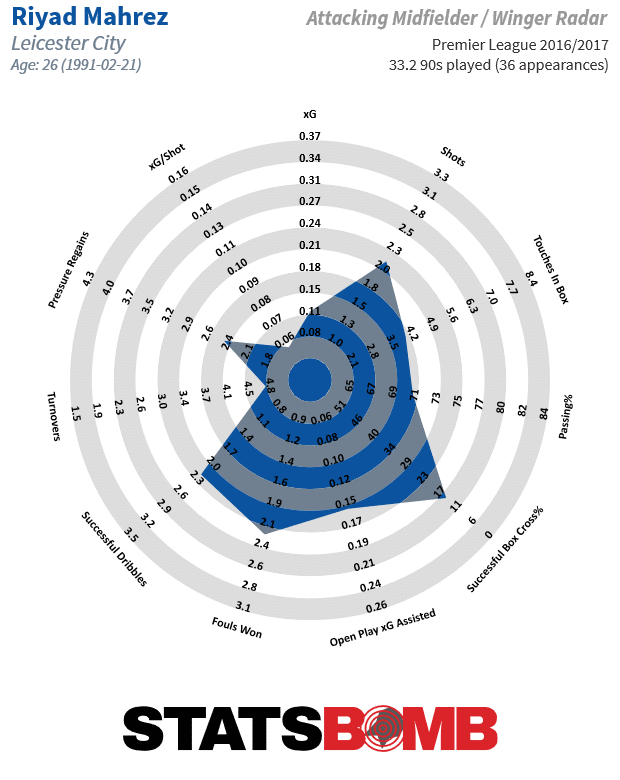 So far this summer in the transfer market, there has been a move to shore up defence with a novel idea: "buy a relegated centre back". Arriving for around £40m, Nathan Aké has long appeared the type of player that could move to a higher level than Bournemouth, not least because he is so comfortable on the ball. As a left footed centre back on the cusp of his peak years, he was a relatively scarce commodity and does actually scope out as a fairly capable defending defender on top of passing reliability. It's hard to see him as a direct upgrade who will slot instantly into City's first eleven, but no doubt he will get minutes, and ease the pressure Laporte had to shoulder as the one natural left sided centre back. There is talk of Kalidou Koulibaly arriving, but at this stage gossip around him is as reliable to the transfer window as Santa Claus is to Christmas, so it's hard to be confident here. If the past was represented by the sad sight of Leroy Sané returning to his homeland, the future is now here in the form of 20 year old Ferran Torres, who arrived from Valencia. His former team struggled extensively in 2019-20, and it had an impact on the numerical impact of much of their squad. As such we have a tricky chicken vs egg problem when evaluating him just from numbers; as we well know, the video is required too:
So far this summer in the transfer market, there has been a move to shore up defence with a novel idea: "buy a relegated centre back". Arriving for around £40m, Nathan Aké has long appeared the type of player that could move to a higher level than Bournemouth, not least because he is so comfortable on the ball. As a left footed centre back on the cusp of his peak years, he was a relatively scarce commodity and does actually scope out as a fairly capable defending defender on top of passing reliability. It's hard to see him as a direct upgrade who will slot instantly into City's first eleven, but no doubt he will get minutes, and ease the pressure Laporte had to shoulder as the one natural left sided centre back. There is talk of Kalidou Koulibaly arriving, but at this stage gossip around him is as reliable to the transfer window as Santa Claus is to Christmas, so it's hard to be confident here. If the past was represented by the sad sight of Leroy Sané returning to his homeland, the future is now here in the form of 20 year old Ferran Torres, who arrived from Valencia. His former team struggled extensively in 2019-20, and it had an impact on the numerical impact of much of their squad. As such we have a tricky chicken vs egg problem when evaluating him just from numbers; as we well know, the video is required too: 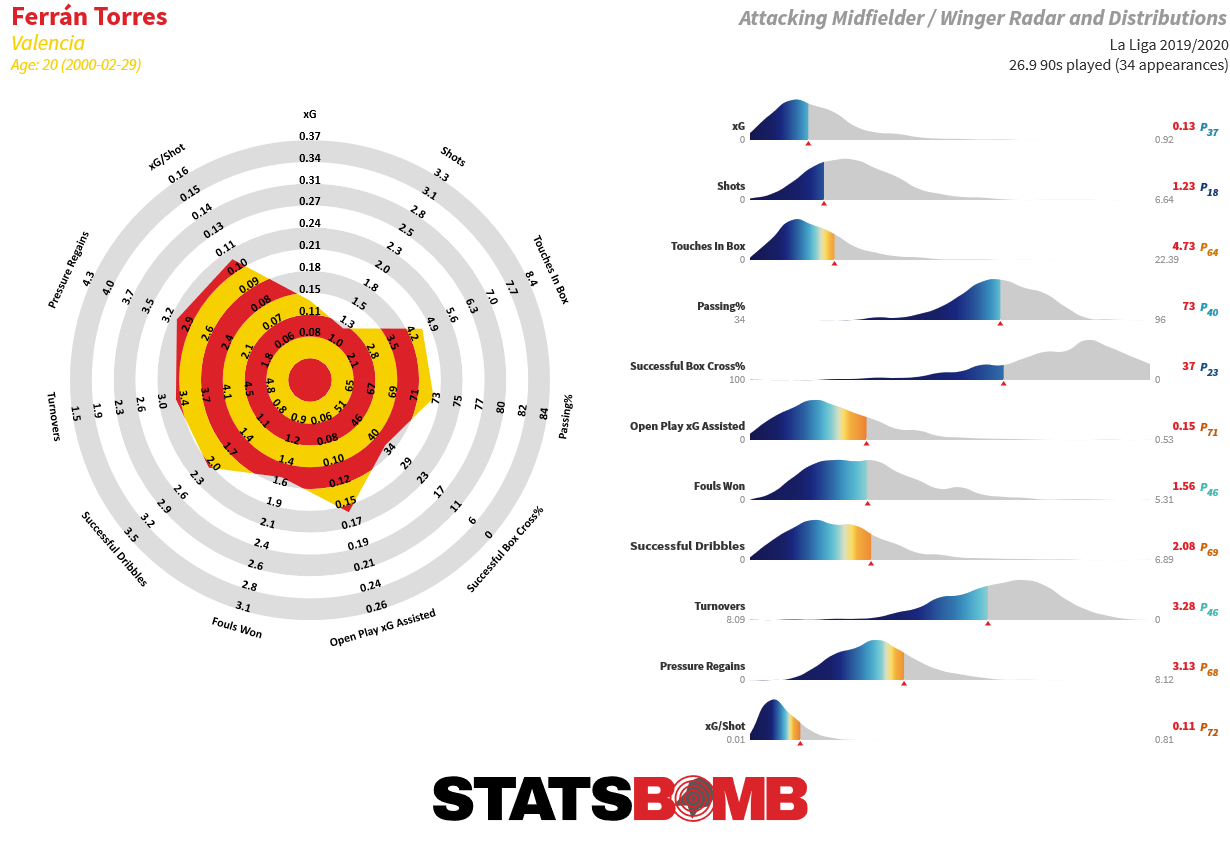 The vast majority of Torres' career has been spent playing off the right side, and how he fits into this team is hard to answer. Raheem Sterling plays off the left, so not there, while the lefties Mahrez and Bernardo Silva tend to operate off the right and Phil Foden is the breakthrough talent already in the squad and covering both these positions. Foden's development really should not be stymied and in particular he shows up extremely well for finding space in the final third. There is likely a positive skew that was assisted by playing often in the post restart fixtures, which were played at a noticeably kinder pace than what came before, but Foden's final third ball receipts were considered "under pressure" on only 6% of his receipts, the lowest in the league by a good margin:
The vast majority of Torres' career has been spent playing off the right side, and how he fits into this team is hard to answer. Raheem Sterling plays off the left, so not there, while the lefties Mahrez and Bernardo Silva tend to operate off the right and Phil Foden is the breakthrough talent already in the squad and covering both these positions. Foden's development really should not be stymied and in particular he shows up extremely well for finding space in the final third. There is likely a positive skew that was assisted by playing often in the post restart fixtures, which were played at a noticeably kinder pace than what came before, but Foden's final third ball receipts were considered "under pressure" on only 6% of his receipts, the lowest in the league by a good margin: 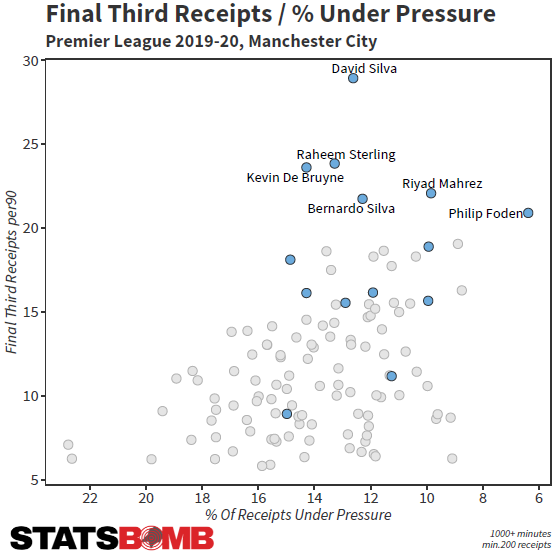 What that chart highlights too is the real hole that has opened up in this squad this summer: the departure of club legend David Silva. Again his presence in midfield last season at 34 years old poses questions about how readily opponents could get through City, but undoubtedly, his on the ball influence was far from dimmed. A rock solid contributor to Guardiola's possession game, and an utterly reliable secondary creator for the team behind De Bruyne, he was still good for 22 league starts last season. Who replaces him? The squad is deep enough to take the hit, but it's not as if a clear answer is wildly evident. Early season we may see some more Guardiola flexibility in selection, this time in midfield rather than just defence. Projection 78, 100, 98, 81 divided by 4 equals 89.25. That's Guardiola's four Manchester City seasons. Sporting Index opened up at 88.5-90 which the eagle eyed amongst you will notice has a midpoint of 89.25. The metrics are still there for this team. They won 26 games last season, and for various reasons ended up towards the bottom end of any realistic point expectation. That doesn't necessarily mean they are primed to overhaul Liverpool who have managed to be consistent as well as dominant in the last two seasons, much as City did before and alongside them in 2017-18 and 2018-19, but they do have the tools. City need to reclaim consistency and perhaps with a crazy schedule for all, Guardiola may be wise to flip the off switch more often when his team are coasting and games are won. Enough of the metrics that undermined City in 2019-20 land in the high variance category, and the functional control this team can still exert over the vast majority of their opponents will surely see them go very deep into the season and contend. Would I bet on them to win it? I don't think so. That's not to say they can't, they are betting favourites with good reason but City have been the metric darlings of nearly every season in the last decade, yet they've won just four titles. You need to be both very good and have things also go your way to win this league. If Guardiola is to leave though, he'll no doubt want to go out on a high.
What that chart highlights too is the real hole that has opened up in this squad this summer: the departure of club legend David Silva. Again his presence in midfield last season at 34 years old poses questions about how readily opponents could get through City, but undoubtedly, his on the ball influence was far from dimmed. A rock solid contributor to Guardiola's possession game, and an utterly reliable secondary creator for the team behind De Bruyne, he was still good for 22 league starts last season. Who replaces him? The squad is deep enough to take the hit, but it's not as if a clear answer is wildly evident. Early season we may see some more Guardiola flexibility in selection, this time in midfield rather than just defence. Projection 78, 100, 98, 81 divided by 4 equals 89.25. That's Guardiola's four Manchester City seasons. Sporting Index opened up at 88.5-90 which the eagle eyed amongst you will notice has a midpoint of 89.25. The metrics are still there for this team. They won 26 games last season, and for various reasons ended up towards the bottom end of any realistic point expectation. That doesn't necessarily mean they are primed to overhaul Liverpool who have managed to be consistent as well as dominant in the last two seasons, much as City did before and alongside them in 2017-18 and 2018-19, but they do have the tools. City need to reclaim consistency and perhaps with a crazy schedule for all, Guardiola may be wise to flip the off switch more often when his team are coasting and games are won. Enough of the metrics that undermined City in 2019-20 land in the high variance category, and the functional control this team can still exert over the vast majority of their opponents will surely see them go very deep into the season and contend. Would I bet on them to win it? I don't think so. That's not to say they can't, they are betting favourites with good reason but City have been the metric darlings of nearly every season in the last decade, yet they've won just four titles. You need to be both very good and have things also go your way to win this league. If Guardiola is to leave though, he'll no doubt want to go out on a high.
If you're a club, media or gambling entity and want to know more about what StatsBomb can do for you, please contact us at Sales@StatsBomb.com We also provide education in this area, so if this taste of football analytics sparked interest, check out our Introduction to Football Analytics course Follow us on twitter in English and Spanish and also on LinkedIn
Wolverhampton Wanderers: Season Preview 2020-21
Wolves, or to give them their full name "Little Portugal", have very quickly become a Premier League club that can match up against any team in the league. Across two seasons, they have proven to be consistent, resilient and well worth their consecutive seventh placed finishes. Of course, like many teams outside the television big six, Wolves harbour ambitions of more than that, and may be slightly frustrated that they couldn't exploit the down years for both Tottenham and Arsenal and do what Leicester did in 2019-20 and finish higher up. At least in part this inability to broach the gap upwards can be attributed to a slightly slow start. Wolves had a 2-7-2 record after a 1-1 draw at Arsenal on 2nd November, and while there were good results in there, including a 2-0 win against Manchester City and draws against Manchester United and Leicester City, it's likely that this period was that which impacted the final table most. Was there a problem? Not really? Metrics weren't at their strongest during this period as we can see from Wolves' two season expected goal trends, but there was good reason: 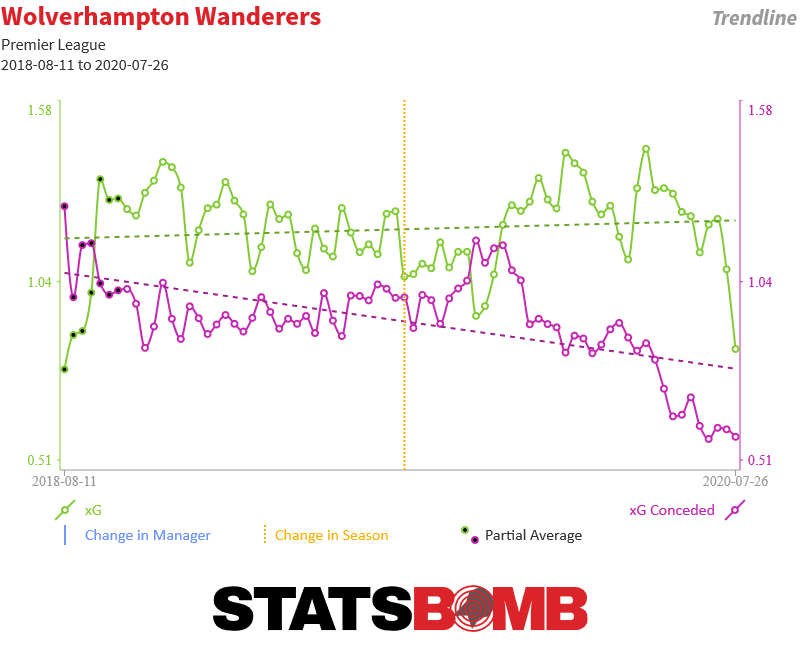 Belfast, Yerevan, Turin, Istanbul and Bratislava formed a Europa League tour for the club during a period in which they played as many non-league fixtures as league (eleven each). With a relatively small squad and a fairly consistent first team, it's actually to the team's credit that they got through that opening period of the Premier League without further decline. The big story in the chart above is the defence. In the back half of 2019-20 Wolves gave up under one non-penalty expected goal in a game fourteen times. In eight of those games they allowed under 0.5. Wolves post-lockdown defence was structurally the best in the league. Wolves have achieved this defensive stability by being one of the most clear-eyed tactical teams in the division, and a world away from the hard pressing espoused by other managers. That Nuno Espirito Santo is both Portuguese and a former goalkeeper for Jose Mourinho is highly indicative of Wolves style of play:
Belfast, Yerevan, Turin, Istanbul and Bratislava formed a Europa League tour for the club during a period in which they played as many non-league fixtures as league (eleven each). With a relatively small squad and a fairly consistent first team, it's actually to the team's credit that they got through that opening period of the Premier League without further decline. The big story in the chart above is the defence. In the back half of 2019-20 Wolves gave up under one non-penalty expected goal in a game fourteen times. In eight of those games they allowed under 0.5. Wolves post-lockdown defence was structurally the best in the league. Wolves have achieved this defensive stability by being one of the most clear-eyed tactical teams in the division, and a world away from the hard pressing espoused by other managers. That Nuno Espirito Santo is both Portuguese and a former goalkeeper for Jose Mourinho is highly indicative of Wolves style of play: 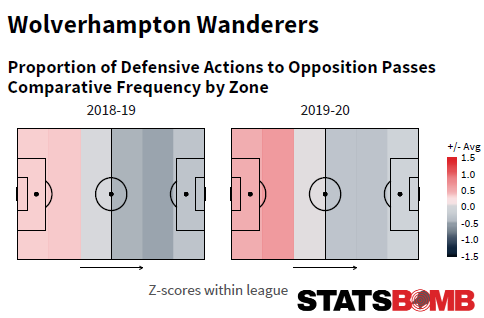 Nuno's set-ups are well established at this stage. Sixteen teams used three centre backs at some point last season [t's funny how these fashions pervade] yet only two of them set up with three centre backs in every game, Wolves and Sheffield United. The core of this team is well established too but will undergo some kind of remedial work going forward thanks to the absence of two key parts: the full backs. Stalwart Matt Doherty has joined Tottenham while Jonny has sustained a long term ACL injury and is likely to be unsighted for many months. In 2018-19, Wolves fielded 14 players for over 900 minutes in the league and in 2019-20 it was 13. They have operated with a very small consistent squad for two full seasons and are now obliged to adapt especially on the flanks. On the left Ruben Vinagre may have felt he was stepping out of the reserve slot he's held for two seasons but the signing of 31 year old Lyon rotational full back Marçal suggests his role may well persist for now. In the interests of sample size, this visualisation covers three seasons; he's experienced and was playing in the Champions League three weeks ago, but he will need to show robustness and reliability as being a Wolves full back is not a position for the underinvolved.
Nuno's set-ups are well established at this stage. Sixteen teams used three centre backs at some point last season [t's funny how these fashions pervade] yet only two of them set up with three centre backs in every game, Wolves and Sheffield United. The core of this team is well established too but will undergo some kind of remedial work going forward thanks to the absence of two key parts: the full backs. Stalwart Matt Doherty has joined Tottenham while Jonny has sustained a long term ACL injury and is likely to be unsighted for many months. In 2018-19, Wolves fielded 14 players for over 900 minutes in the league and in 2019-20 it was 13. They have operated with a very small consistent squad for two full seasons and are now obliged to adapt especially on the flanks. On the left Ruben Vinagre may have felt he was stepping out of the reserve slot he's held for two seasons but the signing of 31 year old Lyon rotational full back Marçal suggests his role may well persist for now. In the interests of sample size, this visualisation covers three seasons; he's experienced and was playing in the Champions League three weeks ago, but he will need to show robustness and reliability as being a Wolves full back is not a position for the underinvolved. 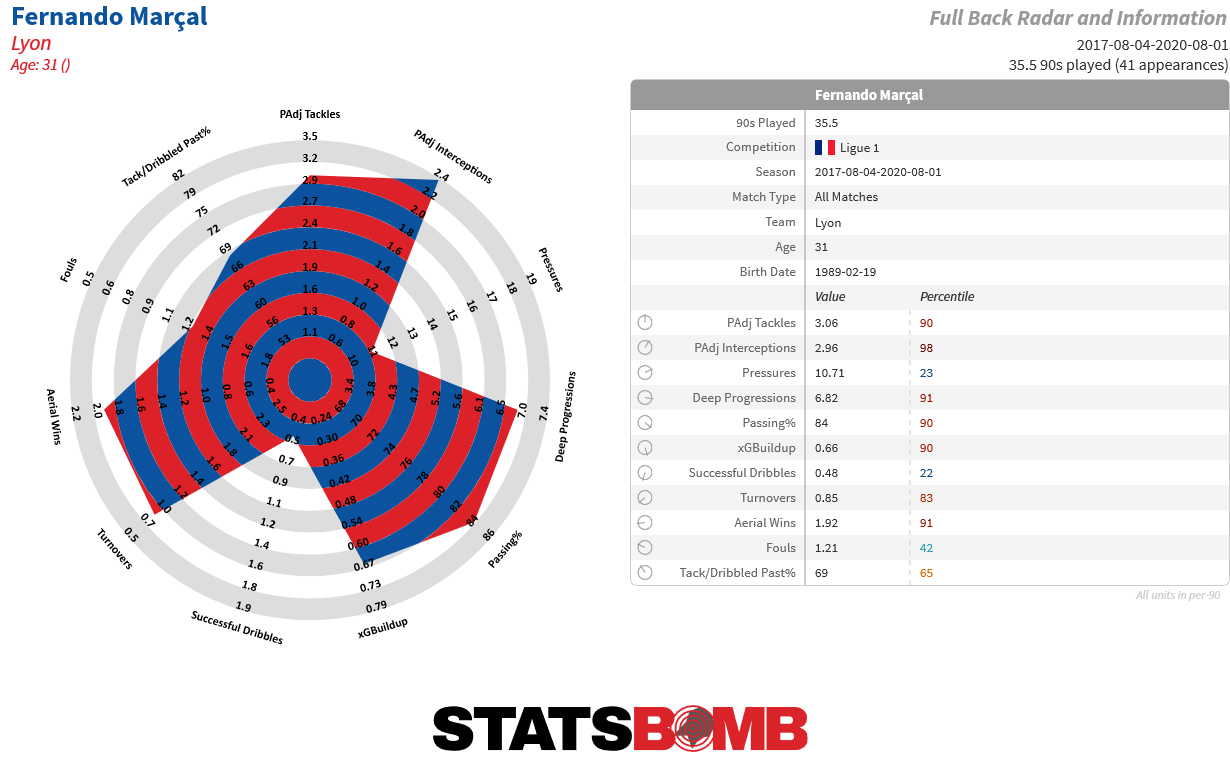 Never knowingly under-involved is Adama Traoré and the early word is that he may end up covering Doherty's role, at least to start the season. He's well capable of playing this position and anywhere else on the right flank and persists in being a unique and curious player. Last season saw a further rise to prominence outside niche stats fans fawning over his dribble volumes. Firstly, his four league goals were spread across three league games, Manchester City home and away and Tottenham. No better way to attract attention than scoring key goals in big games. However, more encouragingly, we saw further end production in his creative numbers. Nine assists was big-boy output and not wildly ahead of expectation. All in all for players with a decent volume of minutes (say 1500+) he was top ten in the league for open play key passes (1.6 per 90) and resulting xG Assisted (0.21 per 90). The reliability of how he made those goals was hugely positive. When you have a thing and you can keep doing your thing and nobody can stop you doing your thing, then you've really got something! But if it doesn't result in goals, your thing might not be that useful. Traoré's thing used to be facing up a defender and then killing them for strength and pace to make space for a further pass. However, the further pass wasn't necessarily a thing too. Now he's showing in the Premier League that goal creation is his thing. Beat a man on the flank and find an attacker in the box. For the defender it's nightmarish: they know what is coming but not if they can stop it. He's probably stronger than you and even if he isn't he sure looks like he is. Check out his very specific chance creation here, and how all his assists have a common thread:
Never knowingly under-involved is Adama Traoré and the early word is that he may end up covering Doherty's role, at least to start the season. He's well capable of playing this position and anywhere else on the right flank and persists in being a unique and curious player. Last season saw a further rise to prominence outside niche stats fans fawning over his dribble volumes. Firstly, his four league goals were spread across three league games, Manchester City home and away and Tottenham. No better way to attract attention than scoring key goals in big games. However, more encouragingly, we saw further end production in his creative numbers. Nine assists was big-boy output and not wildly ahead of expectation. All in all for players with a decent volume of minutes (say 1500+) he was top ten in the league for open play key passes (1.6 per 90) and resulting xG Assisted (0.21 per 90). The reliability of how he made those goals was hugely positive. When you have a thing and you can keep doing your thing and nobody can stop you doing your thing, then you've really got something! But if it doesn't result in goals, your thing might not be that useful. Traoré's thing used to be facing up a defender and then killing them for strength and pace to make space for a further pass. However, the further pass wasn't necessarily a thing too. Now he's showing in the Premier League that goal creation is his thing. Beat a man on the flank and find an attacker in the box. For the defender it's nightmarish: they know what is coming but not if they can stop it. He's probably stronger than you and even if he isn't he sure looks like he is. Check out his very specific chance creation here, and how all his assists have a common thread: 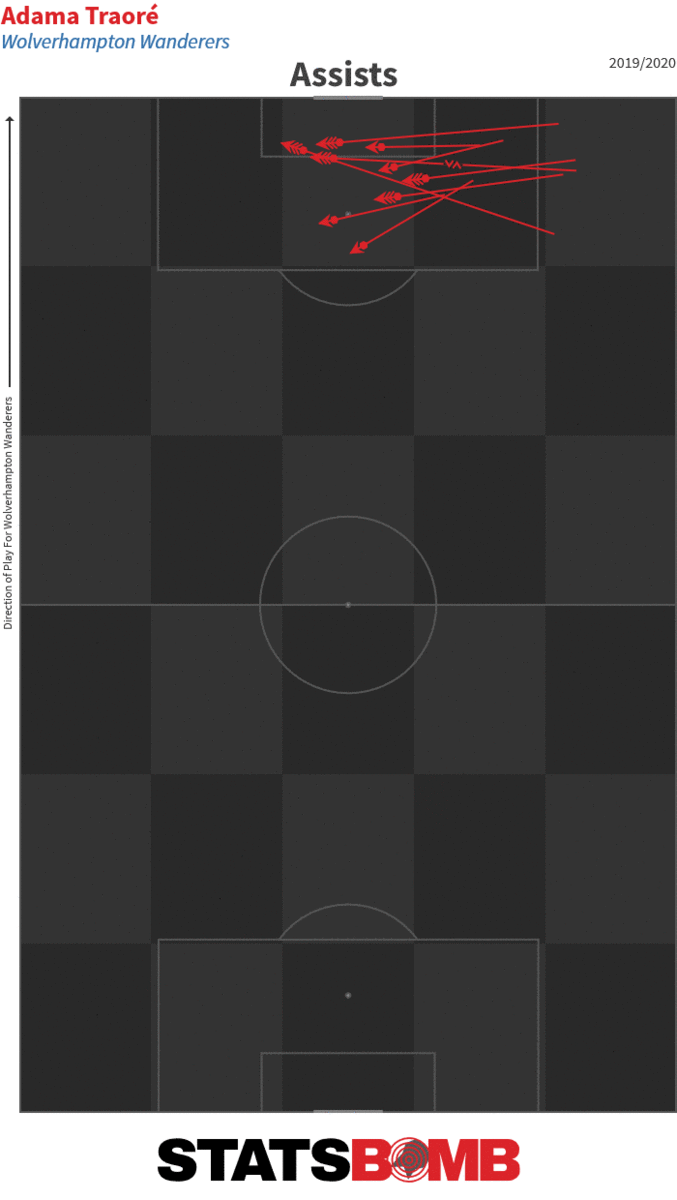 Part of the Wolves oeuvre is ball carrying at pace. It's not just Traoré either. Some experimental numbers I generated for speed with directness of ball carrying saw Diogo Jota rank fastest in the league, with Raúl Jiménez ranking fairly high too. Ironically, Traoré ranked a way back for this specific measure, which was likely a function of his tendency to stand up to the defender and essentially stalling before moving, but he ranked top in the league for average distance per carry into or inside the final third, with Jota third. Wolves as a whole attempt more actual dribbles (~take-ons) than any other team in the league, and carry the ball for longer distances everywhere high up the pitch right up into the box. This is a team that relies strongly on attackers that can transition through zones with the ball at their feet, as we can see when we look at longer carries for those three players:
Part of the Wolves oeuvre is ball carrying at pace. It's not just Traoré either. Some experimental numbers I generated for speed with directness of ball carrying saw Diogo Jota rank fastest in the league, with Raúl Jiménez ranking fairly high too. Ironically, Traoré ranked a way back for this specific measure, which was likely a function of his tendency to stand up to the defender and essentially stalling before moving, but he ranked top in the league for average distance per carry into or inside the final third, with Jota third. Wolves as a whole attempt more actual dribbles (~take-ons) than any other team in the league, and carry the ball for longer distances everywhere high up the pitch right up into the box. This is a team that relies strongly on attackers that can transition through zones with the ball at their feet, as we can see when we look at longer carries for those three players: 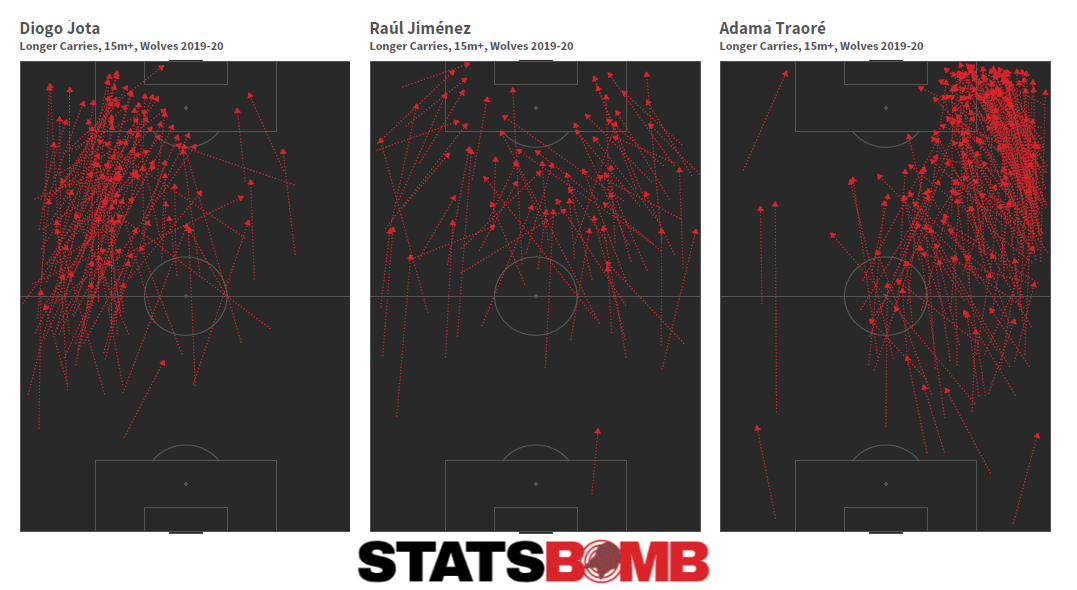 Elsewhere it's intriguing to know whether the club has secured the future of the Portuguese national team in Vitinha and Fábio Silva or attached around £60m to pure potential that will not pay off for some seasons. Each significantly lacks experience of good quality men's level football and thus eludes anything but the most scant review in data. Vitinha at 20 years old has played over 1000 minutes in the Portuguese second tier and grabbed fleeting substitute minutes in the second half of Porto's season, while Silva at just 18 years old had a similar profile in Porto's first team with time on the pitch minimal and mainly via the bench. The impact each can make is difficult to know, and it seems hard to envisage that either will quickly shift the established first teamers out, but they do bring much needed depth to the squad in general and it will be hoped that they can settle and contribute quickly. Projection In a compressed season with very little room for recovery, Wolves will probably reflect that a lack of European football is a real boost to their Premier League chances. Pre-season points projections concur with their seventh placed finishes and expect another season in the nominal "best of the rest" slot. Nuno's style has kept Wolves hard to beat, but there were almost as many draws as wins last season and a shade more attacking power might be the recipe for really pointing upwards and shaking up the top six mix. With a smaller squad and specific and key contributors, injury luck will always have an impact. With that, Wolves are as reliable as they come, and the range of outcomes for this team is likely a lot smaller than that of certain others eyeing similar positions in the table such as Leicester, Tottenham, Arsenal or Everton. It's a good time to be a Wolves fan, and should continue to be so.
Elsewhere it's intriguing to know whether the club has secured the future of the Portuguese national team in Vitinha and Fábio Silva or attached around £60m to pure potential that will not pay off for some seasons. Each significantly lacks experience of good quality men's level football and thus eludes anything but the most scant review in data. Vitinha at 20 years old has played over 1000 minutes in the Portuguese second tier and grabbed fleeting substitute minutes in the second half of Porto's season, while Silva at just 18 years old had a similar profile in Porto's first team with time on the pitch minimal and mainly via the bench. The impact each can make is difficult to know, and it seems hard to envisage that either will quickly shift the established first teamers out, but they do bring much needed depth to the squad in general and it will be hoped that they can settle and contribute quickly. Projection In a compressed season with very little room for recovery, Wolves will probably reflect that a lack of European football is a real boost to their Premier League chances. Pre-season points projections concur with their seventh placed finishes and expect another season in the nominal "best of the rest" slot. Nuno's style has kept Wolves hard to beat, but there were almost as many draws as wins last season and a shade more attacking power might be the recipe for really pointing upwards and shaking up the top six mix. With a smaller squad and specific and key contributors, injury luck will always have an impact. With that, Wolves are as reliable as they come, and the range of outcomes for this team is likely a lot smaller than that of certain others eyeing similar positions in the table such as Leicester, Tottenham, Arsenal or Everton. It's a good time to be a Wolves fan, and should continue to be so.
If you're a club, media or gambling entity and want to know more about what StatsBomb can do for you, please contact us at Sales@StatsBomb.com We also provide education in this area, so if this taste of football analytics sparked interest, check out our Introduction to Football Analytics course Follow us on twitter in English and Spanish and also on LinkedIn
Brighton and Hove Albion: Season Preview 2020-21
In two years since his return from Sweden, Graham Potter's career has progressed extremely well. A stylistically eye-catching year at Swansea was enough to attract Brighton’s attention and the transition from Allsvenskan to Premier League was complete. A (young-ish) English manager had trodden an unfamiliar road before being (kinda) fast tracked to the top? What will the papers say? Potter’s predecessor, Chris Hughton had brought Brighton to the Premier League and kept them up for two seasons. The remit to stay in the division had been fulfilled, at least, for all that the 2018-19 season cut it far too fine, with a run of no wins in the last nine games ceding control to those around them. You only need three worse teams, and there were three worse teams-- Cardiff, Fulham and Huddersfield--but effectively chance was the dominant factor that kept them in the league. Owner Tony Bloom, a man with a solid history in probability, will have noted bottom five metrics including a bottom two ranked attack. With some justification, one can imagine those involved in the decision making process envisaged future seasons of a similar ilk. The defensive onus brought by Hughton meant that scrapping in the bottom half was likely to persist, despite quite extensive recruitment. So could the appointment of Potter change that dynamic? It represented a clear gamble regardless. One thing was certain: Potter would get this team playing a different style of football to Hughton. Far more orientated towards possession and far less reactive. One thing was uncertain: would this change of style keep Brighton away from the trapdoor into the Championship? The topline conclusion is yes. A haul of 41 points was five points clear of 2018-19’s total and one ahead of Hughton’s first season, while a fifteenth place finish matched 2017-18. There were runs where the team struggled to win as six draws and zero wins in nine games pre-lockdown in 2020 testified but they never quite got hauled into the relegation mix. Nine wins overall was… the same as Hughton managed in both his seasons. So has Potter been a success? The metrics have improved, but we do have to recognise that with five games to play, they were nine points clear of relegation, so all but safe, and soon after walked into Manchester City on a good day and shipped over five expected goals, a total only exceeded all season when City thumped Watford 8-0. The backend of the season saw metrics decline, but largely in fundamentally meaningless fixtures: 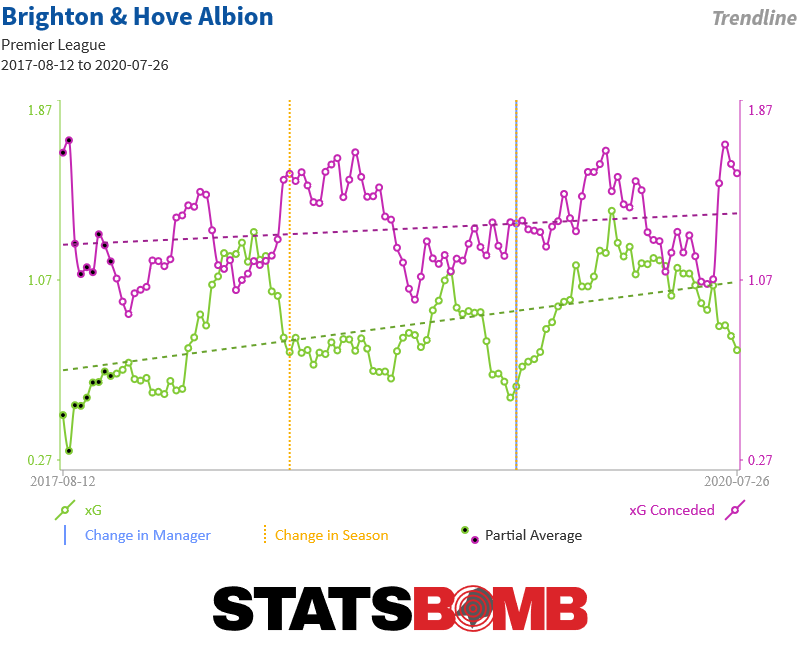 The broader picture is better. In raw terms Brighton’s per game xG differential worsened from -0.43 in 2017-18 to -0.50 in 2018-19 and at the point of safety in 2019-20 was improved at -0.24. There’s enough in that to suggest that Potter’s vstyle has had some effect, and we can see how the line between expected values for and against closed as the season progressed. It’s still far from stellar but it’s enough to feel Potter’s second season is deserved. He has made a small trade off in defence to give the team something to work with in attack, and when we consider that Hughton’s attack was close to league worst, we can understand the purpose here. Hughton's focus on defending was certainly reactive; witness the position of his sides in this table of blocked shots from teams in recent seasons:
The broader picture is better. In raw terms Brighton’s per game xG differential worsened from -0.43 in 2017-18 to -0.50 in 2018-19 and at the point of safety in 2019-20 was improved at -0.24. There’s enough in that to suggest that Potter’s vstyle has had some effect, and we can see how the line between expected values for and against closed as the season progressed. It’s still far from stellar but it’s enough to feel Potter’s second season is deserved. He has made a small trade off in defence to give the team something to work with in attack, and when we consider that Hughton’s attack was close to league worst, we can understand the purpose here. Hughton's focus on defending was certainly reactive; witness the position of his sides in this table of blocked shots from teams in recent seasons: 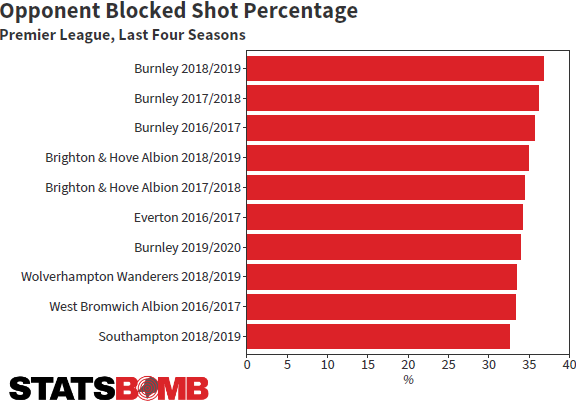 ...and see how Brighton's passes per defensive action has evolved away from a complete bunker under Hughton towards something more balanced under Potter:
...and see how Brighton's passes per defensive action has evolved away from a complete bunker under Hughton towards something more balanced under Potter: 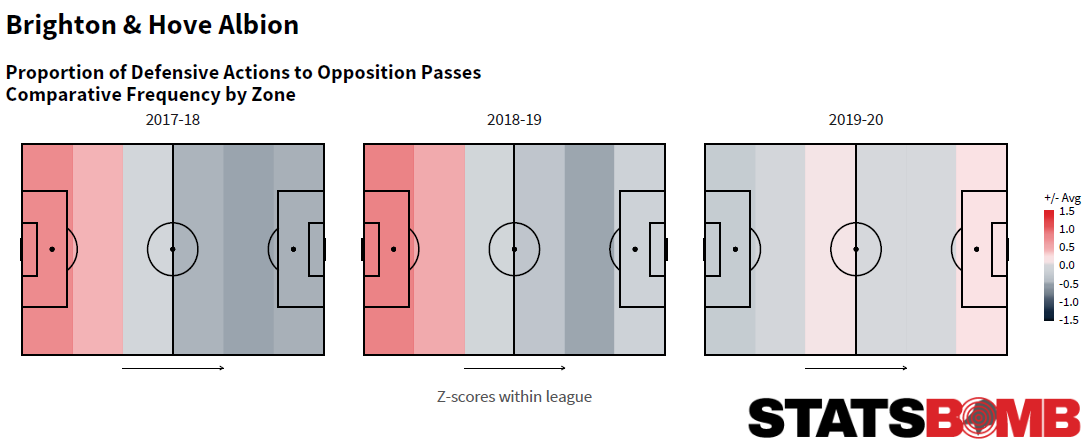 For personnel, the transition from the first season in the league to the second was stark. Lots of relatively low priced players arrived from a wide variety of leagues in year one--and few made the team with any regularity. It was easy to wonder if Hughton, detached from recruitment, was interested in playing the players he rated rather than new signings, but Potter has followed a similar thread, and few of that first tranche, Dan Burn, Yves Bissoma and Martin Montoya apart featured heavily in 2019-20. Potter’s first summer saw more targeted signings and less variety with all but Leandro Trossard arriving from within the English game. Adam Webster, Neal Maupay and Trossard all featured heavily and validated their purchases while Aaron Mooy eventually converted from a loan and Tariq Lamptey was a neat January pickup who quickly featured. Brighton have moved quickly again this summer adding distinct quality--with a sideline of injury concern and post-peak aging--in Adam Lallana. With Mooy heading for Shanghai, it appears reasonable to assume that Lallana will effectively take his place in the squad and overall this summer feels more like squad evolution than revolution. Joël Veltman arrived from Ajax for a tiny fee and the bones of Wigan were examined to take young midfielder Jensen Weir. Veltman’s arrival, specifically, gave Brighton a wildly overstocked centre back department. Adam Webster and Lewis Dunk were the main starters last season with Shane Duffy as an alternative. Ben White spent the season starring on loan at Leeds, while Matt Clarke similarly had a great time on loan at Derby. Dan Burn converted into a left back to get game time, but negotiating this corps ahead of the new season is not easy, with all mentioned likely worthy of playing regular football at a level near to that which Brighton require. White finally signed a new contract recently while Clarke returned to Derby on loan and Duffy headed across the border to Celtic, but there's still a surplus here. Either another move is imminent or someone's going to miss out on substantial minutes. Overall though it feels like there's a degree of continuity being sought. Investments in players of the right age to progress in the long term have been made over time. A good example is Neal Maupay who followed up his 25-goal Brentford season with 10 in the Premier League. He scopes out at around a one in three striker here, which is closer to average than you may think, and adds further value from the volume of defensive work he does leading from the front. He's an interesting reference point for other strikers making the step up in leagues:
For personnel, the transition from the first season in the league to the second was stark. Lots of relatively low priced players arrived from a wide variety of leagues in year one--and few made the team with any regularity. It was easy to wonder if Hughton, detached from recruitment, was interested in playing the players he rated rather than new signings, but Potter has followed a similar thread, and few of that first tranche, Dan Burn, Yves Bissoma and Martin Montoya apart featured heavily in 2019-20. Potter’s first summer saw more targeted signings and less variety with all but Leandro Trossard arriving from within the English game. Adam Webster, Neal Maupay and Trossard all featured heavily and validated their purchases while Aaron Mooy eventually converted from a loan and Tariq Lamptey was a neat January pickup who quickly featured. Brighton have moved quickly again this summer adding distinct quality--with a sideline of injury concern and post-peak aging--in Adam Lallana. With Mooy heading for Shanghai, it appears reasonable to assume that Lallana will effectively take his place in the squad and overall this summer feels more like squad evolution than revolution. Joël Veltman arrived from Ajax for a tiny fee and the bones of Wigan were examined to take young midfielder Jensen Weir. Veltman’s arrival, specifically, gave Brighton a wildly overstocked centre back department. Adam Webster and Lewis Dunk were the main starters last season with Shane Duffy as an alternative. Ben White spent the season starring on loan at Leeds, while Matt Clarke similarly had a great time on loan at Derby. Dan Burn converted into a left back to get game time, but negotiating this corps ahead of the new season is not easy, with all mentioned likely worthy of playing regular football at a level near to that which Brighton require. White finally signed a new contract recently while Clarke returned to Derby on loan and Duffy headed across the border to Celtic, but there's still a surplus here. Either another move is imminent or someone's going to miss out on substantial minutes. Overall though it feels like there's a degree of continuity being sought. Investments in players of the right age to progress in the long term have been made over time. A good example is Neal Maupay who followed up his 25-goal Brentford season with 10 in the Premier League. He scopes out at around a one in three striker here, which is closer to average than you may think, and adds further value from the volume of defensive work he does leading from the front. He's an interesting reference point for other strikers making the step up in leagues: 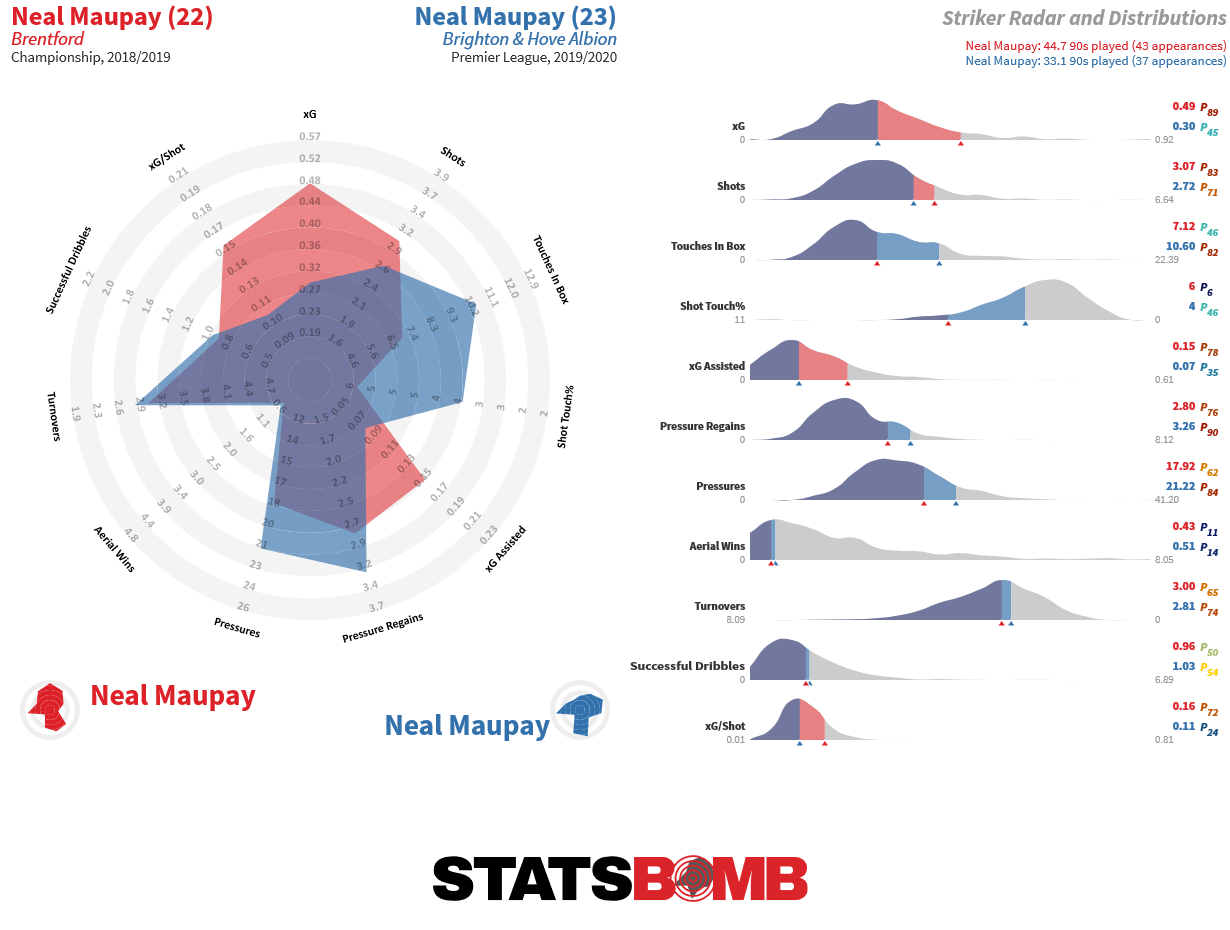 Projection Improved metrics under Potter have led to a projection of safety in the Sporting Index opening lines. They landed at around 42-43 points here which would represent a perfectly adequate return. However, one has to wonder what the long term plan is? It's still early days for Brighton in the Premier League, but projecting to low 40s still puts a team in the realm of risk for relegation. As such, it feels like from a performance evaluation perspective Potter may need to eke out further progress, if not this season then soon. His first season was entirely fine, and avoiding any relegation battle should be the target again, but Brighton aren't quite good enough yet to ease off the gas and naturally land mid-table security. In recent seasons, Bournemouth laid a useful blueprint for a smaller club playing a style that backed their on ball ability, but also their inability to adapt that over time eventually saw them vulnerable in a down year, and they paid the price. Brighton and Potter would do well to heed the lessons dealt out there.
Projection Improved metrics under Potter have led to a projection of safety in the Sporting Index opening lines. They landed at around 42-43 points here which would represent a perfectly adequate return. However, one has to wonder what the long term plan is? It's still early days for Brighton in the Premier League, but projecting to low 40s still puts a team in the realm of risk for relegation. As such, it feels like from a performance evaluation perspective Potter may need to eke out further progress, if not this season then soon. His first season was entirely fine, and avoiding any relegation battle should be the target again, but Brighton aren't quite good enough yet to ease off the gas and naturally land mid-table security. In recent seasons, Bournemouth laid a useful blueprint for a smaller club playing a style that backed their on ball ability, but also their inability to adapt that over time eventually saw them vulnerable in a down year, and they paid the price. Brighton and Potter would do well to heed the lessons dealt out there.
If you're a club, media or gambling entity and want to know more about what StatsBomb can do for you, please contact us at Sales@StatsBomb.com We also provide education in this area, so if this taste of football analytics sparked interest, check out our Introduction to Football Analytics course Follow us on twitter in English and Spanish and also on LinkedIn
Leeds United: Season Preview 2020-21
Leeds are back in the top flight after more than a decade and a half away and the consensus seems to be that they are here to stay. Both the mainstream bookmakers and the spread betting markets have them in line for a mid-table finish, and they’ve certainly spent like a team determined to reestablish themselves as a genuine Premier League outfit. James has already written an excellent piece on the club’s promotion campaign, so we won’t go into too much detail about that here, but here are the salient points. Leeds had the best metrics in the Championship for two seasons in a row. After failing to convert that into promotion in 2018-19 due to a bad run of results down the final stretch, they did so in 2019-20, going up as champions. 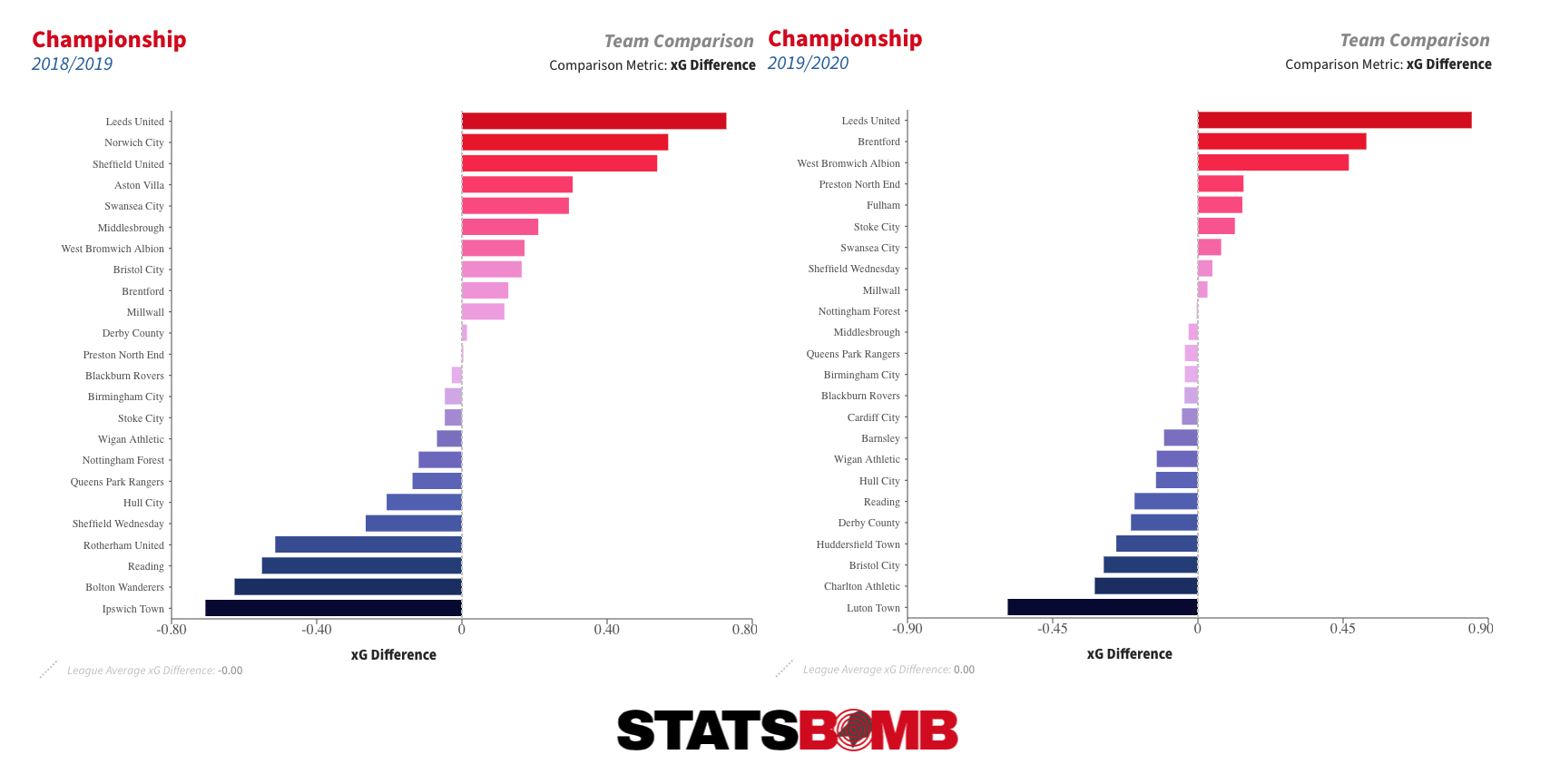 The club’s defensive record was particularly strong. They conceded just 35 times in 46 matches and also had the league’s best metrics. They gave up fewer shots (8.78 per match) than any other side, and the average quality of those shots was also one of the lowest in the division.
The club’s defensive record was particularly strong. They conceded just 35 times in 46 matches and also had the league’s best metrics. They gave up fewer shots (8.78 per match) than any other side, and the average quality of those shots was also one of the lowest in the division. 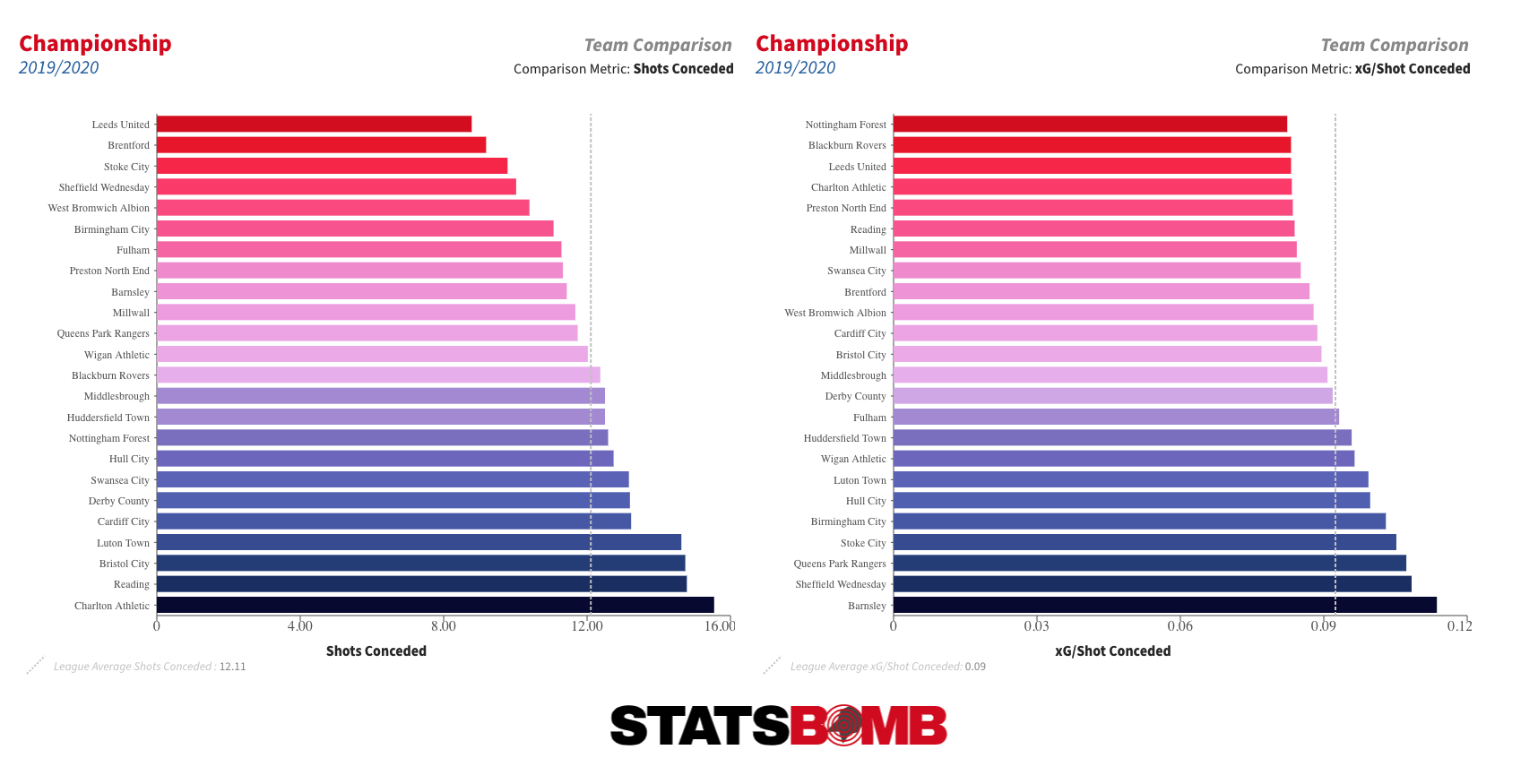 That was partly down to the efficiency of Marcelo Bielsa’s patented all-pitch press. Leeds were relentless in harrying opponents over the length and breadth of the field.
That was partly down to the efficiency of Marcelo Bielsa’s patented all-pitch press. Leeds were relentless in harrying opponents over the length and breadth of the field. 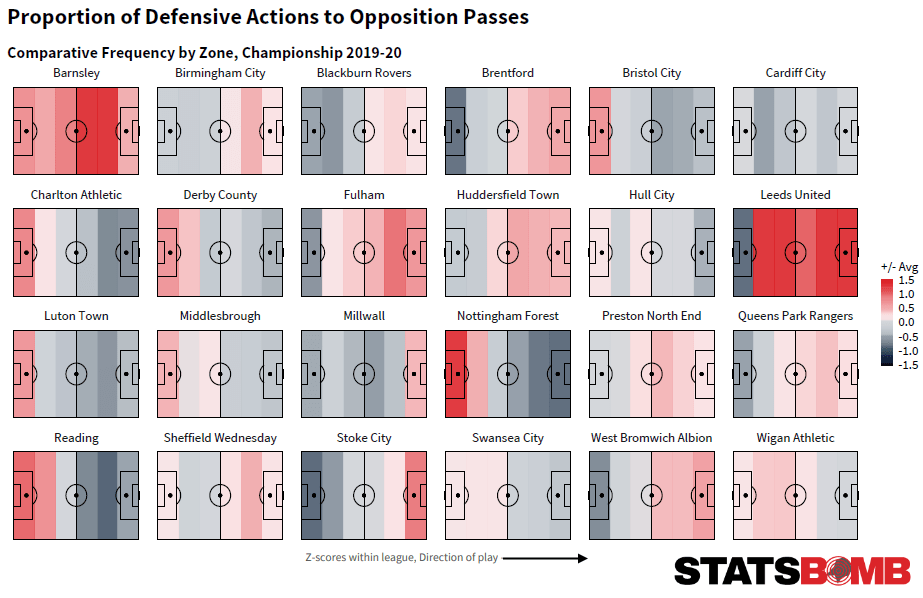 In attack, they comfortably outshot everyone, and did so while still maintaining one of the highest average shot quality marks in the league. All that off-ball movement, the pretty patterns and interchanges, helped to create a high volume of shots from good locations.
In attack, they comfortably outshot everyone, and did so while still maintaining one of the highest average shot quality marks in the league. All that off-ball movement, the pretty patterns and interchanges, helped to create a high volume of shots from good locations. 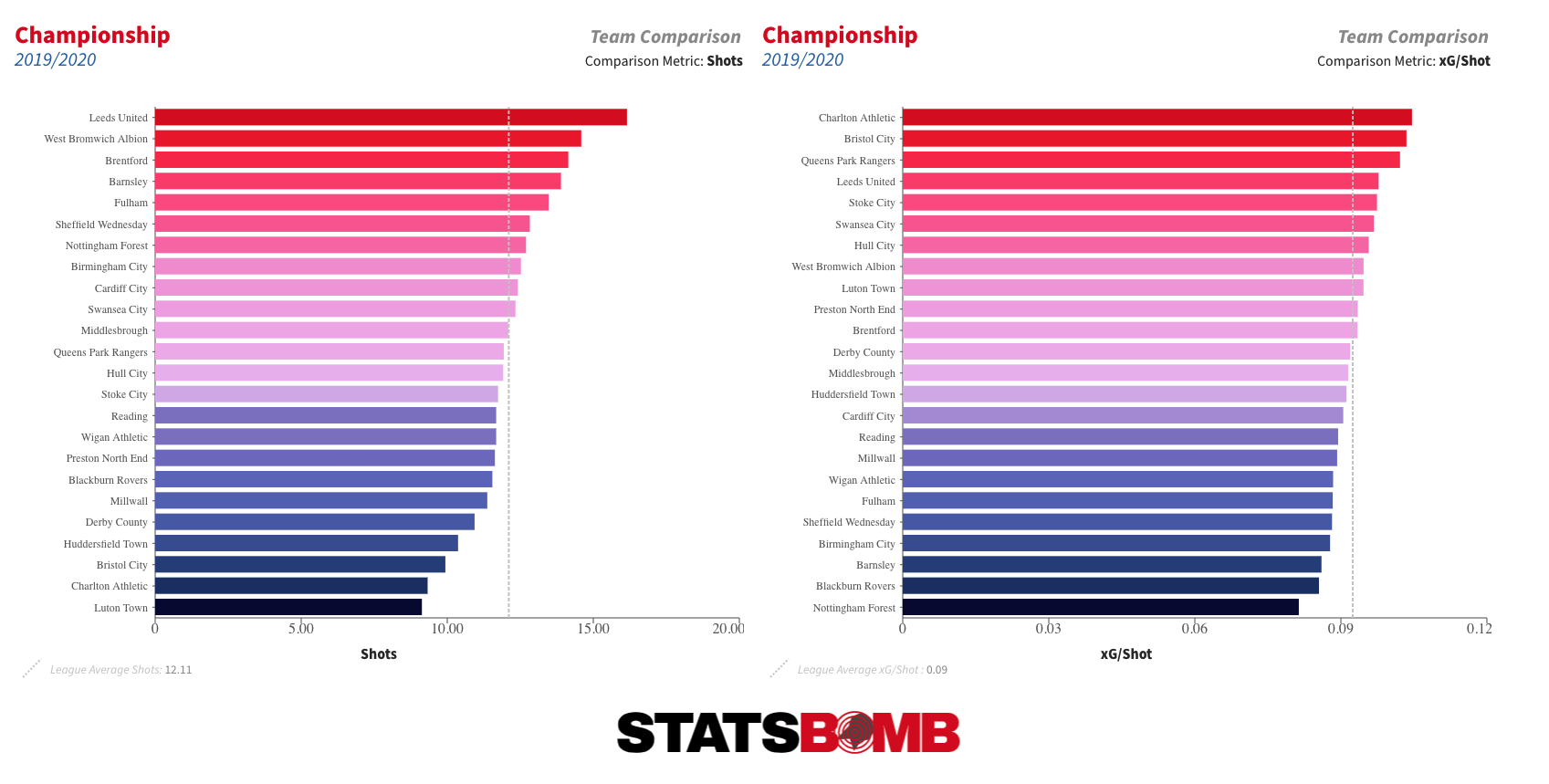 Whichever way you look at it, Leeds were a dominant team, taking 65% of the shots, accumulating 68% of the xG and scoring 69% of the goals in their matches. A clearly defined play style, strong overall metrics and a solid defensive base are all generally predictive of a good first campaign in the top flight. To illustrate this point, over the last 10 years, only two teams have been promoted with a better average goal difference per match than Leeds’ figure of 0.91: Newcastle in 2016-17 and Wolverhampton Wanderers in 2017-18. Like Leeds, both conceded under a goal per match during their promotion campaigns. Both went on to only concede around 17% more goals in the Premier League, compared to an average for promoted teams of around 40%, and both finished in the top 10. Leeds have a good base to work from, and they've also been able to retain almost all of the important squad members from their promotion campaign. Hélder Costa and young goalkeeper Illan Meslier, who got a run of games as first choice after lockdown due to Kiko Casilla’s suspension for racist language, have both had their loans turned into permanent deals. Jack Harrison will stay on board for another season on loan from Manchester City. The one key departure is that of Brighton loanee Ben White. He started all 46 matches last season, and became a key figure in the centre of defence, impressing on both sides of the ball. Reports suggest that Leeds were keen to sign him permanently, but Brighton instead decided to bring him back into the fold there. It was, therefore, unsurprising that one of the club’s first off-season signings was Robin Koch, a 24-year-old central defender from Freiburg in the Bundesliga, capped three times by Germany. White was the more proactive defender in his regular partnership with Liam Cooper, stepping forward more often to contest possession and intercept, both on a outright basis and proportionally to all defensive actions when they started together in the centre of defence. Cooper cleaned up behind and was a dominant aerial force. Koch seems to profile more like Cooper than White, with a lesser proportion of proactive defensive actions than the man he replaces. But it is important to add some context here. Freiburg were one of the most passive and deep-defending teams in the Bundesliga last season, and Koch often played as the central of three central defenders. In such a system, it is entirely normal for the player in that role to be the least proactive of the three. As such, it is hard to get a handle on just how apt a White replacement he is from the data. Their passing profiles are more similar, and Koch does seem to have solid range there. Qualitative scouting has presumably left the recruitment team confident that he can slot into White’s role. Cooper was again the less proactive element in his partnership with Pontus Jansson in 2018-19, so there is little evidence he’d be capable of defending in a different manner. As well as Koch, Leeds have also signed a trio of younger players in Charlie Allen (16), Cody Drameh (18) and Joe Gelhardt (18), the latter of whom posted good shot volume in a very limited sample size of just over 500 minutes at Wigan in the Championship last season. But the big money has been spent on the club-record, £27 million signing of Rodrigo from Valencia. Readers with good memories may recall Rodrigo from his one-season loan at Bolton Wanderers back in 2010-11, but the player who arrives at Elland Road has developed considerably since then and is now a full Spain international. He, like the entire Valencia team, didn’t have a great time of it last season, but in 2018-19, he provided a goal or assist for every 180 minutes he was on the pitch in terms of both real and expected output.
Whichever way you look at it, Leeds were a dominant team, taking 65% of the shots, accumulating 68% of the xG and scoring 69% of the goals in their matches. A clearly defined play style, strong overall metrics and a solid defensive base are all generally predictive of a good first campaign in the top flight. To illustrate this point, over the last 10 years, only two teams have been promoted with a better average goal difference per match than Leeds’ figure of 0.91: Newcastle in 2016-17 and Wolverhampton Wanderers in 2017-18. Like Leeds, both conceded under a goal per match during their promotion campaigns. Both went on to only concede around 17% more goals in the Premier League, compared to an average for promoted teams of around 40%, and both finished in the top 10. Leeds have a good base to work from, and they've also been able to retain almost all of the important squad members from their promotion campaign. Hélder Costa and young goalkeeper Illan Meslier, who got a run of games as first choice after lockdown due to Kiko Casilla’s suspension for racist language, have both had their loans turned into permanent deals. Jack Harrison will stay on board for another season on loan from Manchester City. The one key departure is that of Brighton loanee Ben White. He started all 46 matches last season, and became a key figure in the centre of defence, impressing on both sides of the ball. Reports suggest that Leeds were keen to sign him permanently, but Brighton instead decided to bring him back into the fold there. It was, therefore, unsurprising that one of the club’s first off-season signings was Robin Koch, a 24-year-old central defender from Freiburg in the Bundesliga, capped three times by Germany. White was the more proactive defender in his regular partnership with Liam Cooper, stepping forward more often to contest possession and intercept, both on a outright basis and proportionally to all defensive actions when they started together in the centre of defence. Cooper cleaned up behind and was a dominant aerial force. Koch seems to profile more like Cooper than White, with a lesser proportion of proactive defensive actions than the man he replaces. But it is important to add some context here. Freiburg were one of the most passive and deep-defending teams in the Bundesliga last season, and Koch often played as the central of three central defenders. In such a system, it is entirely normal for the player in that role to be the least proactive of the three. As such, it is hard to get a handle on just how apt a White replacement he is from the data. Their passing profiles are more similar, and Koch does seem to have solid range there. Qualitative scouting has presumably left the recruitment team confident that he can slot into White’s role. Cooper was again the less proactive element in his partnership with Pontus Jansson in 2018-19, so there is little evidence he’d be capable of defending in a different manner. As well as Koch, Leeds have also signed a trio of younger players in Charlie Allen (16), Cody Drameh (18) and Joe Gelhardt (18), the latter of whom posted good shot volume in a very limited sample size of just over 500 minutes at Wigan in the Championship last season. But the big money has been spent on the club-record, £27 million signing of Rodrigo from Valencia. Readers with good memories may recall Rodrigo from his one-season loan at Bolton Wanderers back in 2010-11, but the player who arrives at Elland Road has developed considerably since then and is now a full Spain international. He, like the entire Valencia team, didn’t have a great time of it last season, but in 2018-19, he provided a goal or assist for every 180 minutes he was on the pitch in terms of both real and expected output. 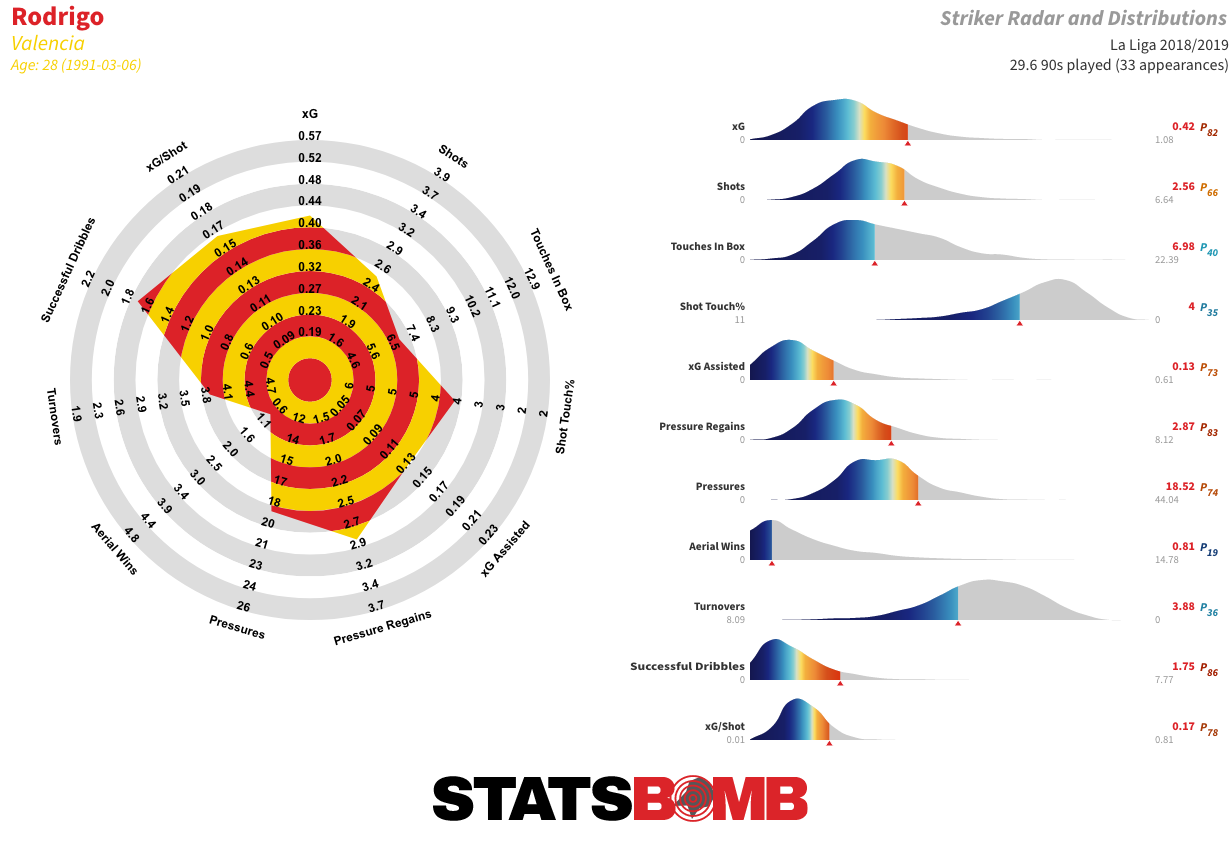 Valencia were a counter-attacking team and Rodrigo was often a key part of their forward transitions, dropping off the front to receive, turn and combine with onward runners. Quick and intelligent in his movements, he has a skillset that should mesh well with Bielsa’s system, even if, as with Koch, he comes in from a team considerably less aggressive out of possession than this current Leeds side. The age profile isn’t great, but he should prove to be a direct improvement on Patrick Bamford at the centre of the attack. Leeds have also shown strong interest in Rodrigo de Paul, a creative midfielder who has been pretty consistently good at Udinese over the last couple of seasons. He doesn’t provide a great deal of defensive output, but the old Bielsa motto of it being easier to teach a talented player to run than make an energetic player talented may just ring true here. He would certainly represent an upgrade in one of the two more advanced midfield roles in the 4-1-4-1/4-3-3 that has served Leeds so well over the last couple of seasons.
Valencia were a counter-attacking team and Rodrigo was often a key part of their forward transitions, dropping off the front to receive, turn and combine with onward runners. Quick and intelligent in his movements, he has a skillset that should mesh well with Bielsa’s system, even if, as with Koch, he comes in from a team considerably less aggressive out of possession than this current Leeds side. The age profile isn’t great, but he should prove to be a direct improvement on Patrick Bamford at the centre of the attack. Leeds have also shown strong interest in Rodrigo de Paul, a creative midfielder who has been pretty consistently good at Udinese over the last couple of seasons. He doesn’t provide a great deal of defensive output, but the old Bielsa motto of it being easier to teach a talented player to run than make an energetic player talented may just ring true here. He would certainly represent an upgrade in one of the two more advanced midfield roles in the 4-1-4-1/4-3-3 that has served Leeds so well over the last couple of seasons. 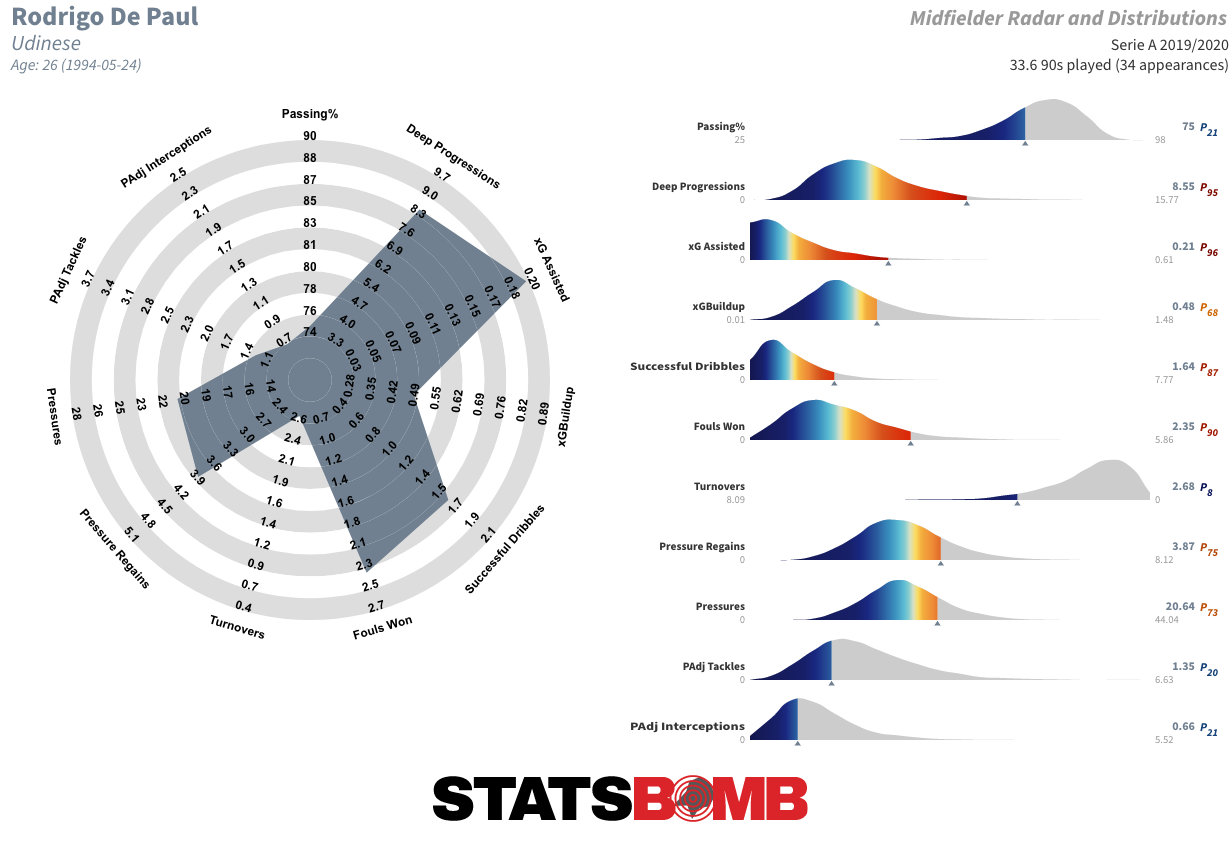 Maintaining a stable squad while upgrading in key positions seems a sensible way of confronting the club’s first Premier League season in 16 years, even though there is still a degree of uncertainty in terms of the performance levels that can be expected from some of the existing squad members. Many of these players were, after all, involved in a mid-table Championship finish in the season before Bielsa’s arrival. Any individual deficiencies will be that much clearer in the top flight. With that said, the front-foot style of play of the collective should be sufficient to get Leeds enough points from some of the league’s blander teams to provide a solid platform for a mid-table finish. Theirs is an exciting approach and it will be intriguing to see how they fare in their attempts to go toe-to-toe with teams towards the top of the table. An opening day trip to Anfield and champions Liverpool will give us an early taste of what to expect.
Maintaining a stable squad while upgrading in key positions seems a sensible way of confronting the club’s first Premier League season in 16 years, even though there is still a degree of uncertainty in terms of the performance levels that can be expected from some of the existing squad members. Many of these players were, after all, involved in a mid-table Championship finish in the season before Bielsa’s arrival. Any individual deficiencies will be that much clearer in the top flight. With that said, the front-foot style of play of the collective should be sufficient to get Leeds enough points from some of the league’s blander teams to provide a solid platform for a mid-table finish. Theirs is an exciting approach and it will be intriguing to see how they fare in their attempts to go toe-to-toe with teams towards the top of the table. An opening day trip to Anfield and champions Liverpool will give us an early taste of what to expect.
If you're a club, media or gambling entity and want to know more about what StatsBomb can do for you, please contact us at Sales@StatsBomb.com We also provide education in this area, so if this taste of football analytics sparked interest, check out our Introduction to Football Analytics course Follow us on twitter in English and Spanish and also on LinkedIn
Southampton: Season Preview 2020-21
During the opening few weeks of 2019-20, Ralph Hasenhüttl mixed up his formations a little. The well-remembered Leicester game was the sixth time in ten matches that Southampton started with a variation involving three centre backs. That game wasn’t the final straw--two more games took place before an international break, but when Southampton came back to face Arsenal on the 23rd November, they played a version of 4-4-2. And from that point on they stuck to it. The reason for this change was clear enough: Southampton were 19th and on a run of no wins in seven. If ever there’s a good time to refocus thoughts, then languishing in the relegation places with your job under threat is it and Hasenhüttl quickly went back to basics. From that point on, Southampton pressed more frequently (led the league in volume of pressure events), timed their pressure events more aptly (led the league for counterpressure events), were more aggressive in closing down opponent pass receipts than any other team (29%) and had the lowest pass per defensive action value. Results improved and quickly: a 2-2-8 start gave way to a 8-2-7 run pre-Covid break and 5-3-1 afterwards. Metrics generally followed suit too with a -0.4xG difference per 90 in that weak period switching round to +0.18 for the rest of the season (albeit the post-Covid metrics lagged behind good results). However you slice it though, once Hasenhüttl went to his pressing 4-4-2, Southampton were pretty good, around the sixth or seventh best team in the league. 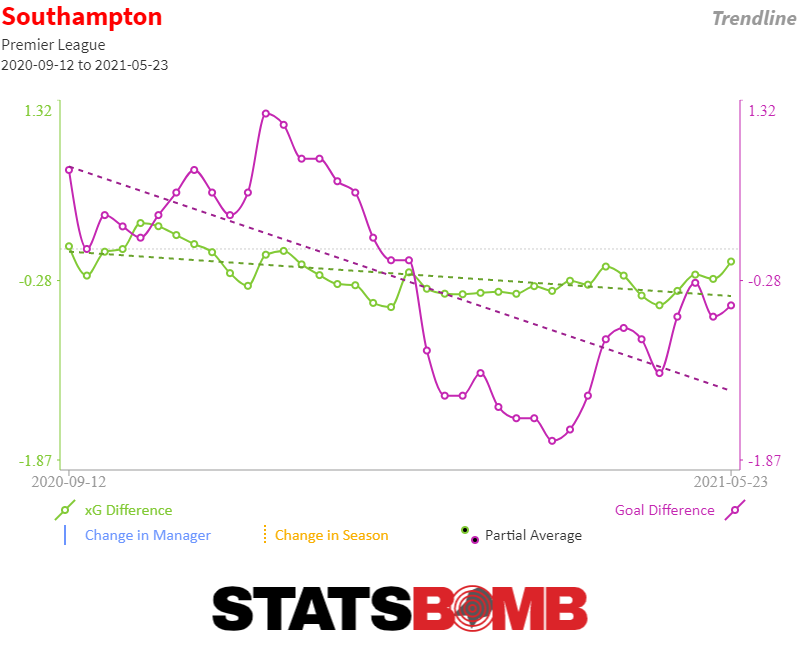 There were bad games across the season, and that rather impacted the metrics as a whole. Seven times Southampton gave up large xG totals (around 2.5 and up) in individual games. Some of them were understandable; both Manchester City games, Liverpool away and the 9-0, but it also occurred in back to back games just before the Covid break away to West Ham and home to Newcastle (thanks to Moussa Djenepo's first half red card) and then at home to Arsenal after the restart:
There were bad games across the season, and that rather impacted the metrics as a whole. Seven times Southampton gave up large xG totals (around 2.5 and up) in individual games. Some of them were understandable; both Manchester City games, Liverpool away and the 9-0, but it also occurred in back to back games just before the Covid break away to West Ham and home to Newcastle (thanks to Moussa Djenepo's first half red card) and then at home to Arsenal after the restart: 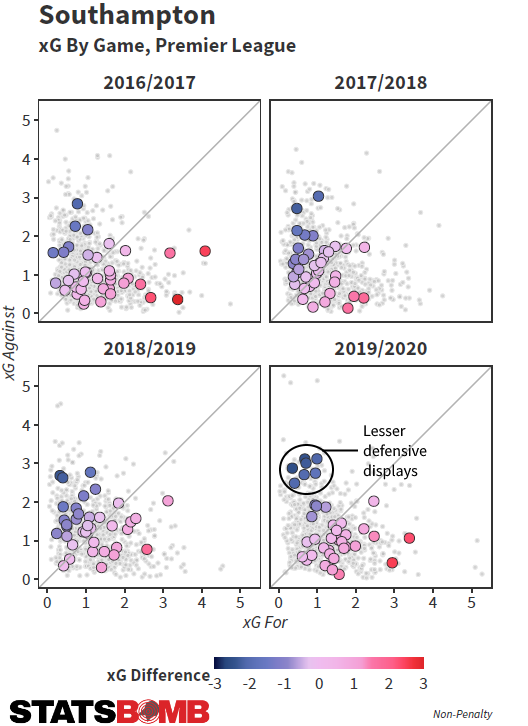 There's little doubt that this kind of vulnerability can be a by-product of games in which pressing teams are outmaneuvered. The Liverpool away game is a great example, as the team competed really well in the first half but Liverpool exerted themselves as the game wore on and won 4-0. The passing network from that game shows the generally equal balance of the game in regard to possession locations, which is unusual for a team against Liverpool. Another real rarity was Trent Alexander-Arnold getting pushed right back into the er... right back slot:
There's little doubt that this kind of vulnerability can be a by-product of games in which pressing teams are outmaneuvered. The Liverpool away game is a great example, as the team competed really well in the first half but Liverpool exerted themselves as the game wore on and won 4-0. The passing network from that game shows the generally equal balance of the game in regard to possession locations, which is unusual for a team against Liverpool. Another real rarity was Trent Alexander-Arnold getting pushed right back into the er... right back slot: 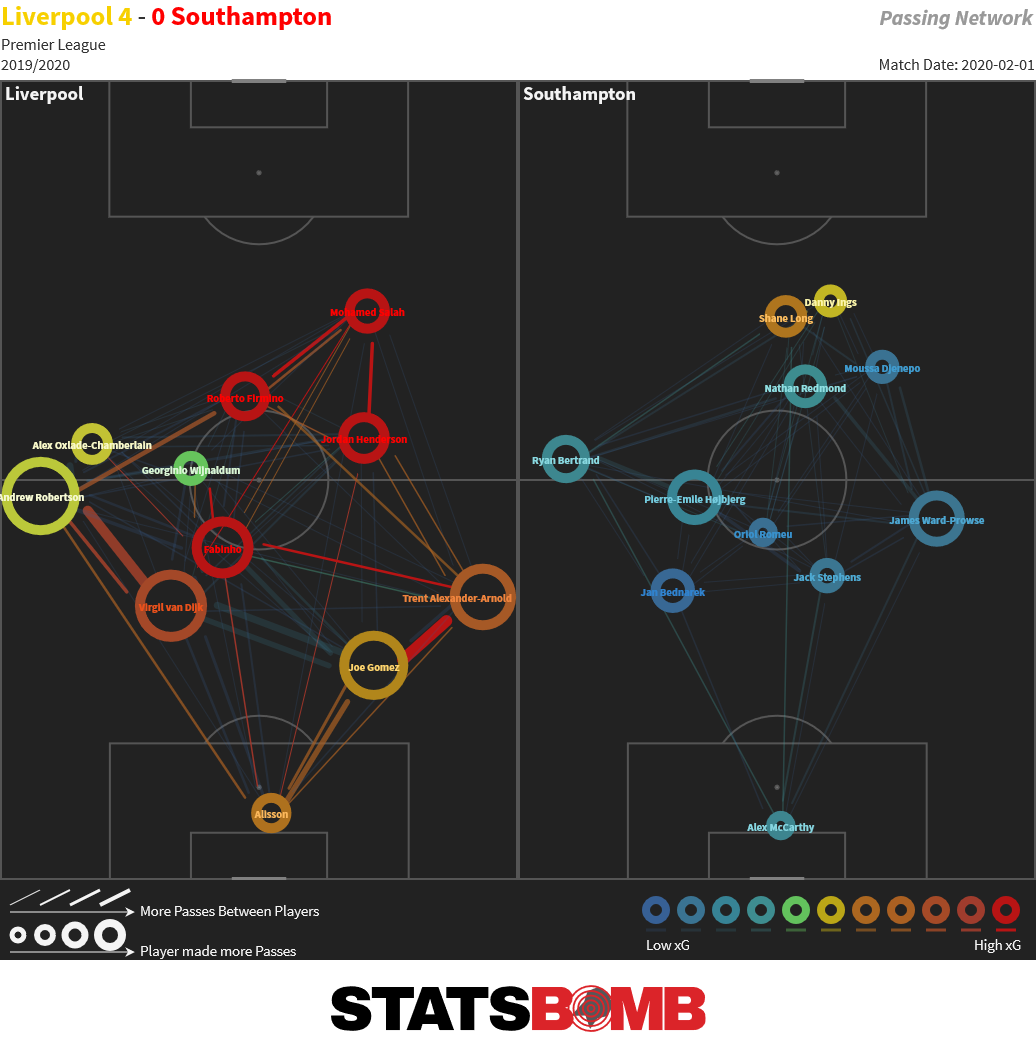 Southampton’s season was gilded by a phenomenal season from Danny Ings. He scored 22 goals in the league (21+1 penalty) from an expected rate of close to 16, but more remarkable was his sheer consistency. Across the past four seasons, only Mohamed Salah in 2017-18 has scored a non-penalty goal in over half a team’s games in a season (23 separate games), Ings is second on that list having notched in 19. If you sat down to watch a Southampton game in 2019-20 it was a literal coin flip whether or not you’d see an Ings goal. He only scored one header and was not adept at getting on the end of crosses from open play, but otherwise scored a likeable variation of goals: tap-ins, off throughballs, after beating a defender to make space or a shot, from longer range and with both feet.
Southampton’s season was gilded by a phenomenal season from Danny Ings. He scored 22 goals in the league (21+1 penalty) from an expected rate of close to 16, but more remarkable was his sheer consistency. Across the past four seasons, only Mohamed Salah in 2017-18 has scored a non-penalty goal in over half a team’s games in a season (23 separate games), Ings is second on that list having notched in 19. If you sat down to watch a Southampton game in 2019-20 it was a literal coin flip whether or not you’d see an Ings goal. He only scored one header and was not adept at getting on the end of crosses from open play, but otherwise scored a likeable variation of goals: tap-ins, off throughballs, after beating a defender to make space or a shot, from longer range and with both feet. 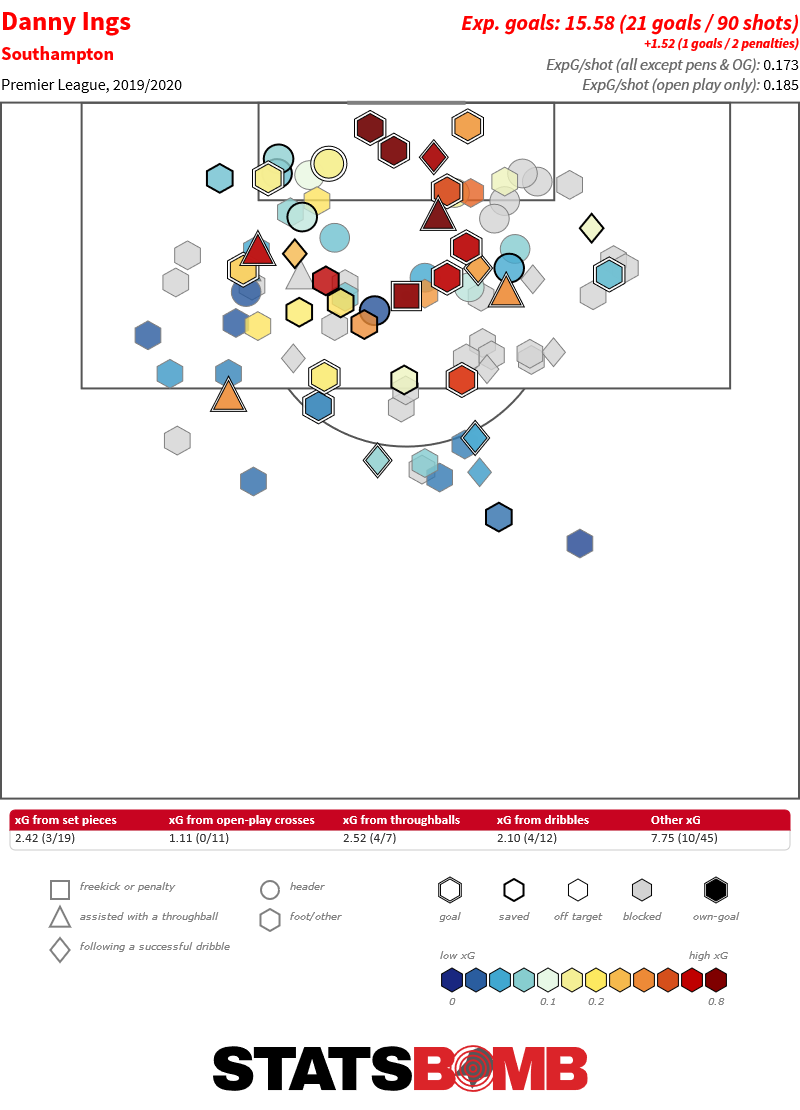 He also led the press: his 25 pressure events per game was highest in the team. Loads of goals, loads of work rate. What’s not to like? He didn’t create much with his passing, but nor did anyone else, that's just not how this team creates. The team pushed high, won the ball back and grabbed shots--they ranked fifth behind the top four sides for shots directly generated from a high press at over three per game. We can see how Southampton have evolved over four seasons here, or at least how Hasenhüttl's tenure has built the press from the front. They're more active high up the pitch than at any time since (to my surprise) Claude Puel in 2016-17, and the pattern in how they play now is very clear:
He also led the press: his 25 pressure events per game was highest in the team. Loads of goals, loads of work rate. What’s not to like? He didn’t create much with his passing, but nor did anyone else, that's just not how this team creates. The team pushed high, won the ball back and grabbed shots--they ranked fifth behind the top four sides for shots directly generated from a high press at over three per game. We can see how Southampton have evolved over four seasons here, or at least how Hasenhüttl's tenure has built the press from the front. They're more active high up the pitch than at any time since (to my surprise) Claude Puel in 2016-17, and the pattern in how they play now is very clear: 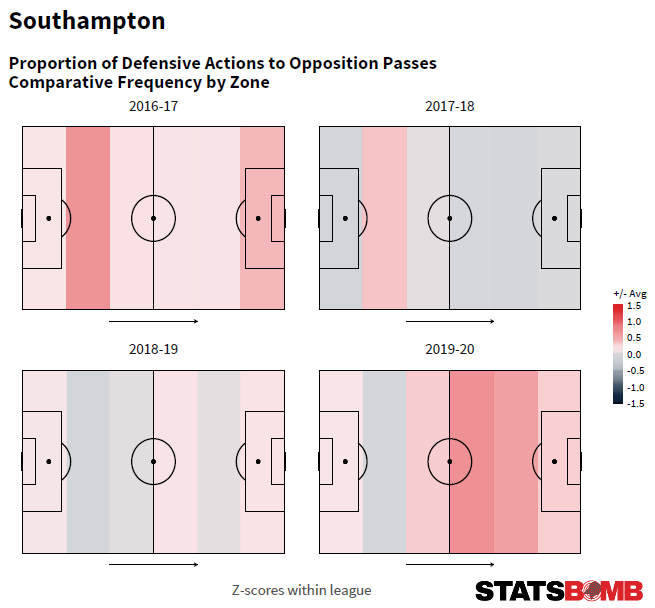 There's a lesson here around lineage and manager recruitment too. It can take time for a manager to get their methods across, even more so if they need to unpick diametrically opposed work done in a different direction by former managers. Having kept faith with Hasenhüttl through a tough period, a concerted and clear style has emerged, with some success. Personnel Southampton have made a couple of early moves in the market to shore up their defence. Kyle Walker-Peters followed up his loan from Tottenham with a permanent move. That a large volume of Tottenham fans were sad to see him depart, feeling he could have been used more over the years is indicative of his general ability. He could easily have been used more in their rotation and should be entirely fine at Southampton, especially with half a season under his belt already. Mohammed Salisu effectively takes Maya Yoshida’s place in the squad and as a young left footed centre back, is a relatively scarce talent within the league, and within this squad. The 6ft3” former Real Valladolid man has just one season of top-flight experience. During that season he was Valladolid’s main back line defender recording significantly higher percentage of defensive clearances than his centre back partners, scarcely being dribbled past but was not error-free, as you might expect from a young centre back. There may be more additions to come. In particular, central midfield looks a little light with Pierre-Emile Højbjerg moving to Tottenham and Harrison Reed and Mario Lemina each landing at Fulham for the forthcoming season at least, instead of returning. There's also some hope to see better in season two from Che Adams and Moussa Djenepo. Both found it hard to gain consistent minutes in 2019-20, but some starts late on saw Adams finally score his first Premier League goal with a kooky 40-yarder against Manchester City and he followed it up with three more before season's end. Meanwhile, Djenepo had a stop-start season with injuries, the loss of his mother and suspension all contributing to reduced time spent on the pitch. when he did play, he showed he wasn't far off the player he showed at Standard Liege:
There's a lesson here around lineage and manager recruitment too. It can take time for a manager to get their methods across, even more so if they need to unpick diametrically opposed work done in a different direction by former managers. Having kept faith with Hasenhüttl through a tough period, a concerted and clear style has emerged, with some success. Personnel Southampton have made a couple of early moves in the market to shore up their defence. Kyle Walker-Peters followed up his loan from Tottenham with a permanent move. That a large volume of Tottenham fans were sad to see him depart, feeling he could have been used more over the years is indicative of his general ability. He could easily have been used more in their rotation and should be entirely fine at Southampton, especially with half a season under his belt already. Mohammed Salisu effectively takes Maya Yoshida’s place in the squad and as a young left footed centre back, is a relatively scarce talent within the league, and within this squad. The 6ft3” former Real Valladolid man has just one season of top-flight experience. During that season he was Valladolid’s main back line defender recording significantly higher percentage of defensive clearances than his centre back partners, scarcely being dribbled past but was not error-free, as you might expect from a young centre back. There may be more additions to come. In particular, central midfield looks a little light with Pierre-Emile Højbjerg moving to Tottenham and Harrison Reed and Mario Lemina each landing at Fulham for the forthcoming season at least, instead of returning. There's also some hope to see better in season two from Che Adams and Moussa Djenepo. Both found it hard to gain consistent minutes in 2019-20, but some starts late on saw Adams finally score his first Premier League goal with a kooky 40-yarder against Manchester City and he followed it up with three more before season's end. Meanwhile, Djenepo had a stop-start season with injuries, the loss of his mother and suspension all contributing to reduced time spent on the pitch. when he did play, he showed he wasn't far off the player he showed at Standard Liege: 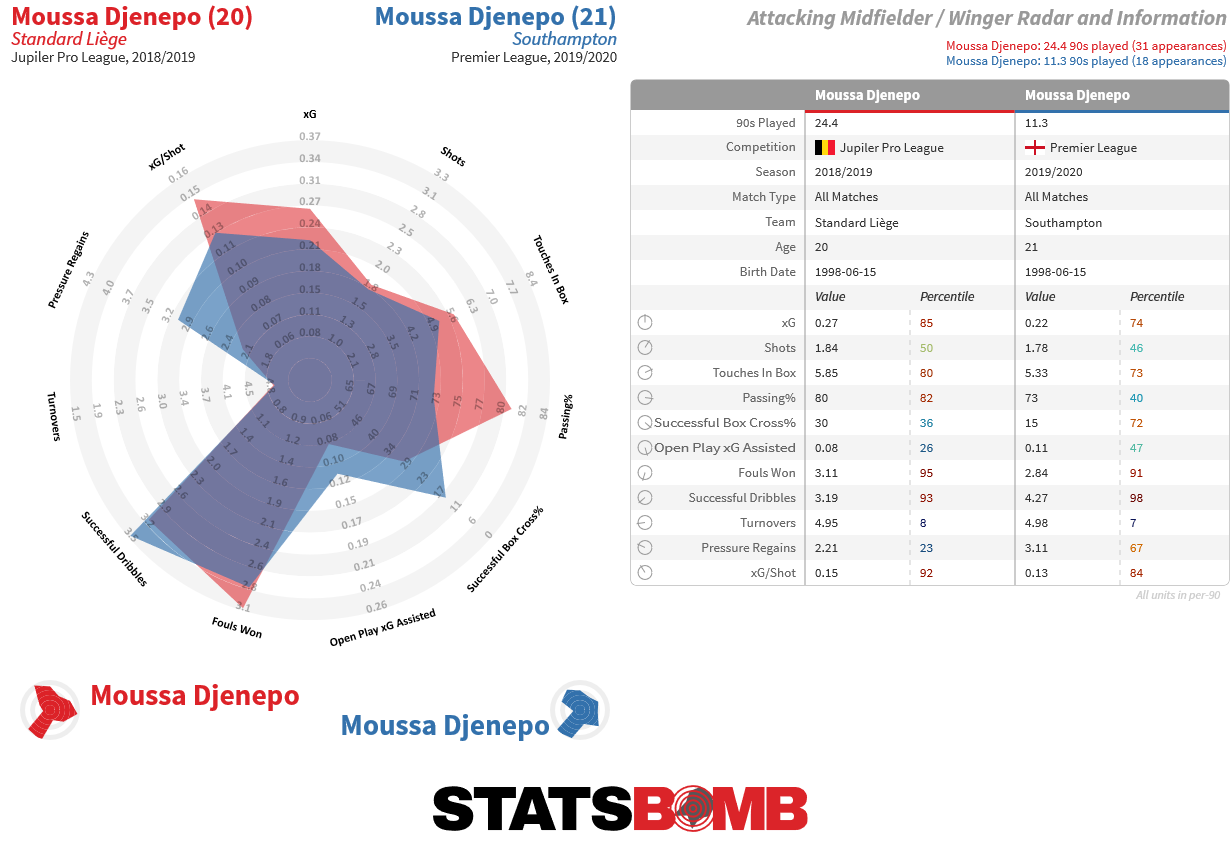 Projection Southampton finished eleventh last season, which represented getting the car back on the tarmac after a couple of seasons of off-roading down the table. All in, raw expected goals rated them eighth best and liked them more than Tottenham and Arsenal. Sporting Index opening lines had them at around 50 points which maroons them in mid-table but would also be completely safe. You don't look at this squad and see the appealing talent levels that led Liverpool to routinely buy Southampton players for so many years, and ironically the one player who made the opposite journey, Ings, is one that will likely have a huge bearing on how Southampton progress this season. If he can stay fit and continue to score at a good clip, it takes the pressure off the midfield, which has been somewhat goalshy for a number of seasons. It is also good for the league that we have a non-elite pressing team competing at a solid level, and Hasenhüttl may not have hit his ceiling here yet. Anything in the top half will represent another good season, and should certainly be the aim.
Projection Southampton finished eleventh last season, which represented getting the car back on the tarmac after a couple of seasons of off-roading down the table. All in, raw expected goals rated them eighth best and liked them more than Tottenham and Arsenal. Sporting Index opening lines had them at around 50 points which maroons them in mid-table but would also be completely safe. You don't look at this squad and see the appealing talent levels that led Liverpool to routinely buy Southampton players for so many years, and ironically the one player who made the opposite journey, Ings, is one that will likely have a huge bearing on how Southampton progress this season. If he can stay fit and continue to score at a good clip, it takes the pressure off the midfield, which has been somewhat goalshy for a number of seasons. It is also good for the league that we have a non-elite pressing team competing at a solid level, and Hasenhüttl may not have hit his ceiling here yet. Anything in the top half will represent another good season, and should certainly be the aim.
If you're a club, media or gambling entity and want to know more about what StatsBomb can do for you, please contact us at Sales@StatsBomb.com We also provide education in this area, so if this taste of football analytics sparked interest, check out our Introduction to Football Analytics course Follow us on twitter in English and Spanish and also on LinkedIn
Everton: Season Preview 2020-21
The last Everton manager before Carlo Ancelotti with a European trophy on his resume was Howard Kendall. He won the 1984-85 Cup Winner’s Cup for Everton, a clear highlight among a great run for the side in the mid-1980s. Ancelotti’s pedigree is clearly what attracted Everton’s power brokers when making the appointment, much as Jose Mourinho’s glittering history was deemed a match for Tottenham. Everton have spent quite freely in recent seasons with a view to pointing upwards, but the man in the hotseat, until now, had not fit the description of “serial winner”. Ancelotti changes that dynamic and ahead of his first full season, there is obvious pressure to get the best from his squad. Leicester were the team that managed to profit in 2019-20 from a couple of big teams hitting down years. Everton’s aspiration has to be to do similar in 2020-21. But can they do it? The base they are launching from is not high. A twelfth placed finish was the lowest Everton had recorded since 2003-04 and the whole season was hand-braked by a run of poor form under Marco Silva. He left the club after securing 14 points in 15 games and with the team in 18th place. Ancelotti’s subsequent tenure saw the club pick up points at a rate of close to 1.5 per game--57 points over a full season. This pegs the level that he’s achieved slightly ahead of the average of the last six seasons, a useful line in the sand since Roberto Martinez logged a huge 72 points in 2013-14. Within that season too: the last time Everton beat a big six club in a league fixture away from Goodison Park, a 1-0 win over David Moyes’ Manchester United. These are the type of challenges that the team must overcome if it is to move upwards. From a metric perspective Everton’s season was well… variable: 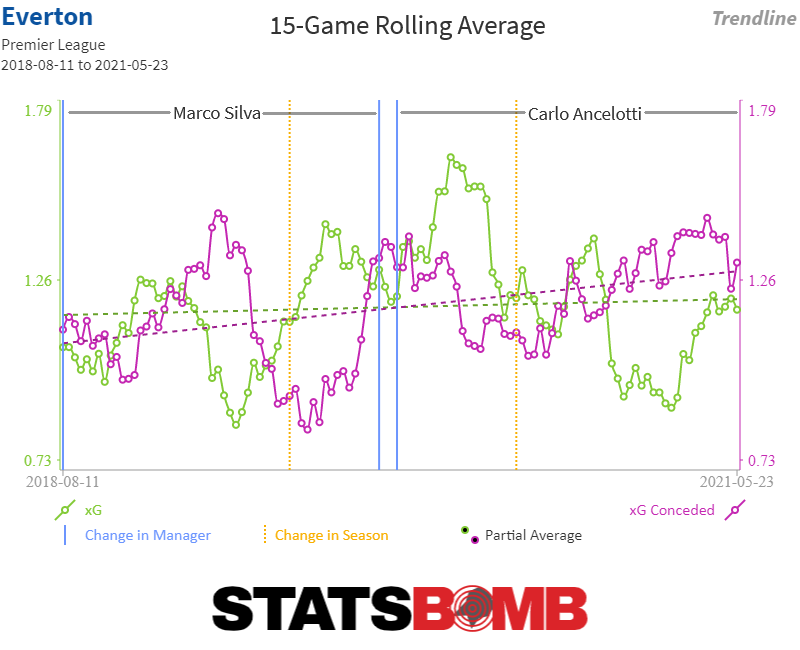 The first stretch for Marco Silva involved a big skew where results failed to overcome declining expected numbers, which ultimately did for him. The period that Ancelotti oversaw from late December to the Covid break was genuinely good: a 5-3-3 record was scant reward for third best in the league expected metrics (+0.7xG per game vs a flat, zero actual goal difference). Then in the New World, metrics declined, in particular in attack. The positive read of all this is that the good Ancelotti period was extremely promising. The negative read is more a question of why couldn’t they get anywhere near those heights in June and July? It’s fundamentally erroneous to draw lines based on player participation, so I will not point out that Fabian Delph started a lot of games in the good period and Andre Gomes played more in the bad. The whole before/after Covid break dichotomy is an added layer that makes projecting teams in 2020-21 an ever more hazardous procedure and it would not be surprising if a variety of teams played out the season with half an eye on the autumn and this restart. Personnel Everton have been far from shy in the transfer market in recent seasons, and their recruitment has had a mixed outcome. Marcel Brands was tasked with emerging from the weight that Steve Walsh’s tenure left on the club’s roster, and has made some pointed and valuable moves. Richarlison remains a certain hit, Lucas Digne has grown into one of the better two-way full backs in the league and while Delph isn’t one for the future, he was a relatively cheap and experienced player to slot into the midfield. Elsewhere, Andre Gomes remains elegant on the ball, but probably needs to be less elegant off the ball. Moise Kean is still very young and without the yips (two goals from over four xG) might have raised more eyebrows in first season from which he emerged from the bench most frequently, while Alex Iwobi needs to get back his creative boots if he’s going to continue to mini-Özil his way through life and scarcely shoot. On paper, at least, Jean-Philippe Gbamin was the answer to some of Everton’s issues around their midfield, but the poor guy is already out til 2021 and has undergone his third operation in a luckless run at the club. With a surfeit of centre forwards and winger types on the books, and mixed impact and bad luck in midfield, it's straightforward to identify where to strengthen, and Everton have followed that obvious route. Allan was the first through the door, a veteran of Ancelotti's Napoli tenure and a player who who has long provided great energy from midfield:
The first stretch for Marco Silva involved a big skew where results failed to overcome declining expected numbers, which ultimately did for him. The period that Ancelotti oversaw from late December to the Covid break was genuinely good: a 5-3-3 record was scant reward for third best in the league expected metrics (+0.7xG per game vs a flat, zero actual goal difference). Then in the New World, metrics declined, in particular in attack. The positive read of all this is that the good Ancelotti period was extremely promising. The negative read is more a question of why couldn’t they get anywhere near those heights in June and July? It’s fundamentally erroneous to draw lines based on player participation, so I will not point out that Fabian Delph started a lot of games in the good period and Andre Gomes played more in the bad. The whole before/after Covid break dichotomy is an added layer that makes projecting teams in 2020-21 an ever more hazardous procedure and it would not be surprising if a variety of teams played out the season with half an eye on the autumn and this restart. Personnel Everton have been far from shy in the transfer market in recent seasons, and their recruitment has had a mixed outcome. Marcel Brands was tasked with emerging from the weight that Steve Walsh’s tenure left on the club’s roster, and has made some pointed and valuable moves. Richarlison remains a certain hit, Lucas Digne has grown into one of the better two-way full backs in the league and while Delph isn’t one for the future, he was a relatively cheap and experienced player to slot into the midfield. Elsewhere, Andre Gomes remains elegant on the ball, but probably needs to be less elegant off the ball. Moise Kean is still very young and without the yips (two goals from over four xG) might have raised more eyebrows in first season from which he emerged from the bench most frequently, while Alex Iwobi needs to get back his creative boots if he’s going to continue to mini-Özil his way through life and scarcely shoot. On paper, at least, Jean-Philippe Gbamin was the answer to some of Everton’s issues around their midfield, but the poor guy is already out til 2021 and has undergone his third operation in a luckless run at the club. With a surfeit of centre forwards and winger types on the books, and mixed impact and bad luck in midfield, it's straightforward to identify where to strengthen, and Everton have followed that obvious route. Allan was the first through the door, a veteran of Ancelotti's Napoli tenure and a player who who has long provided great energy from midfield: 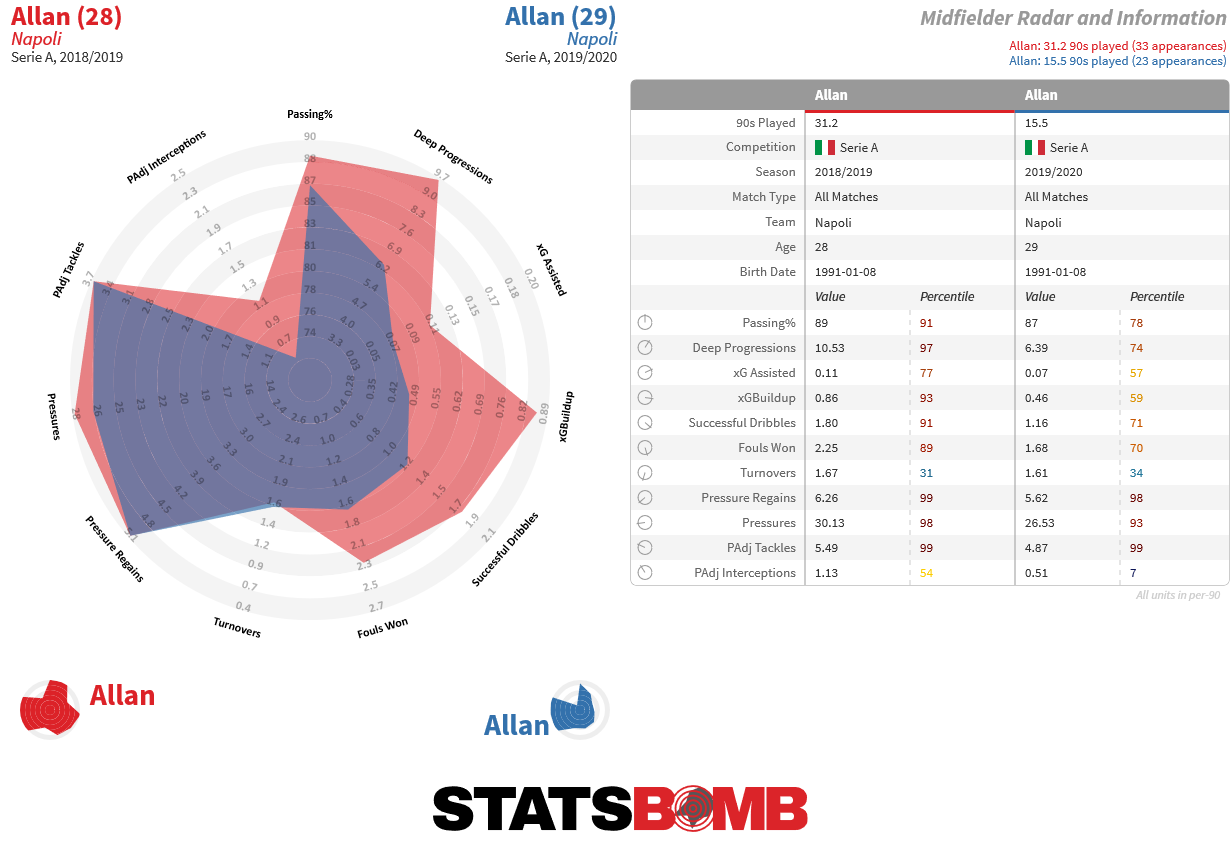 We can see here that 2019-20 under Gennaro Gattuso saw his on the ball metrics drop back, while he maintained extremely high pressure metrics. To be fair, his season was stop-start with niggling injuries and time on the bench impacting his overall game time. There is an understandable degree of caution in that he's soon to turn 30 years old, and the hope here has to be that he can continue to contribute at levels seen prior to last season. However for his stylistic profile, the balance between "he is a great player" and "he is at the wrong end of the age curve" is impossible to deny. Age queries are also something that can be aimed at James Rodriguez, who looks likely to join up this week too. As a former Galactico of sorts, his pedigree is undeniable, and as a creative, flair player, concerns about his residual quality and reliability as he ages are perhaps less than that of Allan. It's really not that long since he was at Bayern putting together a profile like this:
We can see here that 2019-20 under Gennaro Gattuso saw his on the ball metrics drop back, while he maintained extremely high pressure metrics. To be fair, his season was stop-start with niggling injuries and time on the bench impacting his overall game time. There is an understandable degree of caution in that he's soon to turn 30 years old, and the hope here has to be that he can continue to contribute at levels seen prior to last season. However for his stylistic profile, the balance between "he is a great player" and "he is at the wrong end of the age curve" is impossible to deny. Age queries are also something that can be aimed at James Rodriguez, who looks likely to join up this week too. As a former Galactico of sorts, his pedigree is undeniable, and as a creative, flair player, concerns about his residual quality and reliability as he ages are perhaps less than that of Allan. It's really not that long since he was at Bayern putting together a profile like this: 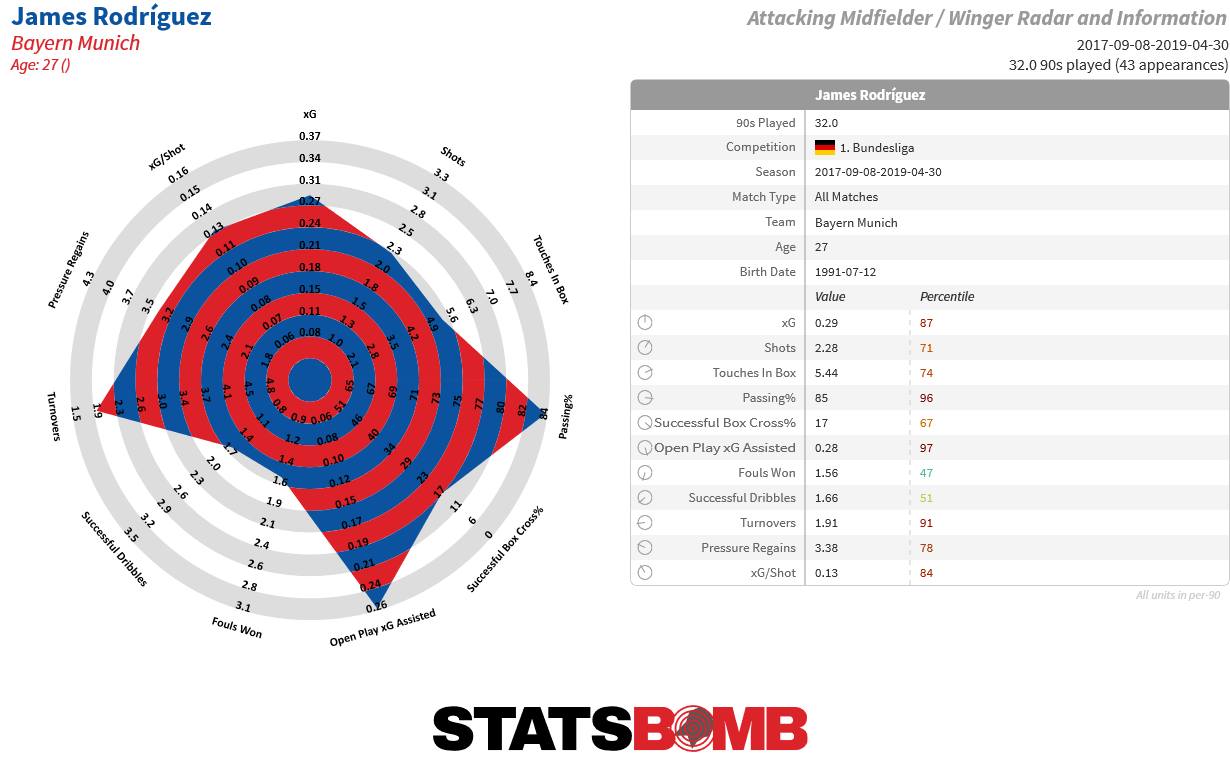 Dominic Calvert-Lewin and Richarlison will undoubtedly be thrilled to see a world class creator teeing up set pieces and throughballs for them. The upgrade here versus Gylfi Sigurðsson is nothing short of huge. The warning when Sigurðsson signed for Everton was that so much of his shot creation was inhabited within set pieces. He got 12 assists for Swansea in 2016-17 and only four were from open play. His actual key pass rate was a shade over 0.5 per game which is miniscule for any nominally creative player. His seasons at Everton have seen this rate broach one per 90 only once (1.03 in 2018-19) and he was back at below 0.5 in 2019-20. James gives you at least as much as Sigurðsson from set-pieces while adding elite open play shot creation numbers on top, reliably over two per game. This difference is shown amply by James' open play key pass chart at Bayern vs that of Sigurðsson last season for Everton. Even allowing for difference of quality in team-mate, the variation is stark and by any stretch, James as an upgrade is hugely enticing. He's also two years younger:
Dominic Calvert-Lewin and Richarlison will undoubtedly be thrilled to see a world class creator teeing up set pieces and throughballs for them. The upgrade here versus Gylfi Sigurðsson is nothing short of huge. The warning when Sigurðsson signed for Everton was that so much of his shot creation was inhabited within set pieces. He got 12 assists for Swansea in 2016-17 and only four were from open play. His actual key pass rate was a shade over 0.5 per game which is miniscule for any nominally creative player. His seasons at Everton have seen this rate broach one per 90 only once (1.03 in 2018-19) and he was back at below 0.5 in 2019-20. James gives you at least as much as Sigurðsson from set-pieces while adding elite open play shot creation numbers on top, reliably over two per game. This difference is shown amply by James' open play key pass chart at Bayern vs that of Sigurðsson last season for Everton. Even allowing for difference of quality in team-mate, the variation is stark and by any stretch, James as an upgrade is hugely enticing. He's also two years younger: 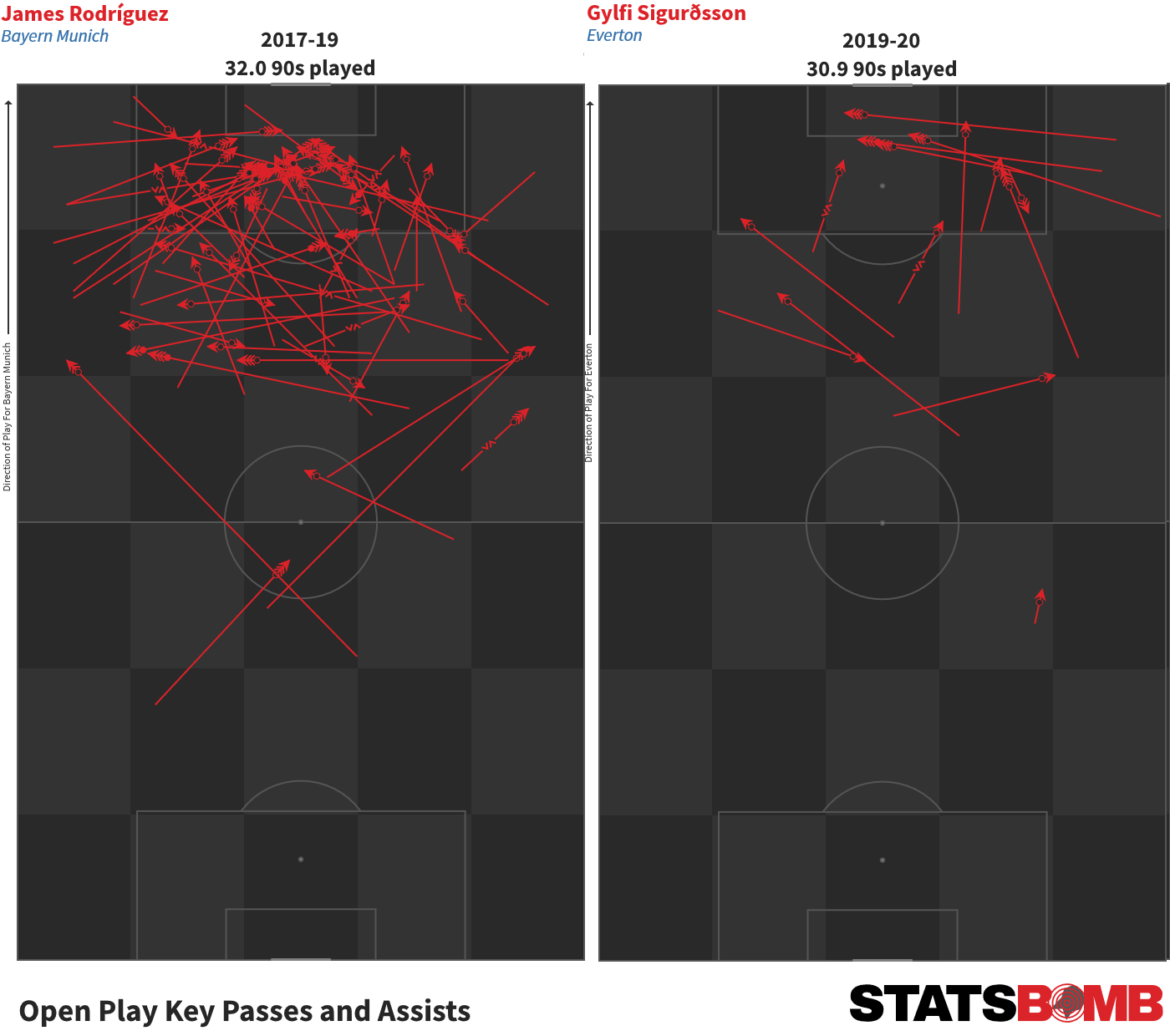 James also has experience under Ancelotti for a brief period during their time at Bayern Munich, so there could well be some benefit from these high quality players being able to join up, and quickly drop in to the team. Do Allan's legs allow James to create with some impunity? Perhaps so, but undeniably, their recruitment improves Everton in an area they were likely weakest and certainly makes the short term likelihood of Everton raising their floor very real. Given erratic game time for each in recent times, it will be interesting to see how frequently they feature and how frequently Everton get a full shift from them. As much as queries around contracting players into their 30s will persist, getting Everton's first 11 onto the pitch reliably will have a large impact on outcomes. It's also looking as though Abdoulaye Doucouré will be joining from Watford. As an aside a quick glace at the squad makes me feel a little more full back depth could go a long way. Projection What is success for this team this season? Everton have invested in players at a cost that demands a challenge to the top six. At times it has felt as though each new manager and season has been treated as a blank canvas, and the residual squad members from previous regimes have been hard to move on. Everton need to find a way to move on from that cycle, and on balance, enough of their more recent recruitment in the Marcel Brands era has created a team that at its core has the makings of a prosperous side. Very little more needs to go right to regain a slot in the eternal seventh to tenth zone that Everton frequently occupy, but a big impact from their new recruits could steer them upwards. Sporting Index opened up with a ninth placed 52-53 point estimation and that may be a low base, considering what we know about 2019-20 and the Ancelotti era. As discussed, his actual point accrual rate was about five points ahead of that and a further handful of points probably gets you to the top six mix. Maximising outcome is Ancelotti's challenge. He needs to get close to the top six for 2020-21 to be deemed successful. The form of the team was concerning during the restart, but it can be hoped that the planning was orientated towards this season instead. Teams that understand the brutal schedule and plan to adapt will be set-up to fare best in 2020-21 and there is an opportunity here for those that do. Everton do have a large squad too. If Ancelotti can't manage to point this team upwards, further change in management and personnel may be in the offing, and the cycle could recur.
James also has experience under Ancelotti for a brief period during their time at Bayern Munich, so there could well be some benefit from these high quality players being able to join up, and quickly drop in to the team. Do Allan's legs allow James to create with some impunity? Perhaps so, but undeniably, their recruitment improves Everton in an area they were likely weakest and certainly makes the short term likelihood of Everton raising their floor very real. Given erratic game time for each in recent times, it will be interesting to see how frequently they feature and how frequently Everton get a full shift from them. As much as queries around contracting players into their 30s will persist, getting Everton's first 11 onto the pitch reliably will have a large impact on outcomes. It's also looking as though Abdoulaye Doucouré will be joining from Watford. As an aside a quick glace at the squad makes me feel a little more full back depth could go a long way. Projection What is success for this team this season? Everton have invested in players at a cost that demands a challenge to the top six. At times it has felt as though each new manager and season has been treated as a blank canvas, and the residual squad members from previous regimes have been hard to move on. Everton need to find a way to move on from that cycle, and on balance, enough of their more recent recruitment in the Marcel Brands era has created a team that at its core has the makings of a prosperous side. Very little more needs to go right to regain a slot in the eternal seventh to tenth zone that Everton frequently occupy, but a big impact from their new recruits could steer them upwards. Sporting Index opened up with a ninth placed 52-53 point estimation and that may be a low base, considering what we know about 2019-20 and the Ancelotti era. As discussed, his actual point accrual rate was about five points ahead of that and a further handful of points probably gets you to the top six mix. Maximising outcome is Ancelotti's challenge. He needs to get close to the top six for 2020-21 to be deemed successful. The form of the team was concerning during the restart, but it can be hoped that the planning was orientated towards this season instead. Teams that understand the brutal schedule and plan to adapt will be set-up to fare best in 2020-21 and there is an opportunity here for those that do. Everton do have a large squad too. If Ancelotti can't manage to point this team upwards, further change in management and personnel may be in the offing, and the cycle could recur.
If you're a club, media or gambling entity and want to know more about what StatsBomb can do for you, please contact us at Sales@StatsBomb.com We also provide education in this area, so if this taste of football analytics sparked interest, check out our Introduction to Football Analytics course Follow us on twitter in English and Spanish and also on LinkedIn
Liverpool: Season Preview 2020-21
Champions League, World Club Cup and Premier League. Game completed. What comes next? The 2019-20 season wasn't just odd due to the three month winter break in the middle of it. It was odd in the way that Liverpool cocked a snook at any idea that their 97 point 2018-19 total was going to be hard to replicate and promptly went charging off looking for 100. As such, the title finally returned asterisk free to Merseyside after a 30 year wait. The ever likeable Jürgen Klopp cemented his place in Anfield folklore. Usually when teams log 90+ point seasons, they follow them up by coming back down to earth a little. The two exceptions (Chelsea 2004-05 and 2005-06, 95 and 91 and Manchester City 2017-18 and 2018-19, 100 and 98) did come back down in the next season but still stayed at over 80 points which is historically great and has won many a title. There's no denying Liverpool have been exceptional for (at least) two seasons. In 2018-19, they lost one league game and were unbeaten until January. In 2019-20 they were unbeaten until February 29th, and that's not even a proper day most years, so who's to say it counts? They're consistent, they have superb talent in all positions, they have found many different ways to win and they tend to do so.
One of the tricky aspects to evaluate with regard to Liverpool 2019-20 is that quite a lot of the season ended up being a parade. They were six points clear at the end of October, ten clear by mid-December and the Club World Cup jaunt, nineteen clear by the end of January and twenty-five clear on lockdown. The revolutionary strategy of winning every* game was bearing fruit. From an analysis perspective, at what point do we shrug and ignore actual on pitch activity, because it kinda didn't matter? Liverpool's four season expected goal trendlines clearly show that the back half of 2019-20 saw some of their worst metrics in years, but again: did it really matter?
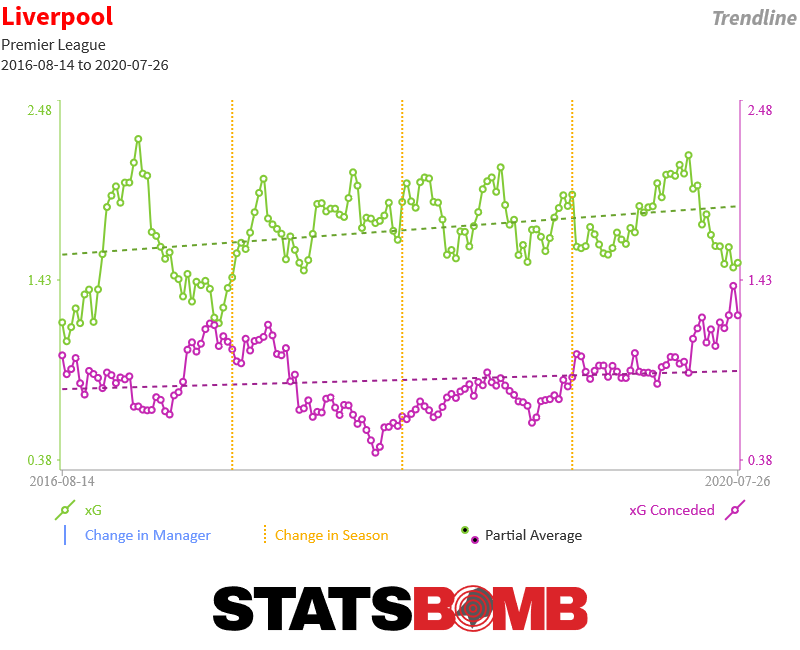
A valid point here is that Liverpool were better in 2018-19 than they were in 2019-20, but then again, they had to be. A lot has been made about the fact that Liverpool's expected metrics lagged behind those of Manchester City last season, which to my mind misses the point somewhat. That chart above shows that Liverpool have had excellent metrics for most of the last four seasons; excellent metrics put you in the mix to win titles, and Liverpool were a hair's breadth away from winning the last two. There's also the difference between necessity and game management to which a combination of quality and circumstance enabled Liverpool to navigate their way through the first half of 2019-20.
During late 2019, Liverpool were really good at getting to 2-0, and once they were at 2-0, they were really good at managing their way to the end of games. In the first half of 2019-20, they put together a 1-0, 2-0 combination within sixteen minutes eight times, seven of which were within the first half. Sure, good teams do this and all the recent points-hoarders have a fine record in building quick decisive leads, but to concentrate this into the first half of the season was notable and a worthwhile driver towards their exemplary results.
Also worthwhile was their amazing 16 game run of scoring first, which started in November and only finished in the still curious Watford defeat. Scoring first is again a hallmark of a good team, but to go 16 games without a weird ricochet or moment switching off is quite remarkable. These are the little quirks that help power dominant seasons, and while you can't rely on them to specifically recur, they sure as heck help out. Let's look at Liverpool's expected goals particularly the defensive end another way, game by game:
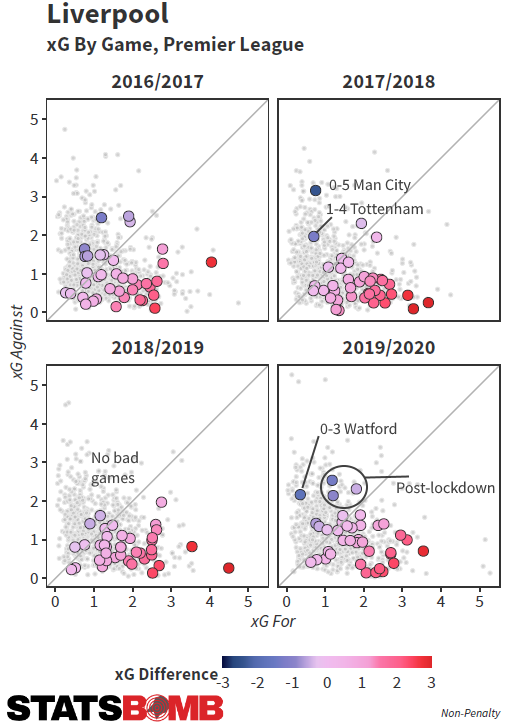 One of the main plotlines that underlies this chart is that between September 2017 and The Watford Game in February 2020, nearly two and a half years and 98 games, Liverpool did not give up more than two non-penalty expected goals in a league game. So that's the process right there; don't give up much in defence. It kicked on into reality too, as they went nearly as long without being two goals behind in a league game. This team has been so consistent for so long that the Watford game--in which they were comprehensively beaten 3-0 (2.2 vs 0.4 xG)--stands out alone in as an outlier across over 100 games. Ironically, post-Watford and post Covid break Liverpool did show vulnerability at the back and as a result "time spent behind" and "deviation from expectation while ahead" measures fell back towards more "normal" levels having been wildly out of kilter in a positive direction beforehand. Things like giving up more than two non-penalty expected goals occurred in three more games, although they won two of them (5-3 v Chelsea, 3-1 v Brighton) and only lost to Manchester City. There's not much more to be said here apart from don't make a habit of it. Personnel A quick word for Virgil Van Dijk here as he tops by a huge margin a metric I toyed with to ascertain how effective centre backs were at clearing or passing the ball out from dangerous central in-box zones:
One of the main plotlines that underlies this chart is that between September 2017 and The Watford Game in February 2020, nearly two and a half years and 98 games, Liverpool did not give up more than two non-penalty expected goals in a league game. So that's the process right there; don't give up much in defence. It kicked on into reality too, as they went nearly as long without being two goals behind in a league game. This team has been so consistent for so long that the Watford game--in which they were comprehensively beaten 3-0 (2.2 vs 0.4 xG)--stands out alone in as an outlier across over 100 games. Ironically, post-Watford and post Covid break Liverpool did show vulnerability at the back and as a result "time spent behind" and "deviation from expectation while ahead" measures fell back towards more "normal" levels having been wildly out of kilter in a positive direction beforehand. Things like giving up more than two non-penalty expected goals occurred in three more games, although they won two of them (5-3 v Chelsea, 3-1 v Brighton) and only lost to Manchester City. There's not much more to be said here apart from don't make a habit of it. Personnel A quick word for Virgil Van Dijk here as he tops by a huge margin a metric I toyed with to ascertain how effective centre backs were at clearing or passing the ball out from dangerous central in-box zones: 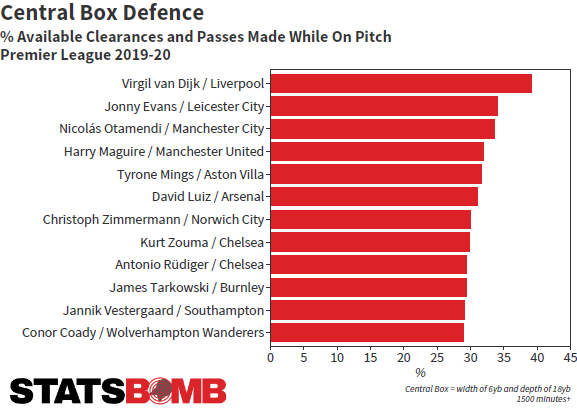 There's an interesting question around Liverpool's centre back partnerships that springs up from this. Van Dijk is evidently a dominant force within the league, but Joe Gomez is far more passive. Across two seasons his rate for this metric is around 20% (compared to Van Dijk's 35% 2018-19 and 39% in 2019-20). The now departed Dejan Lovren rated a shade higher at around 22-23% while Joel Matip was higher still at 25% and 29%. The point is that since Van Dijk arrived, he's been ever present and the three others have partnered him. When Gomez is on the pitch, you just get less defensive activity in key areas, much of which is aerial based. It's not that Van Dijk or someone else is covering, it's just a clear dropoff versus when Lovren or Matip have played. Now: does this matter? That's hard to say, but the only evidence we have recently of Liverpool's defence declining is in the recent period with Gomez alongside Van Dijk, the back half of 2019-20. The split between Gomez, Lovren and Matip to partner Van Dijk has been fairly even across the long dominant defensive period. Yes, Gomez remains the future of Liverpool's defence, but also, Matip must have a good shout at getting his place back. It will be something to monitor going forward. Elsewhere there are few surprises. The three man forward line remains as good and democratic as any in world football and there are no secrets around the full-back contributions now either. The right sided of the three midfielders tends to be the extra moving part to the attack, be it Alex Oxlade-Chamberlain or Jordan Henderson. There was a lot of chatter about Firmino's finishing last season, but in undershooting his expected goals, he wasn't obviously revealing a flaw; he'd been +3 vs expectation across the last three seasons before a blip of -4.5 in 2019-20. Closer examination shows he has finished well with his head long term and is weakest with his left foot, but he contributes so much else with regard to creation and pressing, it's erroneous to be over-critical. And Liverpool do still press, nothing's changed there:
There's an interesting question around Liverpool's centre back partnerships that springs up from this. Van Dijk is evidently a dominant force within the league, but Joe Gomez is far more passive. Across two seasons his rate for this metric is around 20% (compared to Van Dijk's 35% 2018-19 and 39% in 2019-20). The now departed Dejan Lovren rated a shade higher at around 22-23% while Joel Matip was higher still at 25% and 29%. The point is that since Van Dijk arrived, he's been ever present and the three others have partnered him. When Gomez is on the pitch, you just get less defensive activity in key areas, much of which is aerial based. It's not that Van Dijk or someone else is covering, it's just a clear dropoff versus when Lovren or Matip have played. Now: does this matter? That's hard to say, but the only evidence we have recently of Liverpool's defence declining is in the recent period with Gomez alongside Van Dijk, the back half of 2019-20. The split between Gomez, Lovren and Matip to partner Van Dijk has been fairly even across the long dominant defensive period. Yes, Gomez remains the future of Liverpool's defence, but also, Matip must have a good shout at getting his place back. It will be something to monitor going forward. Elsewhere there are few surprises. The three man forward line remains as good and democratic as any in world football and there are no secrets around the full-back contributions now either. The right sided of the three midfielders tends to be the extra moving part to the attack, be it Alex Oxlade-Chamberlain or Jordan Henderson. There was a lot of chatter about Firmino's finishing last season, but in undershooting his expected goals, he wasn't obviously revealing a flaw; he'd been +3 vs expectation across the last three seasons before a blip of -4.5 in 2019-20. Closer examination shows he has finished well with his head long term and is weakest with his left foot, but he contributes so much else with regard to creation and pressing, it's erroneous to be over-critical. And Liverpool do still press, nothing's changed there: 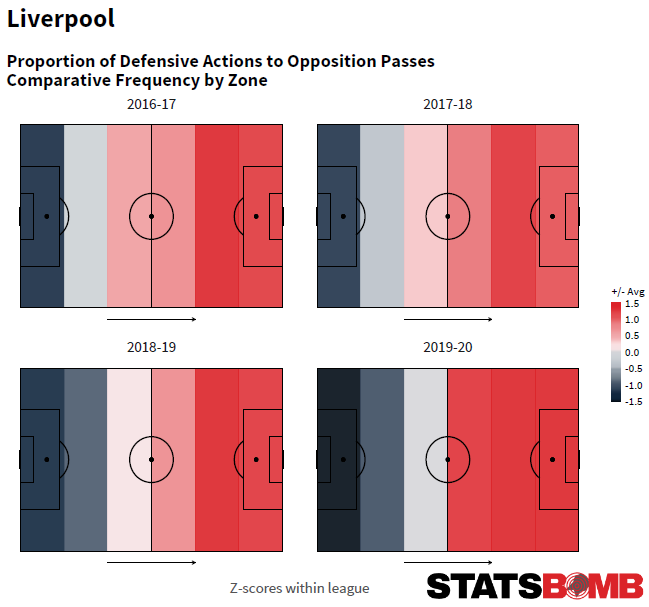 Once more off-season transfers don't seem to be the primary focus with the core first team all still within peak ages ranges and performing so well, but the team has moved finally to lock up a back-up left-back in Kostas Tsimikas. We reviewed him for our Pro Scouting project and liked him, for all that we didn't foresee a jump up to one of the best teams in the world. Our executive summary was as follows: Kostas Tsimikas is an all-round full back with a very impressive defensive output. A very aggressive presser, he somewhat foul prone. In attack he combines above average passing with decent crossing to offer a solid but unspectacular package. He can make the jump to a bigger league this summer. He also has throw-in ability, can execute combination play in build-up and is an effective ball carrier. We felt he could fit into a squad for a Europa League level team, but if we consider his age, and the stylistic package as a relatively well priced gamble to back up one of the world's best left backs, it's hard not to like.
Once more off-season transfers don't seem to be the primary focus with the core first team all still within peak ages ranges and performing so well, but the team has moved finally to lock up a back-up left-back in Kostas Tsimikas. We reviewed him for our Pro Scouting project and liked him, for all that we didn't foresee a jump up to one of the best teams in the world. Our executive summary was as follows: Kostas Tsimikas is an all-round full back with a very impressive defensive output. A very aggressive presser, he somewhat foul prone. In attack he combines above average passing with decent crossing to offer a solid but unspectacular package. He can make the jump to a bigger league this summer. He also has throw-in ability, can execute combination play in build-up and is an effective ball carrier. We felt he could fit into a squad for a Europa League level team, but if we consider his age, and the stylistic package as a relatively well priced gamble to back up one of the world's best left backs, it's hard not to like. 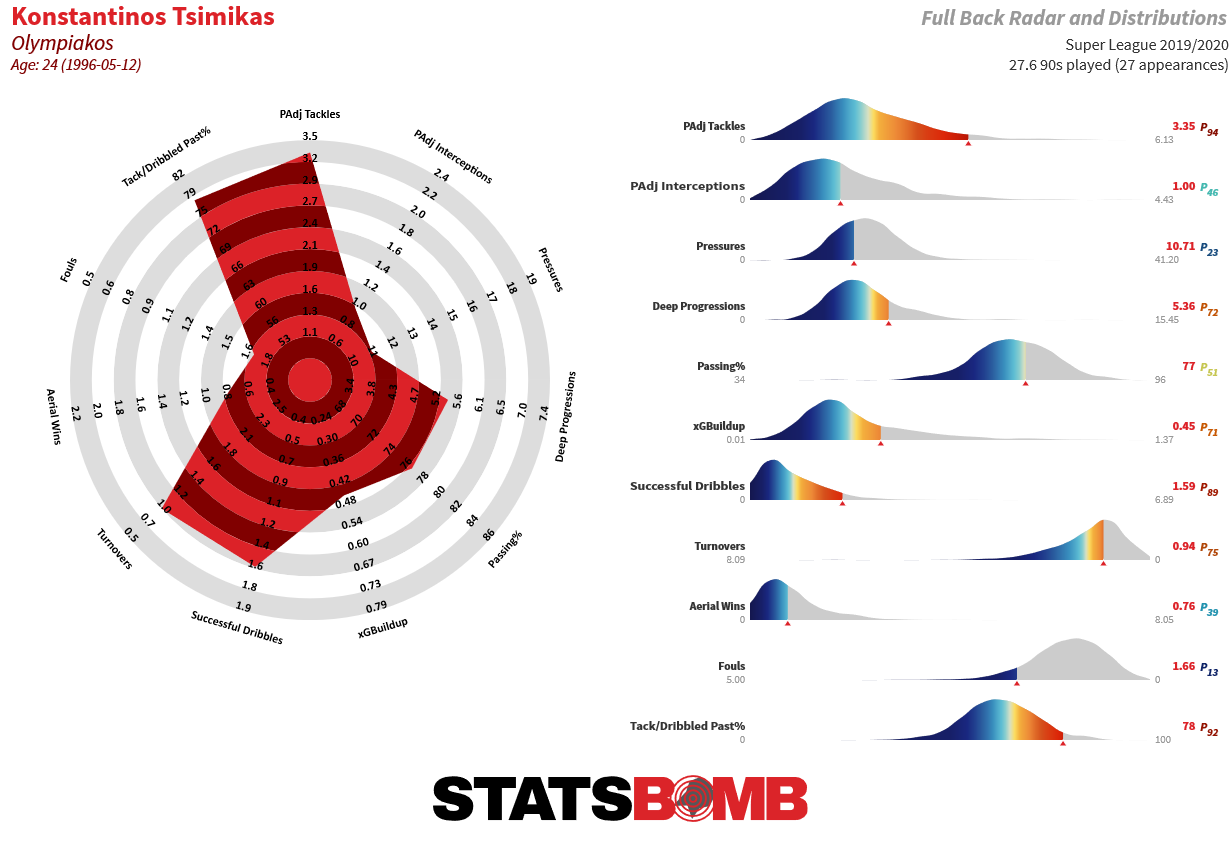 The other will he/won't he saga is the tempting switch to bring Thiago Alcântara in for Georginio Wijnaldum. The role of Wijnaldum has long been tricky to pin down, as it scarcely reveals itself via obvious numerical means, but his positioning, ball retention and discipline have clearly contributed plenty to the success of this team. He's also reliably fit, which is something that can't be said of Thiago. With a year on his contract and on the cusp of 30, Wijnaldum's time may have passed, and Barcelona are rumoured to be interested. Thiago is one of the world's best midfielders and appears to be looking for a
The other will he/won't he saga is the tempting switch to bring Thiago Alcântara in for Georginio Wijnaldum. The role of Wijnaldum has long been tricky to pin down, as it scarcely reveals itself via obvious numerical means, but his positioning, ball retention and discipline have clearly contributed plenty to the success of this team. He's also reliably fit, which is something that can't be said of Thiago. With a year on his contract and on the cusp of 30, Wijnaldum's time may have passed, and Barcelona are rumoured to be interested. Thiago is one of the world's best midfielders and appears to be looking for a pay day new challenge, and sure, he's about the same age, but we're not going to get Lionel Messi in the Premier League this summer, can we have him instead? However this little dance plays out, it would be preferable if one of these players was on Merseyside next season: 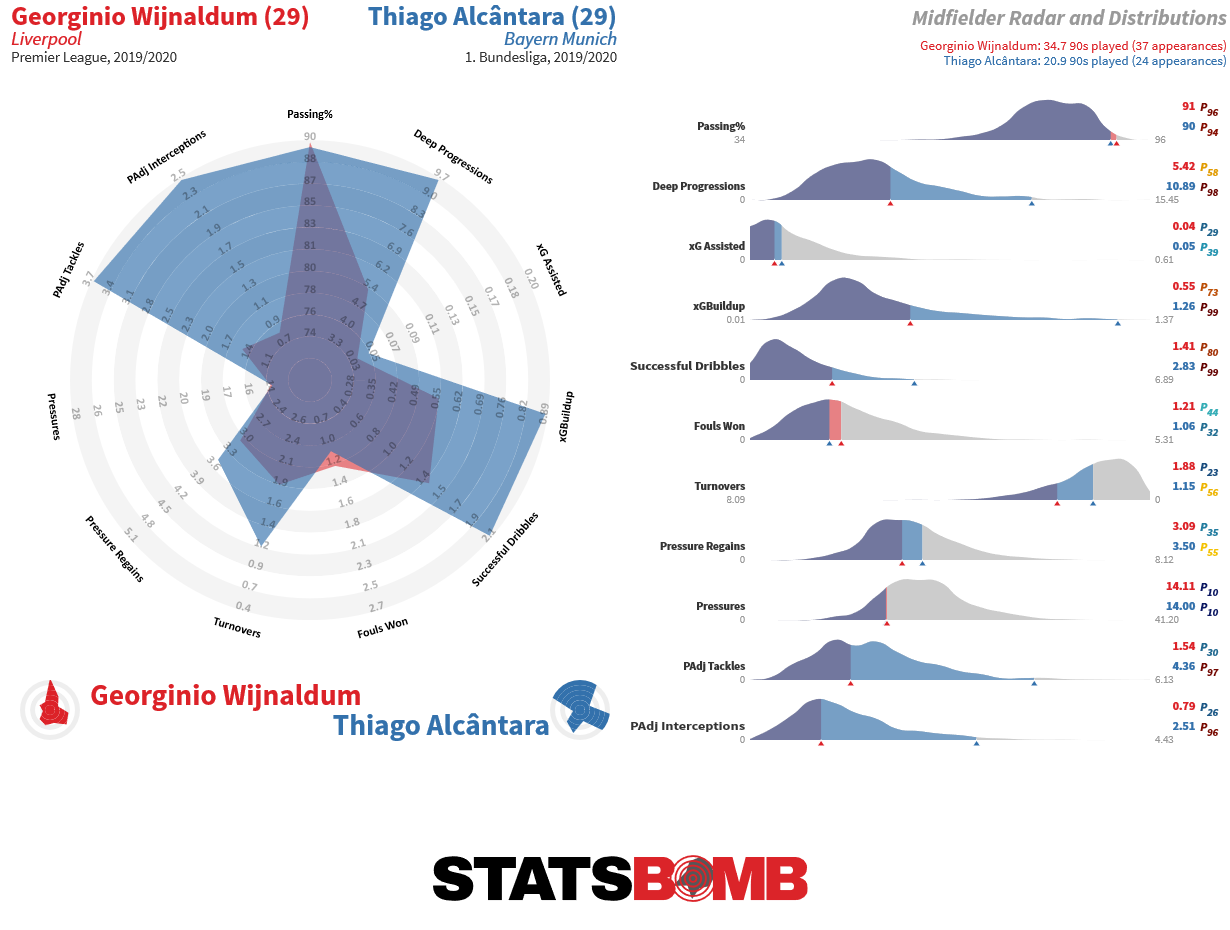 Projection Once he'd raised then to the standard of title winners, Klopp got three more decent seasons out of Borussia Dortmund, before the team suffered in 2014-15. Even with key members of this team aging together, it still seems likely that the absolute core of this team has another couple of years before remedial work is required. As we've seen with Barcelona, the problem is when much of your core talent is 32 to 33 not 28 to 30. As it's now 6 months since Liverpool have played a legitimate competitive and meaningful fixture, it has to be said: they will need to regroup, focus and start this season at the top of their game. This is Klopp's real challenge this season. As they have achieved their immediate goals, he needs to maintain the focus that got them there to compete at the same level again. It would not be surprising if this team dropped back ten points, and were still excellent in the main. That felt like the most likely outcome last season too and they rose to the challenge with some aplomb. Sporting Index's early lines peg them around here too, close enough to Manchester City (for whom excellent overall metrics will inevitably drive betting lines). But this Liverpool side the same team that got to two Champions League finals. The same team that landed back to back high-90 point totals. Predicting them outside the mix is not realistic. Every year that Klopp has been in charge it has appeared that they have learned a new technique to ensure that they can go longer and deeper into seasons (remember the bad Januarys?). Last season it felt like they had learned to manage their way out of games from advantageous positions, conserving energy for the inevitable hard grind of a tight schedule. This year the schedule will be tighter than ever, and this is a team that understands that consistency will take them furthest. If you turn up every gameweek and put up two expected goals to your opponent's one, you will win a lot of matches. Liverpool have been more consistent than their rivals for most of two seasons. They just have to be so again.
Projection Once he'd raised then to the standard of title winners, Klopp got three more decent seasons out of Borussia Dortmund, before the team suffered in 2014-15. Even with key members of this team aging together, it still seems likely that the absolute core of this team has another couple of years before remedial work is required. As we've seen with Barcelona, the problem is when much of your core talent is 32 to 33 not 28 to 30. As it's now 6 months since Liverpool have played a legitimate competitive and meaningful fixture, it has to be said: they will need to regroup, focus and start this season at the top of their game. This is Klopp's real challenge this season. As they have achieved their immediate goals, he needs to maintain the focus that got them there to compete at the same level again. It would not be surprising if this team dropped back ten points, and were still excellent in the main. That felt like the most likely outcome last season too and they rose to the challenge with some aplomb. Sporting Index's early lines peg them around here too, close enough to Manchester City (for whom excellent overall metrics will inevitably drive betting lines). But this Liverpool side the same team that got to two Champions League finals. The same team that landed back to back high-90 point totals. Predicting them outside the mix is not realistic. Every year that Klopp has been in charge it has appeared that they have learned a new technique to ensure that they can go longer and deeper into seasons (remember the bad Januarys?). Last season it felt like they had learned to manage their way out of games from advantageous positions, conserving energy for the inevitable hard grind of a tight schedule. This year the schedule will be tighter than ever, and this is a team that understands that consistency will take them furthest. If you turn up every gameweek and put up two expected goals to your opponent's one, you will win a lot of matches. Liverpool have been more consistent than their rivals for most of two seasons. They just have to be so again.
If you're a club, media or gambling entity and want to know more about what StatsBomb can do for you, please contact us at Sales@StatsBomb.com We also provide education in this area, so if this taste of football analytics sparked interest, check out our Introduction to Football Analytics course Follow us on twitter in English and Spanish and also on LinkedIn
Manchester United: Season Preview 2020-21
Are the good times back? Ole Gunnar Solskjær is closing in on two years in the Manchester United hotseat and there’s a creeping realisation that the longer he’s been there the better things have got. That’s not to say that the journey to this point has been smooth or linear, or that the actual tangible on-pitch improvement is impossible to deny. It’s more subtle than that. When United are good, they can be very good. On paper, they have an array of attacking talent that few can match in Anthony Martial, Bruno Fernandes, Paul Pogba, Marcus Rashford and now Mason Greenwood. In defence, they were only a clip behind Liverpool and Manchester City last season and their expected metrics there were very solid. The recruitment of Fernandes in late January became a clear stake in the ground. While significantly more erratic prior to his arrival, United were unbeaten in the league from that moment onwards (fourteen games) and only lost their first match since his arrival at the club in the FA Cup semi-final in July against Chelsea. The familiar sight of Fernandes finishing a penalty occurred seven times in his first few months at the club, his technique and cool head benefiting from a team that won spot kicks at a high pace throughout the season, often thanks to the slaloming skills of Rashford, Pogba and others. But the first half of the season was less encouraging, with an odd mix of good results against strong teams and bad results against weaker sides. The consistent later form coincided with a more stable first eleven, and a kind post-Covid fixture list was the perfect environment for Pogba to return to and for Greenwood to show a finishing run exceeding that of Rashford’s own emergence four years ago. One of the odd characteristics of Solskjær's reign is how metrics and outcomes have deviated so wildly. It seemed illogical to exclude penalties from this chart (just this once!) since they were such a feature of the 2019-20 season, but it shows expected goal difference and actual goal difference across his whole tenure and how rarely the twain shall meet: 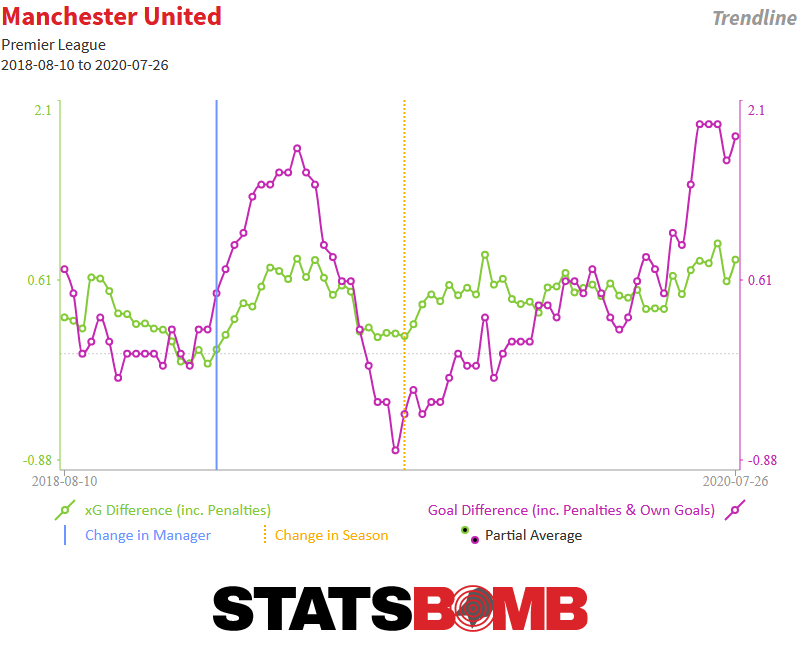 Translation? Expected metrics have slowly crept upwards over time, kinda, actual goal outcomes look more like a heart monitor. This tendency towards wild deviations has actually caused narratives to become slightly faulty. The blast of finishing and run of penalties while Fernandes has been at the club gives the impression that United's attack is their strength, when actually the opposite is likely true--the defence is their bedrock and has been for some while:
Translation? Expected metrics have slowly crept upwards over time, kinda, actual goal outcomes look more like a heart monitor. This tendency towards wild deviations has actually caused narratives to become slightly faulty. The blast of finishing and run of penalties while Fernandes has been at the club gives the impression that United's attack is their strength, when actually the opposite is likely true--the defence is their bedrock and has been for some while: 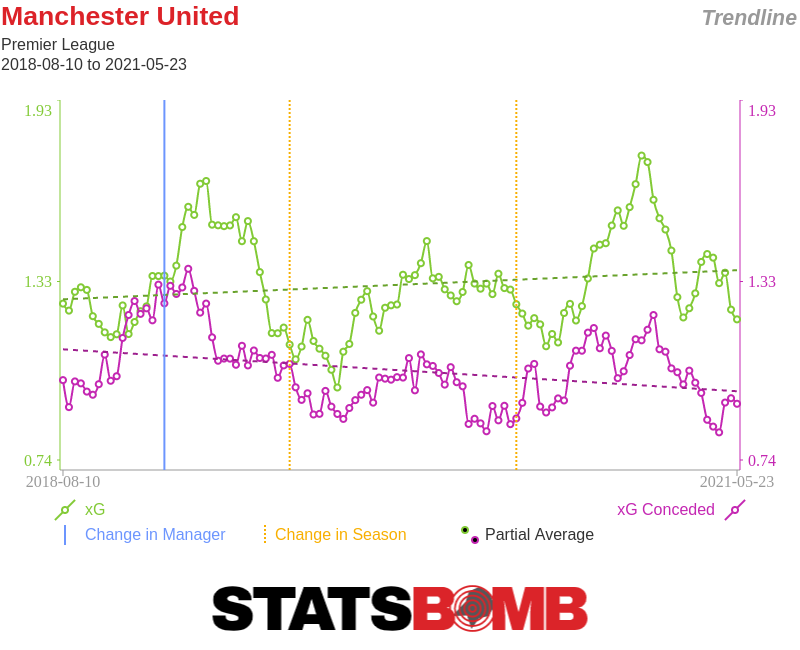 A season long expected goal against value of around 0.9 per game is in the ballpark of their rivals--including Manchester City and Liverpool. A season long expected goal for value of 1.3 per game parks then between Southampton and Everton. If this team has designs of winning enough games to point upwards out of the island of third to fourth, it will first and foremost need to get better in attack. How can this be achieved? The front five United fielded during their unbeaten run are a blend of dual purpose longer range shooters and creators (Pogba and Fernandes), shooters (Rashford and Greenwood) and a player with long term finishing prowess who has seen creativity drop off as he's been empowered into a centre forward role (Martial). It's likely that carrying Rashford, Greenwood and Martial (in this role) damages the ability for this team to create a high volume of chances. As we saw towards the end of the season, if Fernandes is quiet, United can really drift and lack incisive creativity. The depth in this area of the pitch is not ideal too with the likes of Jesse Lingard, Juan Mata or Andreas Pereira more sporadic and limited influences. The ship has sailed, but ironically, the profile provided by Alexis Sánchez, or at least a younger more virile version of him, would fit well into this set-up. Somewhere, United's balance of shooting and creativity needs to skew towards the latter. It's what makes the [potential] signing of Donny van de Beek ostensibly curious, as it's quite hard to directly envisage which of United's current attackers or midfielders he will likely replace, or specifically how he'd fit into midfield given how little he tends to contribute towards general buildup. Of course, as more required depth, he's entirely fine, but there's not an obvious way to get Van de Beek into a starting lineup that include Martial, Rashford and Greenwood unless you're entirely throwing caution to the wind and giving midfield a complete pass. This then undermines your already solid defence and puts a heck of a lot onto Pogba and/or Fernandes. This isn't Garth Crooks' team of the week; the Matic/Fred role can't just be abandoned. But at least this problem exists. Yes, the squad needs more depth and the drop off should injury hit any key starter is severe but the outright Manchester United first XI nearly picks itself, something that hasn't always been the case in the post-Ferguson era. To be more generally positive though, in Greenwood and his breakthrough, another fine talent looks to have been unearthed but this has slightly deflected focus on the development of Rashford. Of the attacking unit, his form was perhaps the least impressive post-lockdown, but now in a more settled left sided position, on aggregate his progression is tangible:
A season long expected goal against value of around 0.9 per game is in the ballpark of their rivals--including Manchester City and Liverpool. A season long expected goal for value of 1.3 per game parks then between Southampton and Everton. If this team has designs of winning enough games to point upwards out of the island of third to fourth, it will first and foremost need to get better in attack. How can this be achieved? The front five United fielded during their unbeaten run are a blend of dual purpose longer range shooters and creators (Pogba and Fernandes), shooters (Rashford and Greenwood) and a player with long term finishing prowess who has seen creativity drop off as he's been empowered into a centre forward role (Martial). It's likely that carrying Rashford, Greenwood and Martial (in this role) damages the ability for this team to create a high volume of chances. As we saw towards the end of the season, if Fernandes is quiet, United can really drift and lack incisive creativity. The depth in this area of the pitch is not ideal too with the likes of Jesse Lingard, Juan Mata or Andreas Pereira more sporadic and limited influences. The ship has sailed, but ironically, the profile provided by Alexis Sánchez, or at least a younger more virile version of him, would fit well into this set-up. Somewhere, United's balance of shooting and creativity needs to skew towards the latter. It's what makes the [potential] signing of Donny van de Beek ostensibly curious, as it's quite hard to directly envisage which of United's current attackers or midfielders he will likely replace, or specifically how he'd fit into midfield given how little he tends to contribute towards general buildup. Of course, as more required depth, he's entirely fine, but there's not an obvious way to get Van de Beek into a starting lineup that include Martial, Rashford and Greenwood unless you're entirely throwing caution to the wind and giving midfield a complete pass. This then undermines your already solid defence and puts a heck of a lot onto Pogba and/or Fernandes. This isn't Garth Crooks' team of the week; the Matic/Fred role can't just be abandoned. But at least this problem exists. Yes, the squad needs more depth and the drop off should injury hit any key starter is severe but the outright Manchester United first XI nearly picks itself, something that hasn't always been the case in the post-Ferguson era. To be more generally positive though, in Greenwood and his breakthrough, another fine talent looks to have been unearthed but this has slightly deflected focus on the development of Rashford. Of the attacking unit, his form was perhaps the least impressive post-lockdown, but now in a more settled left sided position, on aggregate his progression is tangible: 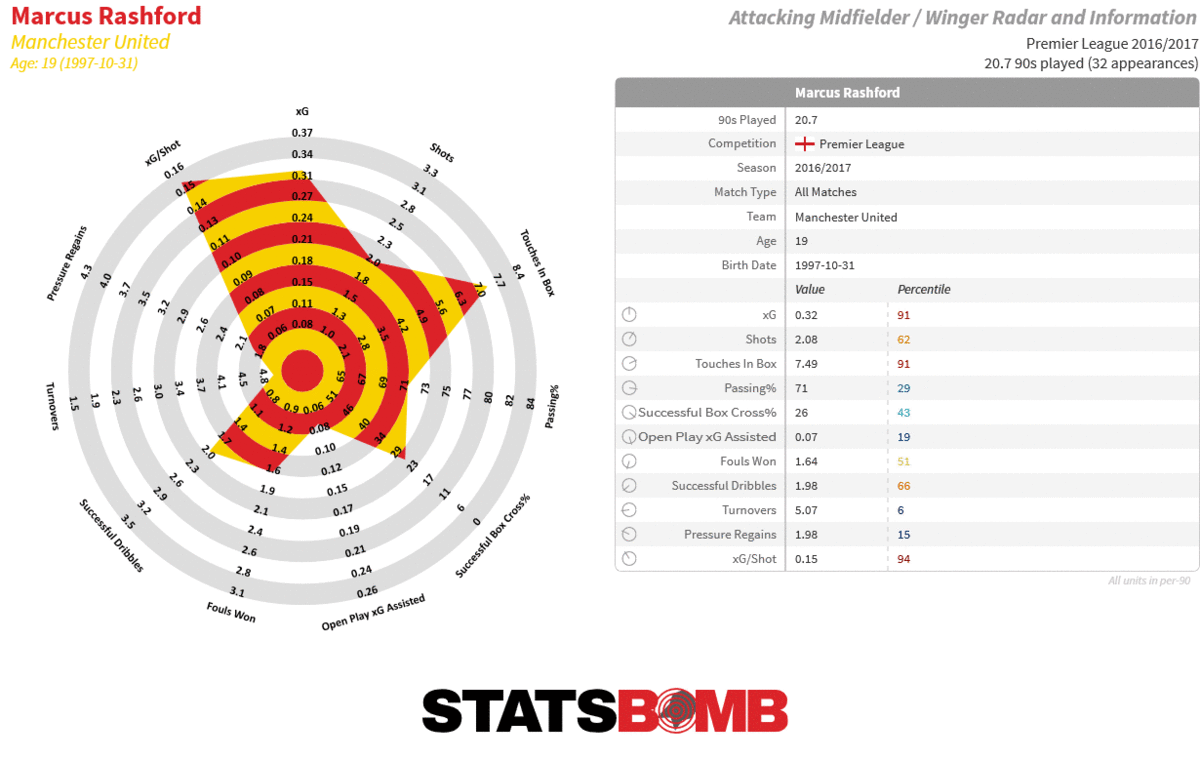 He still likes a dip from range, but has shown ever greater ability to get into good quality finishing positions, and at 22 years old, can't be far off the finished article as a player. Martial too appeared to prosper given the centre forward position. His 17 goals from an expected 10 was a welcome boost, but only continues a theme: few players are over their xG every season, but he has been for his entire time at United, albeit not to this degree before:
He still likes a dip from range, but has shown ever greater ability to get into good quality finishing positions, and at 22 years old, can't be far off the finished article as a player. Martial too appeared to prosper given the centre forward position. His 17 goals from an expected 10 was a welcome boost, but only continues a theme: few players are over their xG every season, but he has been for his entire time at United, albeit not to this degree before: 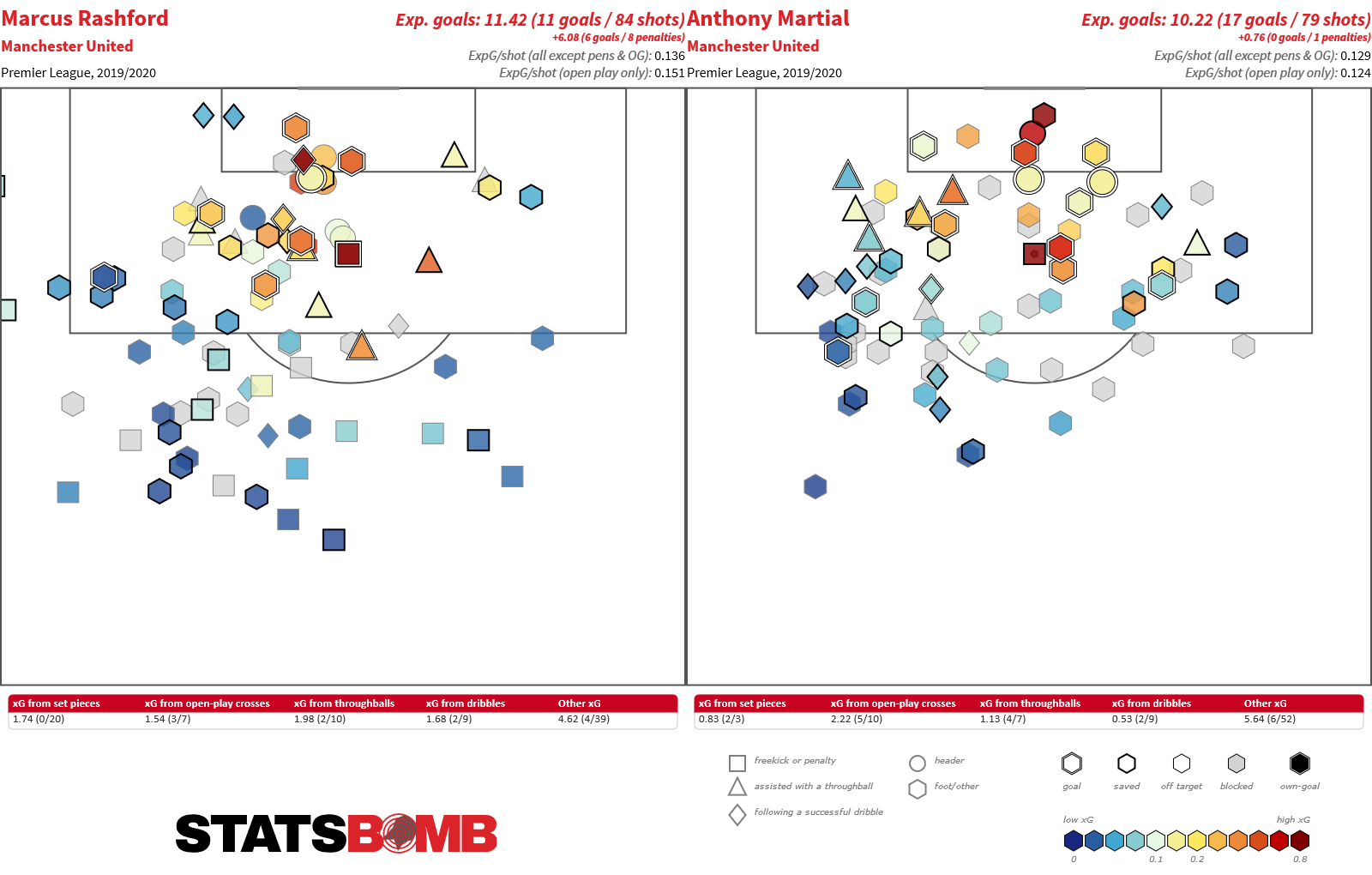 If we turn to the new man, Van de Beek, his main qualities can be seen inside the box too. He looks to be a good quality finisher, as we can see from two seasons of Eredivisie shots here:
If we turn to the new man, Van de Beek, his main qualities can be seen inside the box too. He looks to be a good quality finisher, as we can see from two seasons of Eredivisie shots here: 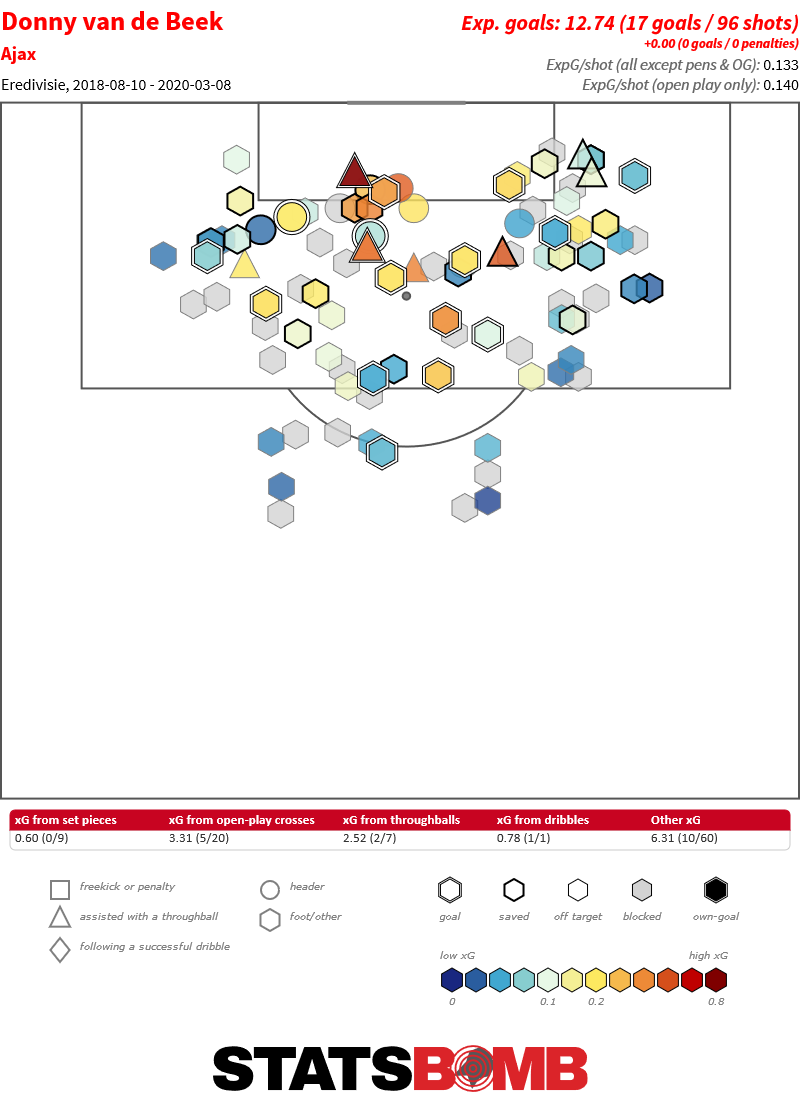 He's predominantly right footed, but there's some left foot and head in there too. We reviewed him for our Pro-Scouting project and our executive summary was as follows: Strengths ● Exceptional off-ball movement in and around the penalty area. ● Goalscoring and chance creation numbers outstanding. ● Positionally versatile, can play as central or attacking midfielder. Weaknesses ● Little involvement in build-up. ● Limited defensive output. Summary Donny van de Beek is world-class within his role. He is an exceptional goalscorer from midfield and combines that with great chance creation numbers. However, his involvement in other areas of the game is limited. It is unclear whether or not this profile is enough for clubs at the very highest level, to which he is often linked. Current: Europa League top 5 leagues Potential: Champions League level, in a very defined role. Transfer Potential ● Ajax do not sell cheap, transfer fee likely to be upwards of 40m. My sense here is that the best of Van de Beek may come later in his contract if United continue to build and recruit well, and he's able to fulfil a specific role, but goals and assists from midfield win friends and can cover sins, so he may well come out ahead regardless. With a deal for Jadon Sancho seemingly receding in likelihood and Lionel Messi yet to be sighted in Lancashire, that's it so far for United. The one position that needs no attention is goalkeeper with David De Gea likely to continue despite a less than stellar 2019-20 and Dean Henderson's future slightly uncertain. He won't be returning to Sheffield United, but is plenty good enough to continue as a Premier League number one for someone. Could there be more depth in defence? The work done last summer in acquiring Aaron Wan-Bissaka and Harry Maguire locked down two positions and Luke Shaw has staged something of a renaissance to claim left-back. Victor Lindelöf has nailed down the other starting role across the last two seasons, and again it feels like a question of whether the assorted depth that exists can cover sufficiently, or whether new blood is needed. It would be great to see Eric Bailly or Phil Jones find a run of form and fitness but those eternal question marks mean another centre back would be nice, while Brandon Williams was a successful find last season and can cover both defensive flanks as required. United's whole line up does feel one key injury away from sticking plasters in most positions so another defender and midfield option would tidily round out the summer. Projection Manchester United have a curious schedule to start. They don't face an away trip to a team that finished in the top half last season until week 12 and Sheffield United on December 15th. Of course this means a bunch of better rated teams visiting Old Trafford early on, including Manchester City, Tottenham, Arsenal and Chelsea, from which they got 10/12 points in the corresponding 2019-20 fixtures. A few things will probably happen:
He's predominantly right footed, but there's some left foot and head in there too. We reviewed him for our Pro-Scouting project and our executive summary was as follows: Strengths ● Exceptional off-ball movement in and around the penalty area. ● Goalscoring and chance creation numbers outstanding. ● Positionally versatile, can play as central or attacking midfielder. Weaknesses ● Little involvement in build-up. ● Limited defensive output. Summary Donny van de Beek is world-class within his role. He is an exceptional goalscorer from midfield and combines that with great chance creation numbers. However, his involvement in other areas of the game is limited. It is unclear whether or not this profile is enough for clubs at the very highest level, to which he is often linked. Current: Europa League top 5 leagues Potential: Champions League level, in a very defined role. Transfer Potential ● Ajax do not sell cheap, transfer fee likely to be upwards of 40m. My sense here is that the best of Van de Beek may come later in his contract if United continue to build and recruit well, and he's able to fulfil a specific role, but goals and assists from midfield win friends and can cover sins, so he may well come out ahead regardless. With a deal for Jadon Sancho seemingly receding in likelihood and Lionel Messi yet to be sighted in Lancashire, that's it so far for United. The one position that needs no attention is goalkeeper with David De Gea likely to continue despite a less than stellar 2019-20 and Dean Henderson's future slightly uncertain. He won't be returning to Sheffield United, but is plenty good enough to continue as a Premier League number one for someone. Could there be more depth in defence? The work done last summer in acquiring Aaron Wan-Bissaka and Harry Maguire locked down two positions and Luke Shaw has staged something of a renaissance to claim left-back. Victor Lindelöf has nailed down the other starting role across the last two seasons, and again it feels like a question of whether the assorted depth that exists can cover sufficiently, or whether new blood is needed. It would be great to see Eric Bailly or Phil Jones find a run of form and fitness but those eternal question marks mean another centre back would be nice, while Brandon Williams was a successful find last season and can cover both defensive flanks as required. United's whole line up does feel one key injury away from sticking plasters in most positions so another defender and midfield option would tidily round out the summer. Projection Manchester United have a curious schedule to start. They don't face an away trip to a team that finished in the top half last season until week 12 and Sheffield United on December 15th. Of course this means a bunch of better rated teams visiting Old Trafford early on, including Manchester City, Tottenham, Arsenal and Chelsea, from which they got 10/12 points in the corresponding 2019-20 fixtures. A few things will probably happen:
- Greenwood's finishing will cool off. He looks a rare talent, but will not often in his career score 10 goals for every 3.7 xG he generates as he did in the league last season
- Penalty returns will reduce. United had a +11 balance (albeit they missed four meaning +7 in goals). Next best in the Premier League across four seasons is +8. They do win a lot of penalties and may continue to do so, but in all likelihood, the gap shrinks between won and conceded.
- The defence will not allow five goals from the next 145 shots (and 12.6 xG) as it did during the 14 game unbeaten run. This equates to opposition finishing at 3.4% which is about as low as when Leicester experienced a wild and unsustainable opponent finishing run, that ultimately powered their title charge in 2015-16. Across the whole season, United's defence was close to its xG, but short term mega-skews should not be misinterpreted as legitimate form changes. The defence is good regardless, just not this good.
Elsewhere, it's hard to pull apart the numbers and categorically conclude this team is moving onwards and upwards quickly. A further comfortable top four finish, with a boost underneath in the stats would probably again represent progress. It's easy to forget the difficulties that this team faced during the first half of 2019-20 and how different it looked then compared to later. Perhaps the two cup defeats were emblematic of the status this United team has reached: nearly there but not quite. Again though the foundation feels a lot more sturdy than it did twelve months ago, and were the board to reach out and make another signing that had the potential to impact as much as Fernandes has, accelerating to better outcomes is achievable. In Solskjær, United may not have a manager driven by an emphatic football philosophy, but they may have one who is able to continue this incremental build towards a stable, strong, talented and competitive team.
If you're a club, media or gambling entity and want to know more about what StatsBomb can do for you, please contact us at Sales@StatsBomb.com We also provide education in this area, so if this taste of football analytics sparked interest, check out our Introduction to Football Analytics course Follow us on twitter in English and Spanish and also on LinkedIn
Crystal Palace: Season Preview 2020-21
Crystal Palace were a popular pick to struggle in 2019-20, but crafty veteran Roy Hodgson oversaw a mid-table finish with few wider worries.
Once the league settled down they were never higher than seventh or lower than their finishing position of fourteenth. However, despite all but securing safety in a pre-pandemic world (the hiatus started when they were on 39 points) their form in the short summer recall was dismal (1-1-7). It’s always hard to evaluate a team with little obvious reason to max out performance, but these games were closer to the relatively poor metrics that Palace had put up through to March.
Year on year, this decline was real. While 2018-19’s twelfth placed finish had not foretold doom for this aging squad--it was backed up by tenth placed, borderline par expected goal output--pre-Covid 2019-20 was different. A -0.41 xG per game stat line ranked 17th and the decline was all inhabited within the attack. The team went backwards from twelve shots a game the season before to under ten; at that stage a league worst total. And then, upon restarting, the performances started to match the numbers. When looking at the last two seasons (shown here in the trendlines) we can clearly see how the metrics were okay in 2018-19 and distinctly-not-okay in 2019-20. This is a huge red flag.
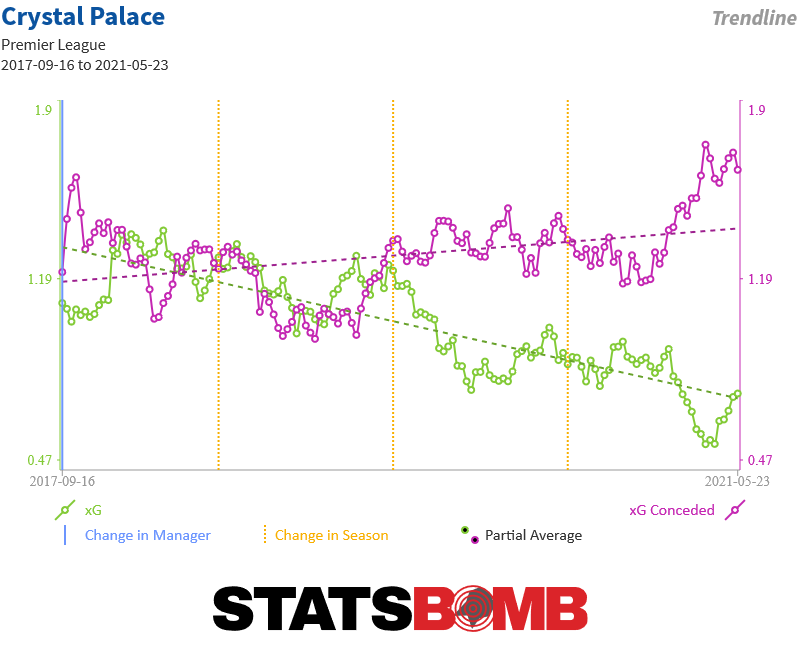
Hodgson had been well aware of his team’s potential failings, stating in September that:
“We'd like to score more but we've not been a prolific goalscoring team in these two years”.
This was a comment based on seasons scoring 45 and 51 goals. In 2019-20 they notched just 31, the lowest total in their entire history. Defence may be the priority for Roy, but usually when your attack is underperforming like this you run the risk of landing in a relegation battle. That this didn’t happen here feels like a stroke of fortune that should be recognised as such ahead of this new season. Palace got tangibly worse and somehow never had to face the music. Intriguingly, Pandemic Season One 2019-20, saw “footballing” teams like Norwich and Bournemouth relegated while Aston Villa and for half a season West Ham were also football first, results later and struggled. It doesn’t always play out this way though, and importantly, Palace's age factor won't fail to kick in forever.
This is the oldest team in the league by some margin. Their average age last season was pushing 30 in a division where 27 is normal. No player under the age of 26 played any significant minutes at all. This was the main factor that provoked pessimism ahead of 2019-20, but now with declining metrics on top of that plus another year, it’s hard to project this team positively:
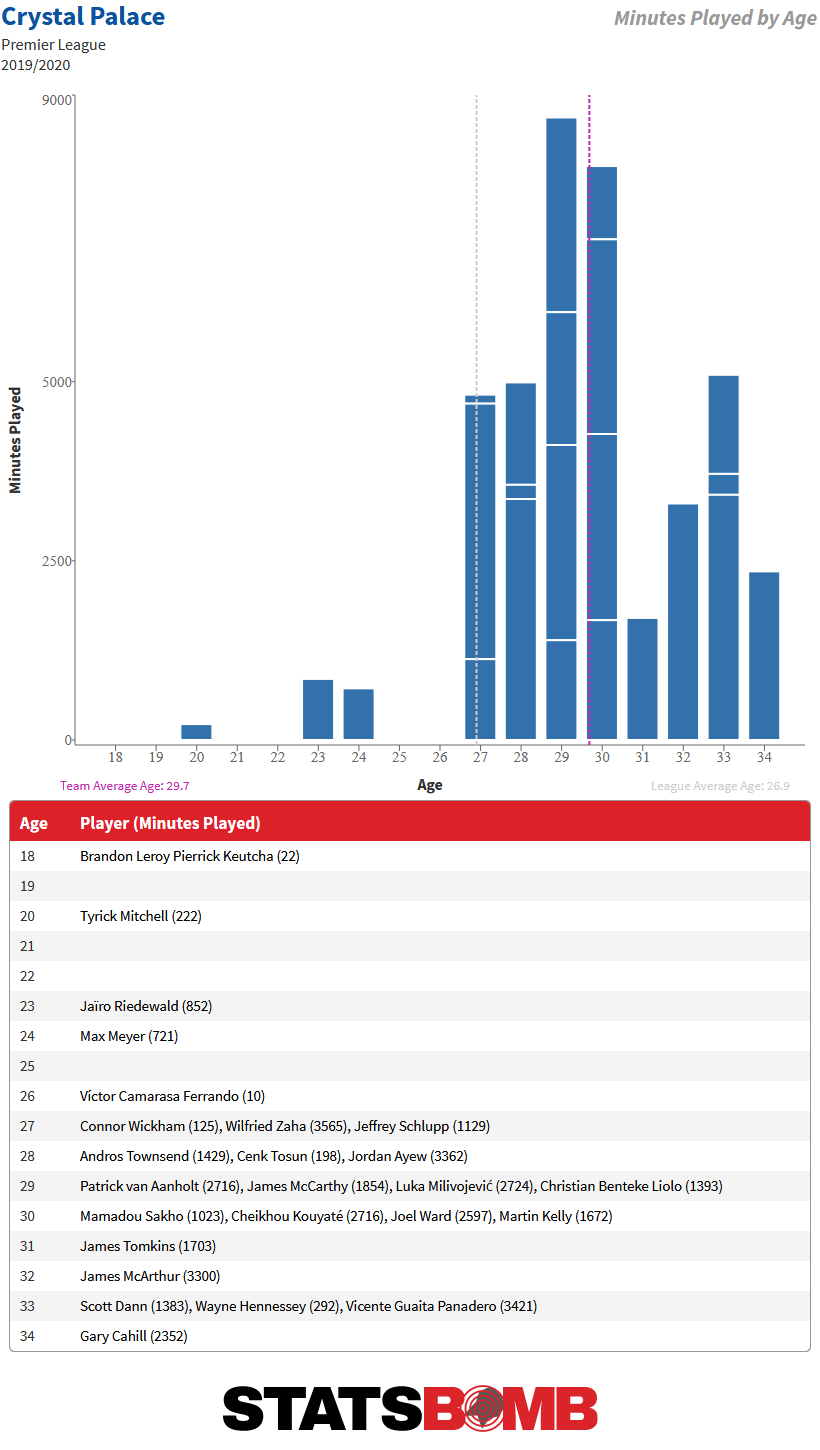
Goalkeeper Vicente Guaita was a difference maker in 2019-20. We had him ranked third in the Premier League for how active he was in making claims, behind Nick Pope and Alex McCarthy, while for shot stopping only Hugo Lloris and Emiliano Martinez (who had a fine pro-rata run in the late season) were ahead of him. Before arriving in England he was decent for Getafe, and no worse than average in 2018-19 for Palace, so despite age, has scoped out as a fairly positive contributor over a reasonable period of time. As ever though, maintaining hope that your goalkeeper is above average is a function of limited utility to pin hopes upon.
You know what you get with Wilfried Zaha. High volume dribbling, a shot map that eschews a central vortex, turnovers, fouls won and a ceiling that probably explains why the oft mooted big move has never quite materialised. His 2018-19 season saw ten goals, but only four of those were from his main shooting zone; fairly wide on his flank. He continued to shoot from there regularly in 2019-20 but notched just twice from out wide and four times overall while seven total goal contributions was around half his previous two seasons. All his expected contributions mirrored this and declined to their lowest levels since 2016-17 and it's hard to isolate the chicken from the egg. Zaha wasn't particularly good, but nor were any of his attacking teammates. Christian Benteke continues to be an unfortunate poster boy for expected goal variance. This time round his two non-penalty goals came from an expectation of over four. Interestingly, his scoring woes inhabit precisely Roy Hodgson's tenure. The season or so prior to his arrival Benteke was around par--13 goals from 13 xG. Ever since, for three long seasons, it's been hard graft for little reward:
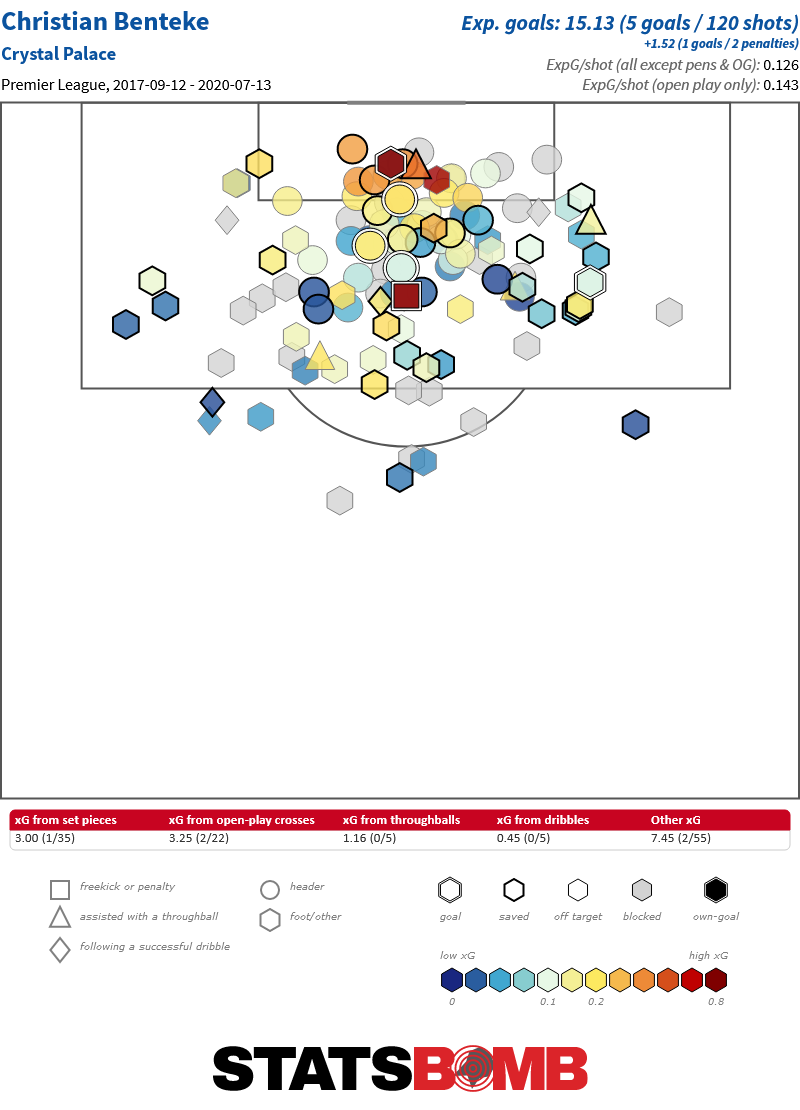
Jordan Ayew scored nine league goals and remains one of the hardest working forwards around. He ranked second for pressure events and fifth for counterpressures among strikers in the division but eighth and 26th for the volume of team regains recorded as a result of them. He's putting the legwork in, but the team doesn't quite push up enough to enact rewards from that. Only two players broached over a quarter of a goal a game contribution for combined goals and assists, Ayew and er... Jeff Schlupp. Only Benteke exceeded the same rate for expected values but under shot by half, and only he again contributed to more than two and a half shots and key passes per game. Whichever way you look at Palace, either in possession or out of it, their attackers ploughed lonely furrows and scarcely clicked.
With the window likely closing on a sizeable windfall for Zaha, team investment may miss a shot in the arm that could have helped from his departure. They simply have to get younger this window and their first two ventures into the transfer market do finally reflect that as do Hodgson's recent comments:
"We are assembling the pieces of our jigsaw with regard to bringing in some fresh, young players to our squad who will provide the quality and energy we have highlighted as being necessary for us to take the next steps forward."
Firstly, Nathan Ferguson arrived for an as yet undecided fee from West Brom. A versatile defender, he instantly injects youth and promise in to the line up but at 19 years old, ideas towards contribution this season should probably be tempered.
More exciting is the arrival of Eberechi Eze from QPR, for what could be a decent fee, somewhere south of £20m. The Londoner's breakout season saw him notch 14 goals and 7 assists from varied attacking and midfield positions and regularly show up in highlight reels. He is positionally versatile, but frequently occupied the left side--much like Zaha has. How will the attackers all fit together? Zaha did spend time coming from the right in 2019-20 and specifically up front in 2018-19 so it's possible that whoever isn't the left sided starter of the two will find themselves filling different roles in different games, depending on other selection choices (mixing with some combination of one or more of Andros Townsend, Benteke and Ayew too). I'm not going to profess to having seen much of Eze--there's only so much time in the world, even in lockdown--but ideas around why he may have appealed to the Palace dealmakers aren't too far from home. He looks to be slightly more secure on the ball, which is an intriguing boost for an ostensibly flair player and having just turned 22, it's hard not to see his best years as imminent:
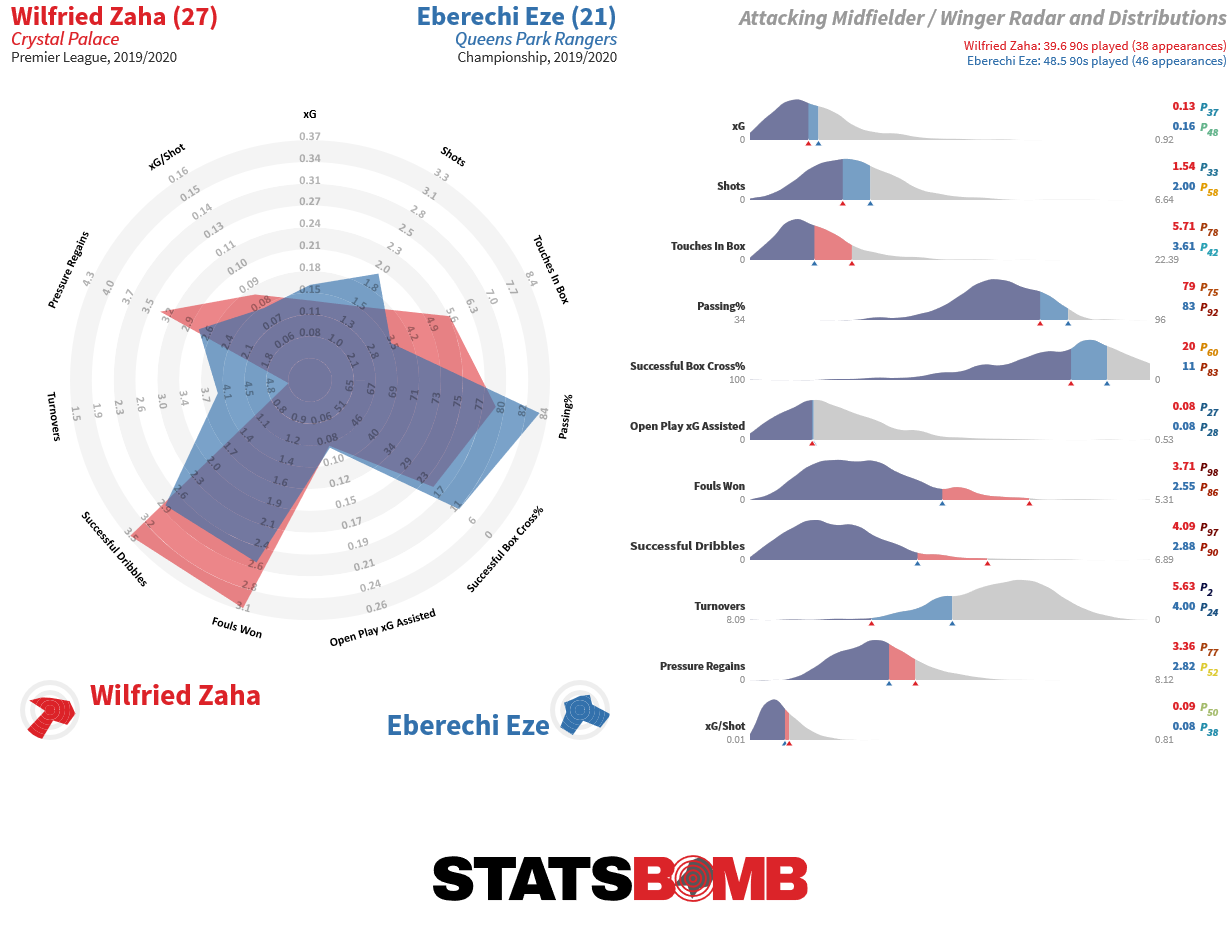
Even then, there is a cautionary side of "what next?" for Eze. A headline of 14 goals and 7 assists look great, but he started every game last season, and once you do the maths, it squares off at around 0.35 goals or assists per game, ahead of an expectation below 0.3. His passing threat is boosted by his set-piece contributions which is both great (useful players to have!) and cautionary (his xG Assisted numbers aren't huge, and shrunk just to open play, er... shrink). He looks fairly pressure resistant too which may help him gel into the side, but he is joining the league's worst attack.
Also likely to arrive is Chelsea loanee Conor Gallagher fresh off a split season with Charlton then Swansea in the Championship. His differing impact across the two tenures are a great example of why data evaluation is only part of any kind of player evaluation. Gallagher's comments here:
"I think at Swansea they have more of the ball than Charlton did, and he [manager Steve Cooper] gave me a chance to create more chances and I think that's why I've got a number of assists for Swansea." are reflected tidily in the numbers:
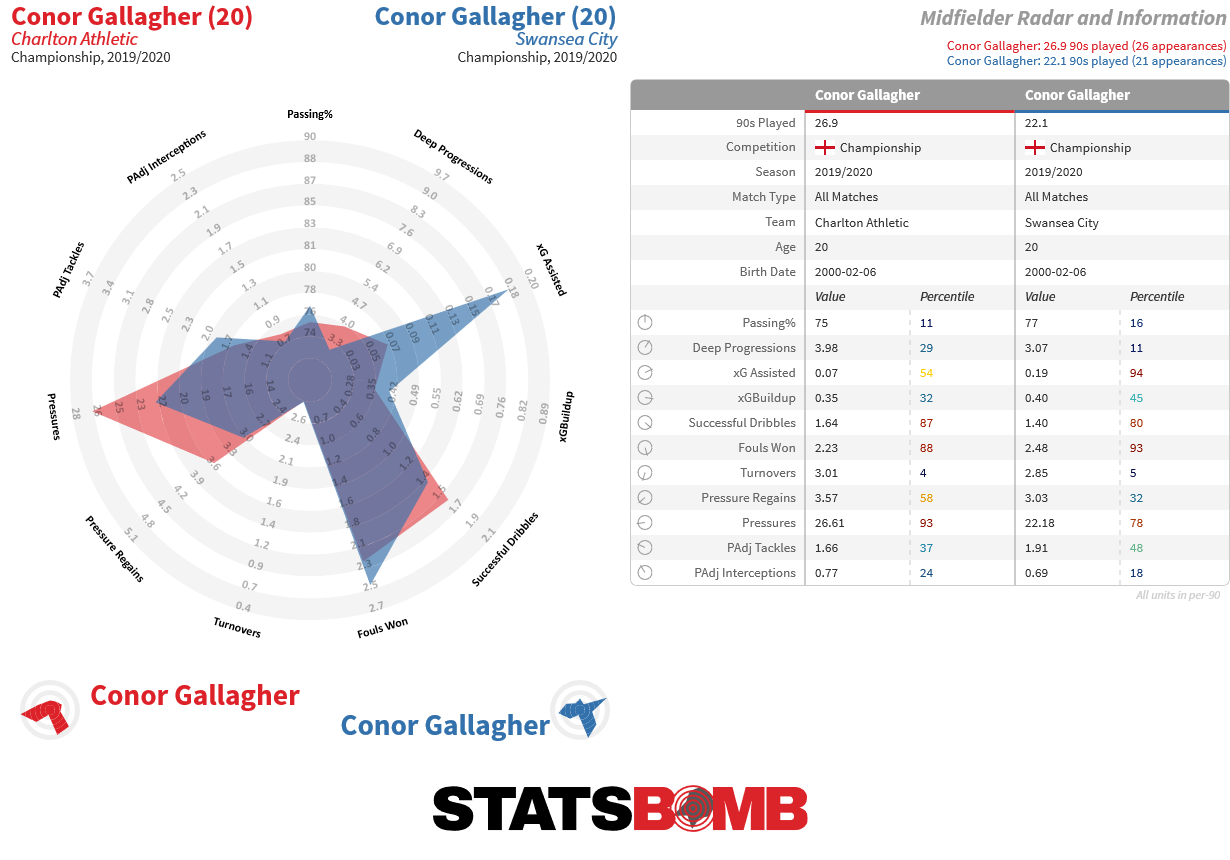
A hard-working youngster, without understanding his more withdrawn role at Charlton, it could be easy to believe he wasn't capable of being an attacking contributor, but empowered at Swansea and pushed more frequently into a central attacking midfield role, passes into the box from open play increased, his throughball rate rose, chances created came and assists followed. He's got genuine ability in front of the box, and there's just enough about him and Eze to wonder if Hodgson is looking at a change of tack and getting a rare central creator into his side.
All evidence is that Eze and Gallagher are talented players, but they could bring their best game, and still find it hard to shine in this team. They will hopefully get ample chance to prove their promise but if the season gets gritty, will Hodgson bunker down?
Projection The gambling community is understandably well aware of the risks surrounding Palace's near term potential and Sporting Index opened up with a sub-40 point, fifth worst projection. Palace have averaged below a point a game in 2020, and won four from 18 in that period. The trending is wrong and it will take distinct and real change to the team's metrics to give them a chance of steering clear of a relegation battle. Hodgson has been in the game long enough to see the warning signs and in most Premier League seasons there are double the amount of teams that perform at a level to put themselves into the relegation mix, so he may like the chances of winning a coin flip. But planning and execution of strategy are what limit risks such as this, and having been reactive rather than proactive in turning over their squad it could well be tough for the club. Offered seventeenth today, you'd have to take it.
If you're a club, media or gambling entity and want to know more about what StatsBomb can do for you, please contact us at Sales@StatsBomb.com We also provide education in this area, so if this taste of football analytics sparked interest, check out our Introduction to Football Analytics course Follow us on twitter in English and Spanish and also on LinkedIn
Tottenham Hotspur: Season Preview 2020-21
Ahead of 2019-20, on the surface, it was relatively easy to be positive about the future for Tottenham. Fresh from another top four finish and a memorable run to the Champions League final, the club had finally secured the future of its midfield by acquiring Giovani Lo Celso on a loan-to-buy deal from Real Betis while Tanguy Ndombélé had arrived for a large fee from Lyon. Sure, the club had no rotation for Harry Kane and their metrics had been declining alarmingly for 18 months, but what could go wrong? A TV show was even commissioned! 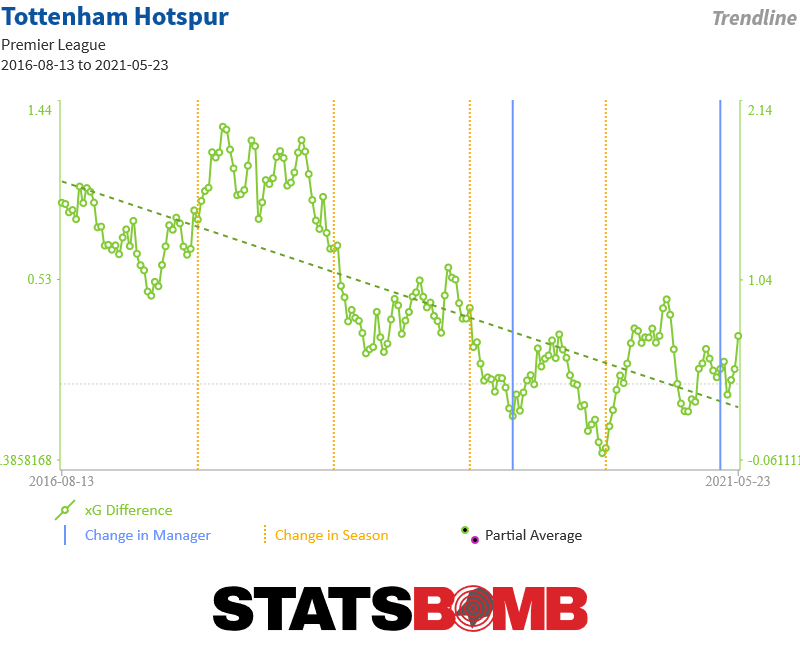 Well, the first thing that went wrong was that the metrics got worse. The second thing that went wrong was the results were terrible. The third thing that went wrong was Mauricio Pochettino was fired. Really, this was all just one large thing that engulfed the club in a manner befitting of a 22-minute segment in a documentary. There was no way around it though, Tottenham had three wins from twelve in the league, had deserved no more from their performances and had been annihilated 7-2 in the Champions League by a promising German side, Bayern Munich. Enter Mourinho. On the surface the 26 league games Mourinho has overseen have been just about good enough. Tottenham got 45 points (65 point pace) which ranked fourth and their goal difference of +13 ranked fourth too. What that conceals is that Mourinho’s tenure has already been through three distinct acts, and the main hope for fans is that the most recent of those acts involved winning more frequently than not. It's also challenging to get used to a Tottenham team that plays very different football to that of the best of Pochettino--and by the time of his departure, despite the Champions League run, that best was a long time passed. Act 1: Duration: 8 games in 2019 Results: 5-1-2 GD: +6 xG: +5 Note: xG Against at 0.65 per game is best in the league The start for Mourinho was promising but didn't come without disappointments. Defeats against his two former clubs, Manchester United (2-1 at Old Trafford in a low event game decided by a Marcus Rashford penalty) and Chelsea (2-0 at home, a Willian penalty sealing the deal soon after renowned hatchet man Son Heung-min was sent off) were classics in the "create nothing, try not to lose" Mourinho canon. Elsewhere the team won five from six before the turn of the new year and certain metrics shone brightly; in defence, the team was giving up very few shots, specifically in good, central dangerous locations. Occasional penalties apart, Tottenham were repelling all. Yes, the schedule was quite kind, but there was a win over Wolves in there too alongside more straightforward victories against lower ranked teams such as Burnley, West Ham, Brighton and Bournemouth. Something to build on? Act 2: Duration: 9 games in a world gradually learning about coronaviruses Results: 3-2-4 GD: +0 xG: -5 Note: xG Against at 1.82 per game is second worst in the whole league The second act was not-so-good. In fact it was downright bad. The schedule bit a little with defeats against Southampton (1-0, created nothing), Liverpool (1-0, played surprisingly well, at least in the second half), Chelsea (again 2-1, this time created nothing, deserved nothing) and Wolves (3-2, overpowered late on, gave it away). There was also a 2-0 win against Manchester City which was as equally improbable as the 2-2 draw earlier in the season at the Etihad. In both games City did enough to win multiple games but somehow couldn't get anything to stick. But the underlying concern came in the same form that had looked so promising weeks before. The defence faltered horribly, moving from league best to nearly league worst and in every one of these nine games Tottenham allowed xG worth between 1.4 to 3.7 per game. They didn't have a single defensively secure game all through and were averaging 16 shots per game against. Really grim stuff. Tottenham also departed the Champions League after being significantly worse than RB Leipzig and lost in the FA Cup on penalties to Norwich, the kind of result that is hard to explain away when you know, deep down, the manager would like to nab a trophy and quick. When the curtains came down on football, they had lost five out of six, and were limping along having been left weakened by injuries to key men such as Kane and Son. Act 3: Duration: 9 games, summer is here and so is your Premier League finale Results: 5-3-1 GD: +7 xG: -2 Note: xG For is 15th, xG Against is 6th Turns out a three month break does wonders for the health of a squad! With Kane and Son back fit, the back end of 2019-20 held a degree of promise. Results were generally good. Performances were... less so. The 0-0 with Bournemouth was about as poorly as Tottenham have played in memory, with the Sheffield United defeat not far behind. Tottenham's attack created very little during this spell: in six of nine games the took ten or fewer shots or failed to create more than one expected goal. To brazenly defy expected goals they also took the lead three times via an own goal. The only game in which the result happily matched expectation was the 2-1 derby win over Arsenal. The defence was sturdier--in four of nine games the expected goals allowed was less than one--and in two further games it was just a shade over. Overall, it's impossible to be analytically inclined and generally happy with how performances have developed across the Mourinho reign, but the better post-break results certainly eased pressure that had been building, even this quickly into his tenure. Style Undoubtedly the style of play is very different. After five hard years, the Pochettino press had already somewhat waned a deal of time before his departure:
Well, the first thing that went wrong was that the metrics got worse. The second thing that went wrong was the results were terrible. The third thing that went wrong was Mauricio Pochettino was fired. Really, this was all just one large thing that engulfed the club in a manner befitting of a 22-minute segment in a documentary. There was no way around it though, Tottenham had three wins from twelve in the league, had deserved no more from their performances and had been annihilated 7-2 in the Champions League by a promising German side, Bayern Munich. Enter Mourinho. On the surface the 26 league games Mourinho has overseen have been just about good enough. Tottenham got 45 points (65 point pace) which ranked fourth and their goal difference of +13 ranked fourth too. What that conceals is that Mourinho’s tenure has already been through three distinct acts, and the main hope for fans is that the most recent of those acts involved winning more frequently than not. It's also challenging to get used to a Tottenham team that plays very different football to that of the best of Pochettino--and by the time of his departure, despite the Champions League run, that best was a long time passed. Act 1: Duration: 8 games in 2019 Results: 5-1-2 GD: +6 xG: +5 Note: xG Against at 0.65 per game is best in the league The start for Mourinho was promising but didn't come without disappointments. Defeats against his two former clubs, Manchester United (2-1 at Old Trafford in a low event game decided by a Marcus Rashford penalty) and Chelsea (2-0 at home, a Willian penalty sealing the deal soon after renowned hatchet man Son Heung-min was sent off) were classics in the "create nothing, try not to lose" Mourinho canon. Elsewhere the team won five from six before the turn of the new year and certain metrics shone brightly; in defence, the team was giving up very few shots, specifically in good, central dangerous locations. Occasional penalties apart, Tottenham were repelling all. Yes, the schedule was quite kind, but there was a win over Wolves in there too alongside more straightforward victories against lower ranked teams such as Burnley, West Ham, Brighton and Bournemouth. Something to build on? Act 2: Duration: 9 games in a world gradually learning about coronaviruses Results: 3-2-4 GD: +0 xG: -5 Note: xG Against at 1.82 per game is second worst in the whole league The second act was not-so-good. In fact it was downright bad. The schedule bit a little with defeats against Southampton (1-0, created nothing), Liverpool (1-0, played surprisingly well, at least in the second half), Chelsea (again 2-1, this time created nothing, deserved nothing) and Wolves (3-2, overpowered late on, gave it away). There was also a 2-0 win against Manchester City which was as equally improbable as the 2-2 draw earlier in the season at the Etihad. In both games City did enough to win multiple games but somehow couldn't get anything to stick. But the underlying concern came in the same form that had looked so promising weeks before. The defence faltered horribly, moving from league best to nearly league worst and in every one of these nine games Tottenham allowed xG worth between 1.4 to 3.7 per game. They didn't have a single defensively secure game all through and were averaging 16 shots per game against. Really grim stuff. Tottenham also departed the Champions League after being significantly worse than RB Leipzig and lost in the FA Cup on penalties to Norwich, the kind of result that is hard to explain away when you know, deep down, the manager would like to nab a trophy and quick. When the curtains came down on football, they had lost five out of six, and were limping along having been left weakened by injuries to key men such as Kane and Son. Act 3: Duration: 9 games, summer is here and so is your Premier League finale Results: 5-3-1 GD: +7 xG: -2 Note: xG For is 15th, xG Against is 6th Turns out a three month break does wonders for the health of a squad! With Kane and Son back fit, the back end of 2019-20 held a degree of promise. Results were generally good. Performances were... less so. The 0-0 with Bournemouth was about as poorly as Tottenham have played in memory, with the Sheffield United defeat not far behind. Tottenham's attack created very little during this spell: in six of nine games the took ten or fewer shots or failed to create more than one expected goal. To brazenly defy expected goals they also took the lead three times via an own goal. The only game in which the result happily matched expectation was the 2-1 derby win over Arsenal. The defence was sturdier--in four of nine games the expected goals allowed was less than one--and in two further games it was just a shade over. Overall, it's impossible to be analytically inclined and generally happy with how performances have developed across the Mourinho reign, but the better post-break results certainly eased pressure that had been building, even this quickly into his tenure. Style Undoubtedly the style of play is very different. After five hard years, the Pochettino press had already somewhat waned a deal of time before his departure: 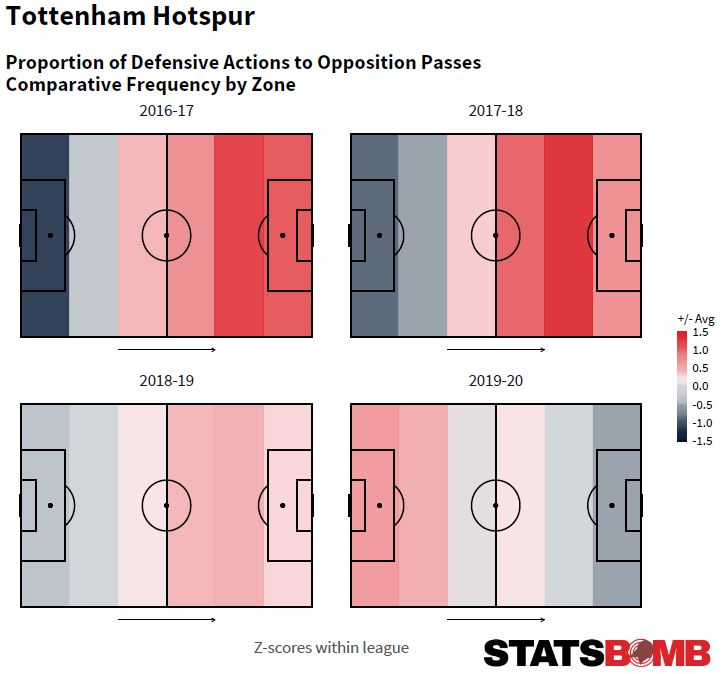 Despite clear mentions of pressing in the Amazon documentary, it doesn't really come out in the metrics. Tottenham may still work hard, but not as high up the pitch as before. The signing of Steven Bergwijn defines what Mourinho wants from his non-Kane attackers. Quick and able to stretch defences especially on the break, Bergwijn's talents categorise neatly alongside Lucas Moura and Son. Midfield has been a problem for Tottenham for a number of seasons, and Mourinho's solution was somewhat creative: try to bypass it.
Despite clear mentions of pressing in the Amazon documentary, it doesn't really come out in the metrics. Tottenham may still work hard, but not as high up the pitch as before. The signing of Steven Bergwijn defines what Mourinho wants from his non-Kane attackers. Quick and able to stretch defences especially on the break, Bergwijn's talents categorise neatly alongside Lucas Moura and Son. Midfield has been a problem for Tottenham for a number of seasons, and Mourinho's solution was somewhat creative: try to bypass it. 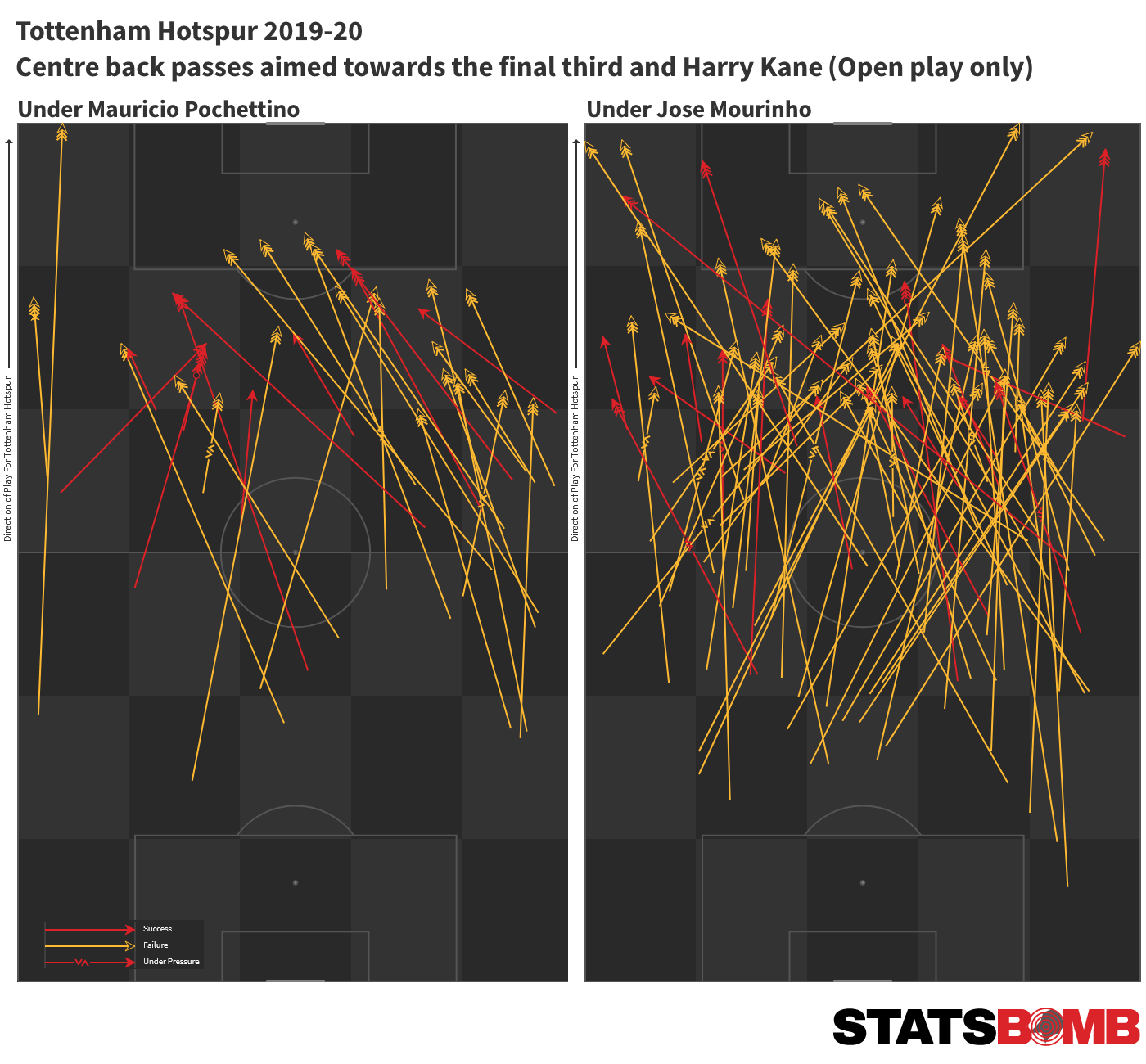 The change here from the steadier possession game deployed by Pochettino to a more direct targeted passing system was notable. The graphic shows balls aimed at Kane from centre backs in open play, and this type of pass went from three per game under Pochettino with a huge skew towards Alderweireld (over two-thirds of these passes were from him) to over five per game under Mourinho, with all the centre backs looking for this ball. The other attackers saw a similar uptick in receiving targeted long passes too, with Son, Lucas and eventually Bergwijn under Mourinho combining to receive nearly six of these passes per game up from three, and again a large skew away from just Alderweireld towards all centre backs. Both goalkeepers looked for similar out balls too, with a large rise in any keeper clearance (dead ball or otherwise) aimed at the forwards. This is also where the signing of Matt Doherty is interesting, as he's shown himself to be well capable in competing for long, high balls and taking up an advanced position -- Serge Aurier already takes up similar roles but hasn't the aerial prowess to dominate opposing full backs. Doherty may well be able to do this and provide flicks and nod downs, to help release Tottenham's speedy forwards. It's not total football, but it could well be part of the Mourinho plan. Personnel The eternal dance at Tottenham between Chairman Daniel Levy and incumbent managers regarding player acquisition appears so far to not be taking place with Mourinho. Players that have been recruited are not wildly expensive or apparently indulgent and may well be better than the raw detail suggests. The talent within the Tottenham squad is impossible to deny, from World Cup winner Hugo Lloris in goal right through to Kane up front. But supporting roles have waned over time, and the signings of Pierre-Emile Højbjerg and Doherty in particular, appear to show the intent to solidify key positions to perhaps allow the gifted attackers to flourish. There are distinct "do everything, but just a bit" vibes to Højbjerg's metrics in particular, but perhaps that's what this team needs: consistency and stability.
The change here from the steadier possession game deployed by Pochettino to a more direct targeted passing system was notable. The graphic shows balls aimed at Kane from centre backs in open play, and this type of pass went from three per game under Pochettino with a huge skew towards Alderweireld (over two-thirds of these passes were from him) to over five per game under Mourinho, with all the centre backs looking for this ball. The other attackers saw a similar uptick in receiving targeted long passes too, with Son, Lucas and eventually Bergwijn under Mourinho combining to receive nearly six of these passes per game up from three, and again a large skew away from just Alderweireld towards all centre backs. Both goalkeepers looked for similar out balls too, with a large rise in any keeper clearance (dead ball or otherwise) aimed at the forwards. This is also where the signing of Matt Doherty is interesting, as he's shown himself to be well capable in competing for long, high balls and taking up an advanced position -- Serge Aurier already takes up similar roles but hasn't the aerial prowess to dominate opposing full backs. Doherty may well be able to do this and provide flicks and nod downs, to help release Tottenham's speedy forwards. It's not total football, but it could well be part of the Mourinho plan. Personnel The eternal dance at Tottenham between Chairman Daniel Levy and incumbent managers regarding player acquisition appears so far to not be taking place with Mourinho. Players that have been recruited are not wildly expensive or apparently indulgent and may well be better than the raw detail suggests. The talent within the Tottenham squad is impossible to deny, from World Cup winner Hugo Lloris in goal right through to Kane up front. But supporting roles have waned over time, and the signings of Pierre-Emile Højbjerg and Doherty in particular, appear to show the intent to solidify key positions to perhaps allow the gifted attackers to flourish. There are distinct "do everything, but just a bit" vibes to Højbjerg's metrics in particular, but perhaps that's what this team needs: consistency and stability. 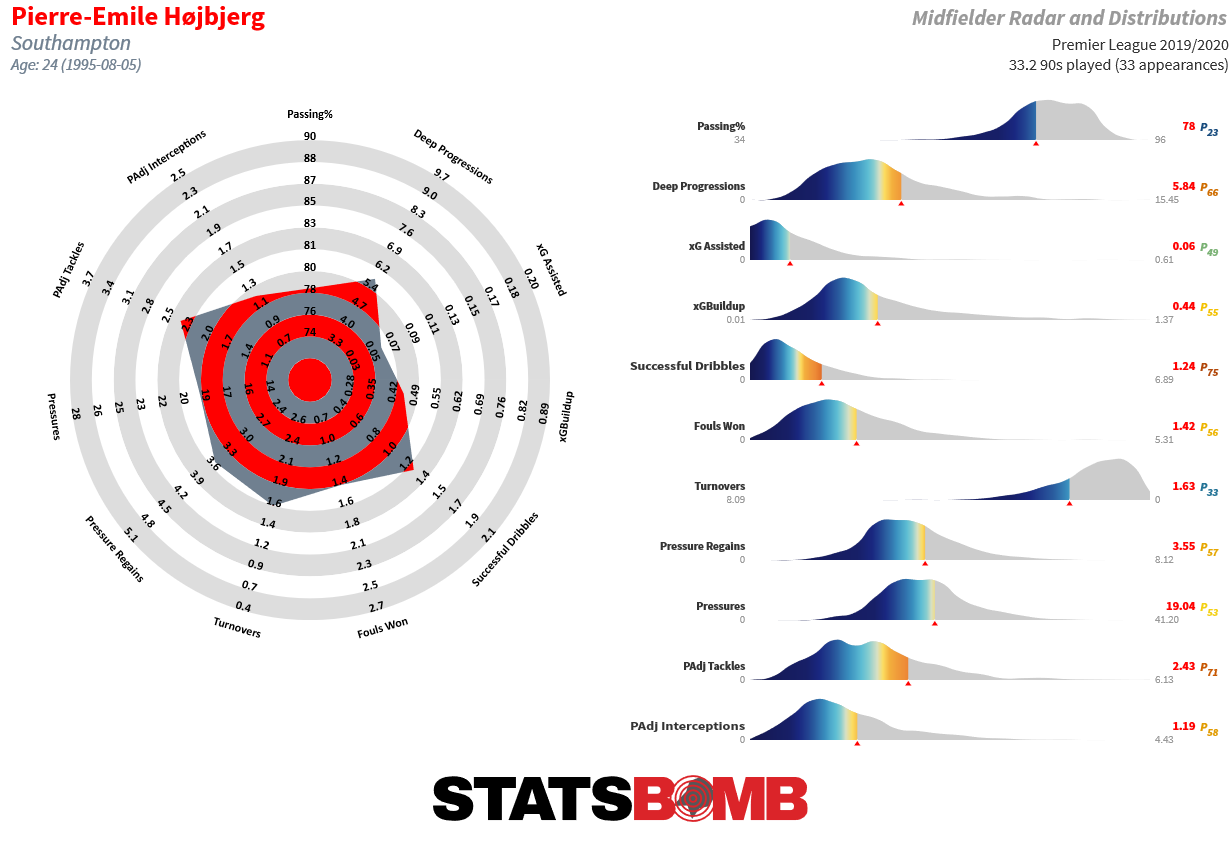 Will it work? Getting Højbjerg in as a likely guaranteed starter means we're unlikely to see Harry Winks and Moussa Sissoko start many games together with Giovani Lo Celso already the passing heartbeat of the side picked ahead of them. Doherty's arrival allows Aurier to depart and locks down one position. The attacking midfield band is rich with Dele Alli, Bergwijn, Moura, Son and Erik Lamela competing for a maximum of three positions. What of Tanguy Ndombélé? I'll plead the fifth, thanks. It's possible that the Frenchman's inability to nail down a starting place is indicative of the slightly altered transfer focus, as his signing combined with an investment in Jack Clarke and Ryan Sessegnon that is a long way off bearing fruit means £100m of summer 2019 purchases are not yet directly impacting the first team. Doherty and Højbjerg scope out at around £30m (and books are balancing a little more once Kyle Walker-Peters' departure is factored in) and will likely play every week. Getting purchases into the team and contributing counts for a lot. There are noises that more players could arrive, most notably a rotational striker, but in Covid-19 world, it's likely to be more book-balancing than big purchases, so it also depends who is on the outs. With football finishing only a month ago, we have fresh answers to long term questions. Whether Kane could refind something near to his best form after a six month break to recover from his latest injury appeared to be answered in the affirmative by a tidy finishing streak. To the casual eye he looked more dynamic than before, and whatever the truth is of his long term mobility and the impact of injuries on him, the work that he's put into his finishing over the course of many years will likely carry him well into his latter career. It's also possible that there's a bias generated in seeing him score three goals from five throughball shots as it's never been an area in which he's been wildly prolific (10 goals from 31 such shots in the league across the previous four seasons). Still: at 2.5 shots per 90, albeit for a ten shot a game team, he needs the finishing to stay sharp to get the totals up and mini runs such as this will not persist long term:
Will it work? Getting Højbjerg in as a likely guaranteed starter means we're unlikely to see Harry Winks and Moussa Sissoko start many games together with Giovani Lo Celso already the passing heartbeat of the side picked ahead of them. Doherty's arrival allows Aurier to depart and locks down one position. The attacking midfield band is rich with Dele Alli, Bergwijn, Moura, Son and Erik Lamela competing for a maximum of three positions. What of Tanguy Ndombélé? I'll plead the fifth, thanks. It's possible that the Frenchman's inability to nail down a starting place is indicative of the slightly altered transfer focus, as his signing combined with an investment in Jack Clarke and Ryan Sessegnon that is a long way off bearing fruit means £100m of summer 2019 purchases are not yet directly impacting the first team. Doherty and Højbjerg scope out at around £30m (and books are balancing a little more once Kyle Walker-Peters' departure is factored in) and will likely play every week. Getting purchases into the team and contributing counts for a lot. There are noises that more players could arrive, most notably a rotational striker, but in Covid-19 world, it's likely to be more book-balancing than big purchases, so it also depends who is on the outs. With football finishing only a month ago, we have fresh answers to long term questions. Whether Kane could refind something near to his best form after a six month break to recover from his latest injury appeared to be answered in the affirmative by a tidy finishing streak. To the casual eye he looked more dynamic than before, and whatever the truth is of his long term mobility and the impact of injuries on him, the work that he's put into his finishing over the course of many years will likely carry him well into his latter career. It's also possible that there's a bias generated in seeing him score three goals from five throughball shots as it's never been an area in which he's been wildly prolific (10 goals from 31 such shots in the league across the previous four seasons). Still: at 2.5 shots per 90, albeit for a ten shot a game team, he needs the finishing to stay sharp to get the totals up and mini runs such as this will not persist long term: 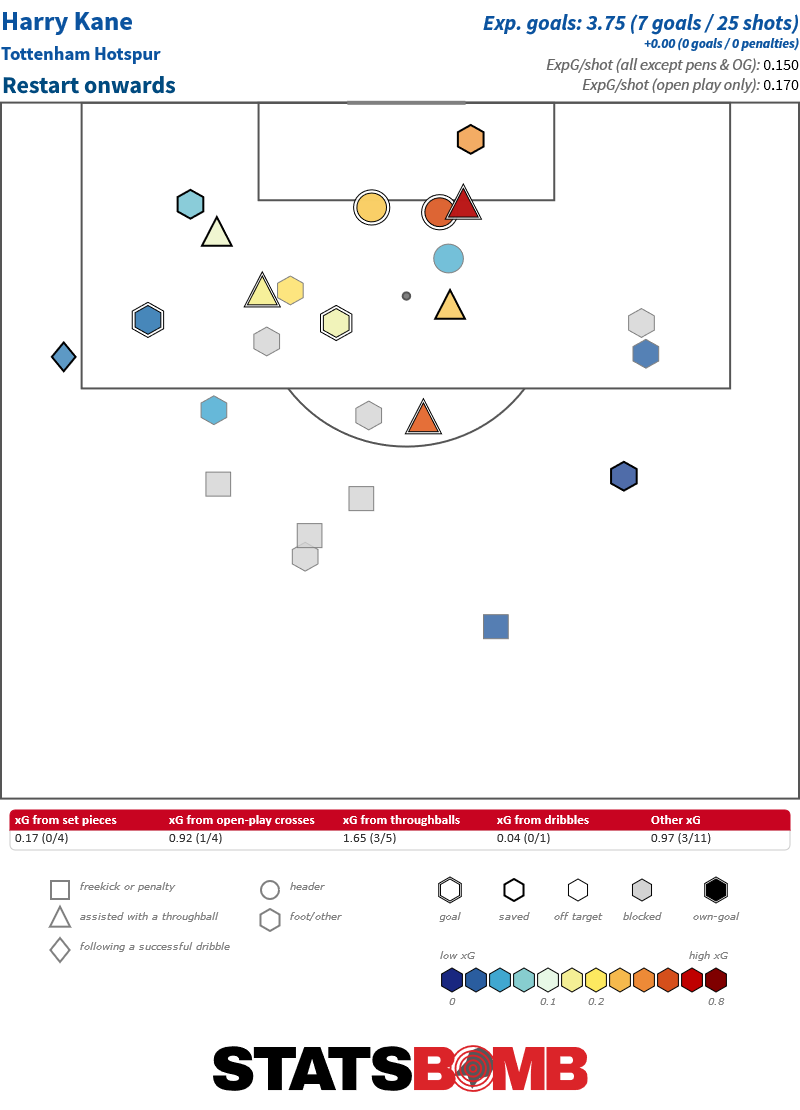 As important is the form of Son. A beacon of consistency in the aggregate throughout the good times, and not-so-good times, he has now registered four consecutive seasons oscillating close to a combined 0.7 per 90 for goals and assists, most usually ahead of expectation thanks to his versatile finishing. He can blow hot and cold at times from week to week, but when on-song, is as devastating an attacking midfielder as there is in the league:
As important is the form of Son. A beacon of consistency in the aggregate throughout the good times, and not-so-good times, he has now registered four consecutive seasons oscillating close to a combined 0.7 per 90 for goals and assists, most usually ahead of expectation thanks to his versatile finishing. He can blow hot and cold at times from week to week, but when on-song, is as devastating an attacking midfielder as there is in the league: 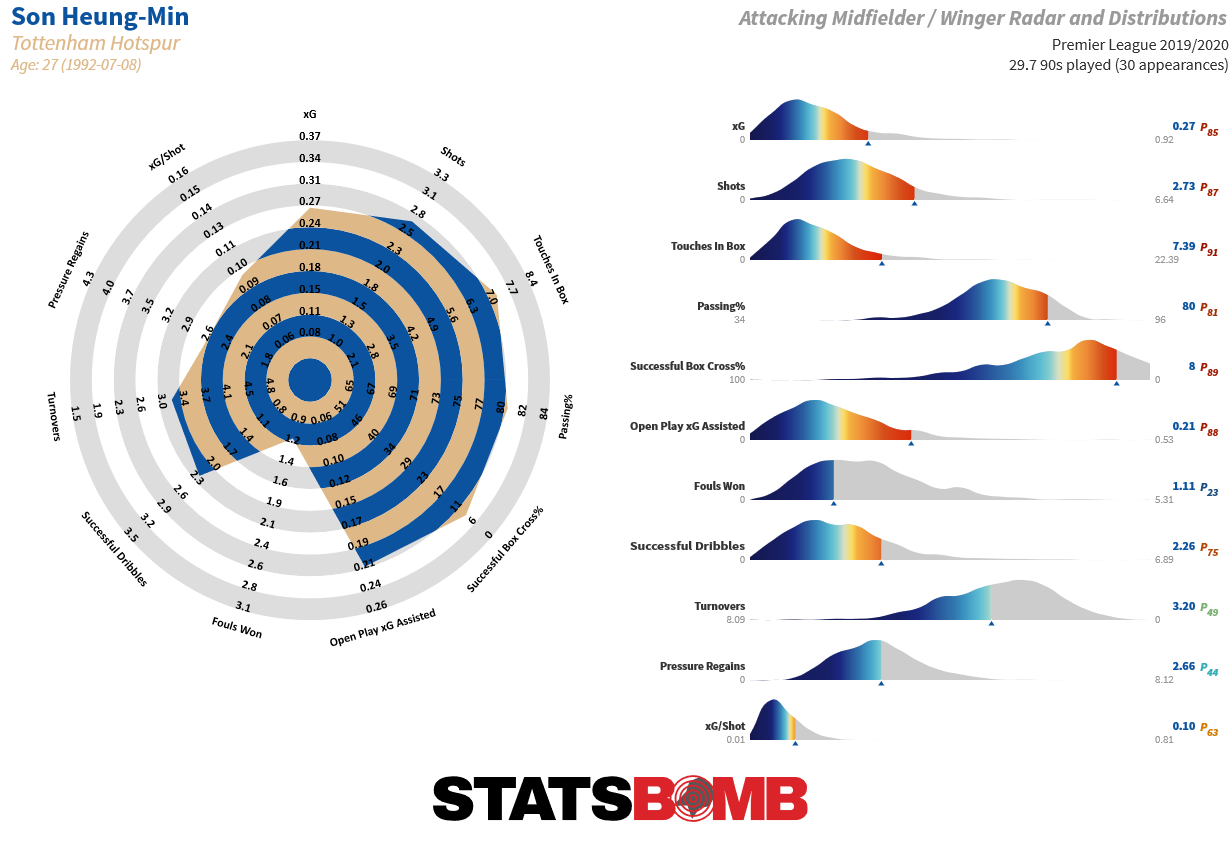 Projection Everything from a metric perspective at Tottenham has pointed downwards since the end of 2017-18, so the first thing to try and do is reverse that slide. Can Mourinho do that? His Zlatan-powered first Manchester United season was a legitimately dominant shooting team with a finishing problem, so there's a blueprint to get to a position of strength. The following season United finished second with 81 points despite less impressive metrics and season three is a well worn trail now. It's just about possible to give the benefit of the doubt and offer a pass for 2019-20 given weird circumstances and a mid-season appointment, but Tottenham will need to start well to keep any goodwill in the tank, and the Amazon documentary is dropping and building a whole new set of memes and storylines just as this season emerges. It's the Jose Mourinho Show again, and he needs to show he can still provide an above average return for his salary. Mourinho-era metrics don't yet offer solid encouragement, given how variable they have been. Teams with minus expected goal differences and minus shot counts simply don't earn high league positions in this league. The Sporting Index projection has Arsenal and Tottenham in the fifth and sixth slots, but no more than a result or two from below and significantly further away from Chelsea and Manchester United in the backend of the top four. Somewhere in the top four does represent the very best outcome, and a plan realised, but it is not the most likely outcome at all. However, if Tottenham can improve metrics and somehow stay in range of such an outcome deep into the season, all good, if not, then the Mourinho project may founder ahead of any expected three year timeline.
Projection Everything from a metric perspective at Tottenham has pointed downwards since the end of 2017-18, so the first thing to try and do is reverse that slide. Can Mourinho do that? His Zlatan-powered first Manchester United season was a legitimately dominant shooting team with a finishing problem, so there's a blueprint to get to a position of strength. The following season United finished second with 81 points despite less impressive metrics and season three is a well worn trail now. It's just about possible to give the benefit of the doubt and offer a pass for 2019-20 given weird circumstances and a mid-season appointment, but Tottenham will need to start well to keep any goodwill in the tank, and the Amazon documentary is dropping and building a whole new set of memes and storylines just as this season emerges. It's the Jose Mourinho Show again, and he needs to show he can still provide an above average return for his salary. Mourinho-era metrics don't yet offer solid encouragement, given how variable they have been. Teams with minus expected goal differences and minus shot counts simply don't earn high league positions in this league. The Sporting Index projection has Arsenal and Tottenham in the fifth and sixth slots, but no more than a result or two from below and significantly further away from Chelsea and Manchester United in the backend of the top four. Somewhere in the top four does represent the very best outcome, and a plan realised, but it is not the most likely outcome at all. However, if Tottenham can improve metrics and somehow stay in range of such an outcome deep into the season, all good, if not, then the Mourinho project may founder ahead of any expected three year timeline.
If you're a club, media or gambling entity and want to know more about what StatsBomb can do for you, please contact us at Sales@StatsBomb.com We also provide education in this area, so if this taste of football analytics sparked interest, check out our Introduction to Football Analytics course Follow us on twitter in English and Spanish and also on LinkedIn
